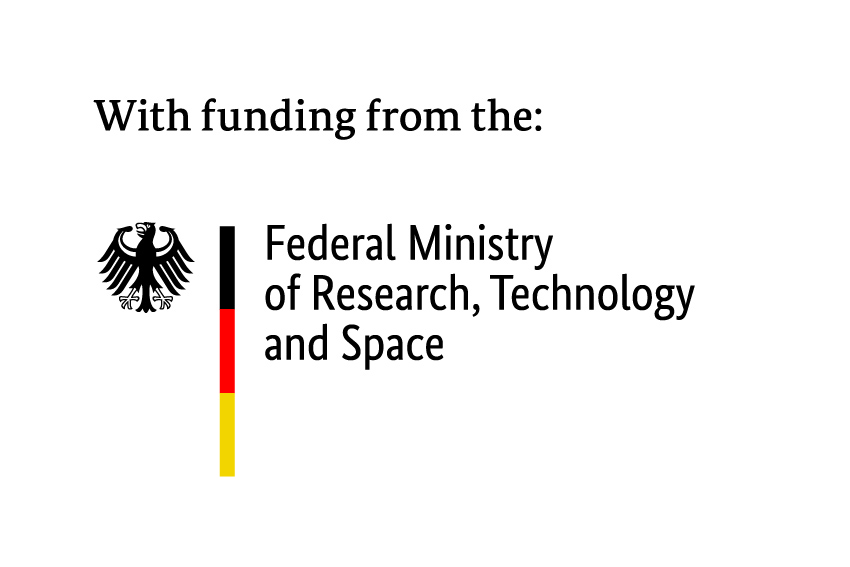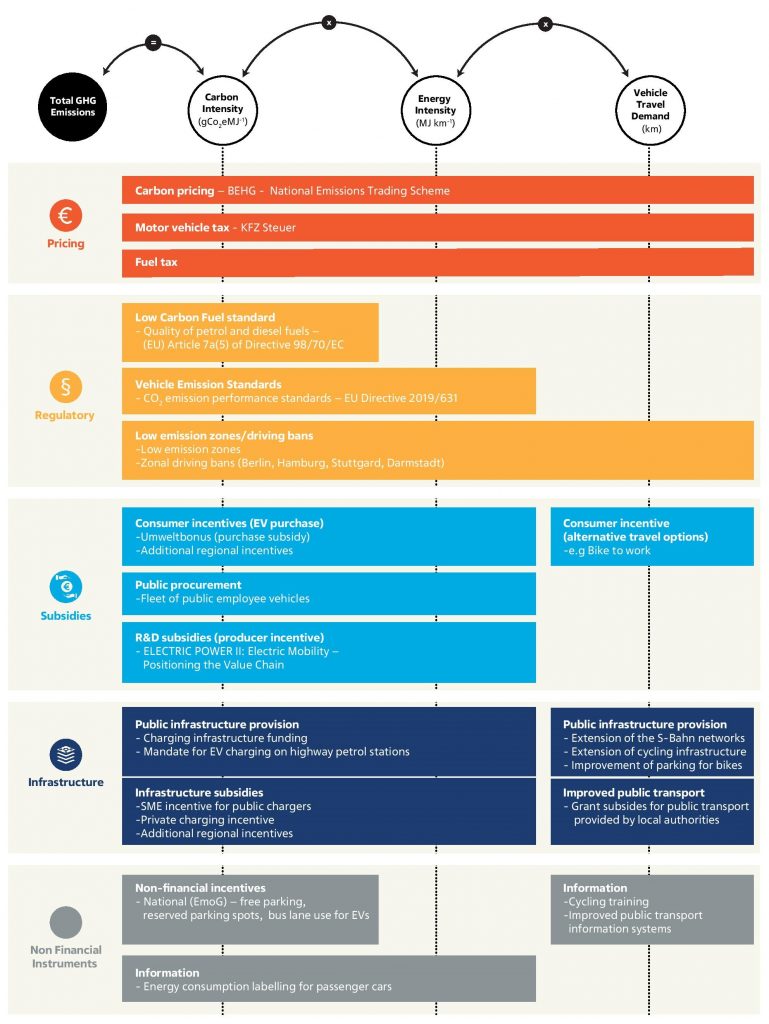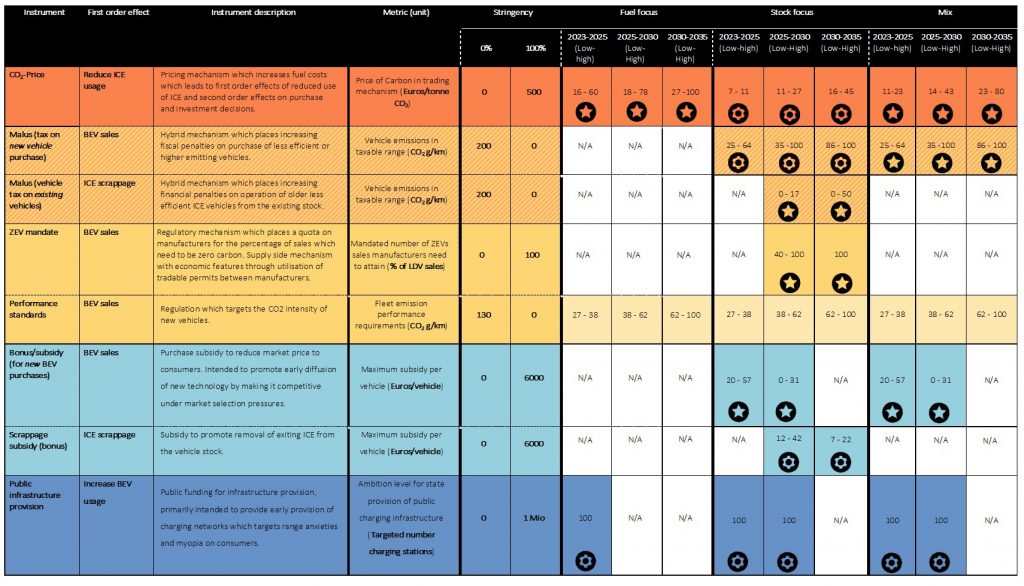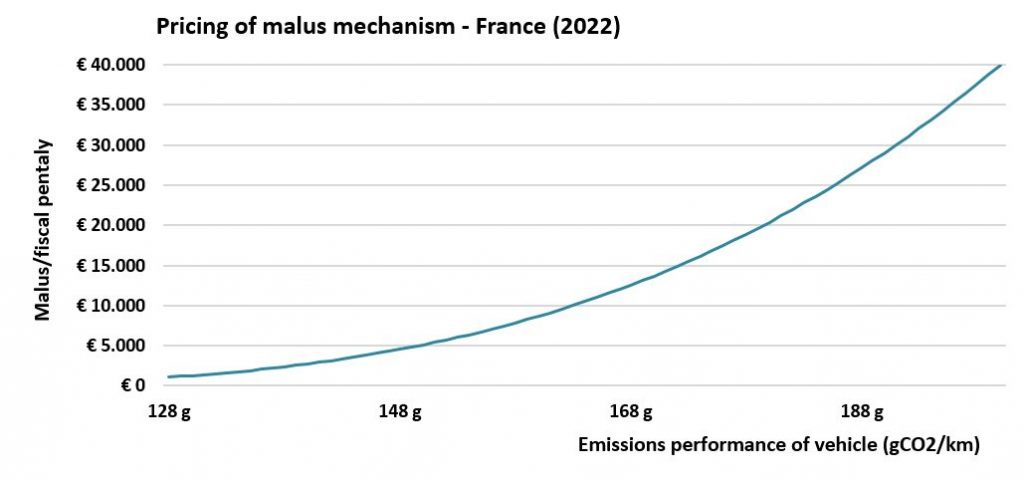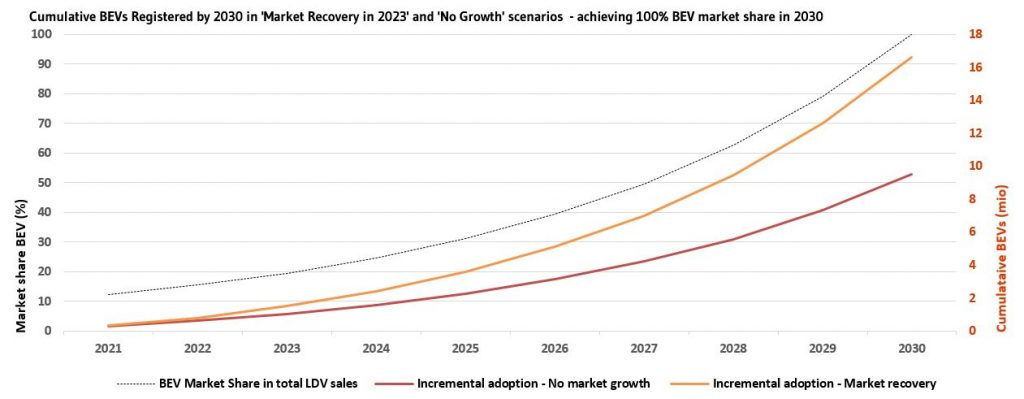Summary
We introduce and test a novel design and assessment framework for climate policy mix pathways and use it to construct and assess alternative policy pathways offering increased ambition of Greenhouse Gas (GHG) abatement in Germany’s light duty vehicle (LDV) sector. The main novelty of the approach is a strong focus on temporality, starting from the observation that net zero GHG transitions undergo different stages with different challenges, and therefore different policy approaches are needed as the transitions in different sectors mature. We emphasise policies which not only support the emergence of novel technologies, but also phase out GHG-intensive technology stocks. We focus on the transition from internal combustion engine (ICE) to battery-electric vehicles (BBEV) (“Antriebswende”) to keep the analysis tractable, but recognize the need for a broader mobility transition including e.g. modal shift.
Our approach is dynamic, with the temporality of policy mix design at the core of its logic. Our first temporal design element is that transitions undergo different phases requiring different types of policy interventions. As a transition shifts from an emergence to the diffusion phase (as we argue currently applies to the LDV sector in Germany), policy support needs to shift from fostering the development of new technologies to enabling significantly increased diffusion rates. This includes increasing the stringency of climate policies (e.g. level and rate of increase of carbon pricing) in line with GHG and other related targets, and addressing relevant externalities in this phase (e.g. in the expansion of public charging infrastructure). Policy interventions also need to increasingly foster the phasing out of ICE vehicles from the overall fleet, through regulating or pricing of carbon intensive fuels or the existing ICE stock. We utilize a comparative policy stringency approach, which allows us to characterize dynamic sequencing of the policy pathway designs, as they co-evolve with the changing transition dynamics.
We highlight the need to actively phase out existing carbon emitting technologies, along with supporting diffusion of emergent sustainable alternatives. We argue that in order to meet ambitious environmental targets, policy pathways need to include instruments which actively place pressure on the existing carbon emitting technologies, to accelerate the rate at which the overall stock turns over. This can be achieved through stringent pricing or regulation, or hybrid combinations of the two (instruments with regulatory and pricing components). This becomes increasingly important as the transition is in the diffusion stage, but these kinds of policies are commonly met with more resistance since they change asset (vehicle) values and force behavioural change and may induce socio-economic impacts which could be regressive if not addressed though anticipatory design.
We identify key intertemporal challenges for LDV transitions that policy mix pathways need to address. Policy mix design needs to address six key challenges to successfully drive the LDV sector transition: Environmental effectiveness, cost effectiveness, fiscal costs, distributional effects, political feasibility and governance requirements. We unpack these challenges into sub-components, and related key considerations, drawing on evidence from relevant transport policy literatures. These challenges also serve as ex ante assessment criteria in iteratively designing and evaluating alternative future policy mix pathways.
We focus on climate policy instruments that can affect three key consumer decisions driving the LDV transition: scrappage of ICE vehicles, new LDV purchases, and the use of the existing (ICE) vehicle stock. The transition dynamics towards less GHG emissions can be disaggregated into stock turnover (ICE vehicle scrappage and introduction of new BEV) and changes in the use of the existing ICE vehicle stock. Policy instruments can target these dynamics either directly (first order effect) or indirectly (second order effect). Second order effects can refer to expected costs and benefits of vehicle use which incentivize behavioral change, thus influencing purchase/scrappage decisions. Similarly, more availability of charging infrastructure directly affects the usage of existing stock, but also has learning and spillover effects which influence consumer choices for BEV purchases and scrappage of ICE. Second order effects can also refer to manufacturers investment decisions in developing new model generations, which in turn lead to changes in prices and performance, and therefore influence consumer purchase/scrappage decisions. Manufacturers’ decisions will be influenced by expectations about consumer behavior and broader market developments (e.g. cost developments of batteries), and the credibility of the policy mix pathway in place. Due to the prevalence of market failures, especially second order effects may not function perfectly, e.g, hinder cost effectiveness, which might in turn require additional instruments. As high complexity of a policy mix bears increased risk such as unexpected outcomes and need for (error-prone) frequent adjustments of the policy mix by policymakers, a key consideration in our dynamic design is striking the right balance between sufficiently targeting market failures and political feasibility challenges, and reducing complexity of the policy mix. Figure 1 displays key consumer decisions related market failures, and key policy instruments.
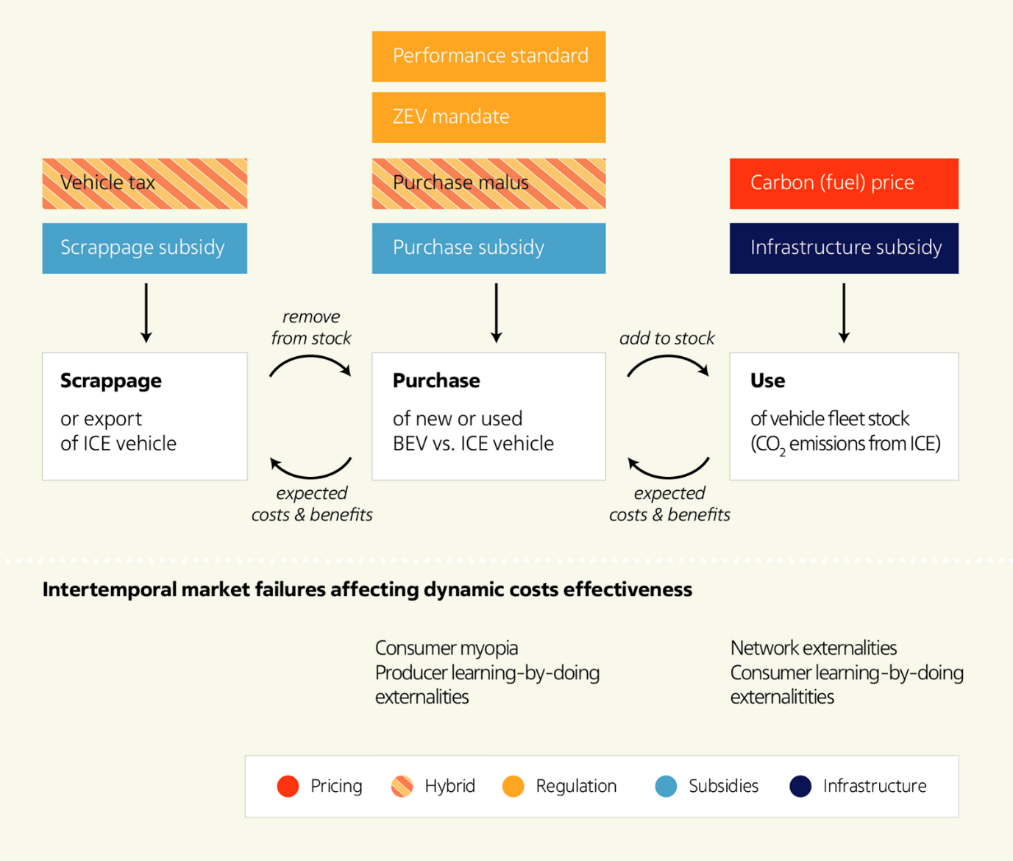
We use our approach to compare the stringency of policy instruments over time across different future policy pathways, first reconstructing the status quo policy pathway in Germany, including the EU commissions’ Fit For 55 proposals. We identify the main components of the current policy mix pathway for LDVs in Germany. We represent the stringency of each policy instrument over time in a way that is comparable across different policy instrument pathway scenarios.
Our qualitative assessment suggests that the status quo policy mix pathway in Germany is likely insufficient to contribute to delivering the 2030 transport sector greenhouse gas and BEV targets. The current policy mix is not suited to supporting the required next steps of the large-scale transformation, as the market share of BEVs needs to increase substantially. The current policy mix relies mostly on purchase subsidies which have been associated with an increase in market adoption of BEVs. Continued reliance on this policy mix to support the transition would be expensive in fiscal terms though. The current carbon (fuel) price level and trajectory as well as vehicle fleet CO2-efficiency standards are relatively unambitious, and unless scaled up and/or reformed, it is not plausible that sector GHG targets up to 2030 will be achieved.
We then propose and qualitatively assess three alternate policy mix pathways which promise to enable the achievement of 2030 GHG and BEV targets. We label these pathways “Fuel focused carbon pricing (fuel focus)”, “Stock focused carbon pricing (stock focus)” and ”Mixed sequential carbon pricing (Mix)”. They assume identical GHG mitigation and BEV target attainment towards 2030, and identical uncertainties over cost developments of BEV and ICE but differ in the means to achieve the GHG targets. While we construct these pathways with a view to reflecting stylized positions in the policy debate, we suggest designs that based on transport policy and economics literature would be optimal in terms of maximizing attainment of the different evaluation criteria (e.g. minimize costs and expected political opposition over time).
While the pathways differ in their focus on and timing of using pricing instruments either for the GHG contained in fuels, or the GHG intensity of new and existing vehicle technologies, they have in common a utilisation of mainly pricing instruments rather than direct regulation as core instruments in the mix. Prices have the advantage of setting direct economic incentives for changing behaviour in scrappage, purchase and use decisions, while offering flexibility in policy design (e.g. differentiating Malus payments by GHG intensity) and for producers and consumers of vehicles. They also raise revenue, and therefore each alternate policy mix pathway involves a considerably lower fiscal burden than the baseline, with the main costs associated with infrastructure provision.
Each of the alternate pathways carries different trade-offs and risks among LDV transition challenges. More specifically, key design logics of and risks associated with each pathway are:
The “fuel focused carbon pricing” pathway relies almost exclusively on fuel carbon pricing to drive the transition. It foresees an immediate and significant gasoline and diesel carbon (fuel) price hike, followed by continuous price increases to internalize the CO2 emissions externality and reduce ICE vehicle use and purchases while stimulating ICE vehicle scrappage and a shift towards BEV. Purchase and charging infrastructure subsidies are phased out quickly and the EU vehicle fleet CO2-performance standard becomes non-binding. This pathway faces significant risk of political backlash, e.g. in case low-price elasticities necessitate very high carbon (fuel) prices to achieve targeted emission reductions. Such backlash might lead to a relaxation of GHG targets (or price interventions), thus undermining environmental effectiveness. The current energy price crisis appears to illustrate limited current political acceptance of significantly and rapidly escalating fossil fuel prices, which would very likely be required. In addition, the pathway’s logic relies on limited prevalence of additional challenges such as EV charging network externalities, consumer myopia and learning-by-doing effects. If these effects exist at significant scale, the intertemporal cost effectiveness of this pathway may be hampered, since challenges are not directly addressed by complementary policies like the alternative pathways.
The “stock focused carbon pricing” pathway focuses on policies directly affecting vehicle purchase and scrappage decisions while fuel carbon pricing plays a limited role. This pathway envisages phase-in of an increasingly stringent Zero Emissions Vehicle (ZEV) mandate, a complementary Bonus-Malus policy for new vehicle purchases to mitigate leakage effects under the ZEV mandate, an increasing Malus (annual vehicle tax) on existing ICE vehicles to push these out of the stock over time, as well as sustained EV charging infrastructure support policy. Modest carbon (fuel) pricing has a supportive complementary role to reduce use of the existing internal combustion engine (ICE) vehicle fleet, but this instrument is under-utilized compared to the other pathways. This pathway faces significant governance challenges for achieving dynamic cost effectiveness, requiring correct calibration and repeated dynamic adjustments of a wide range of policy instruments necessitating accurate information and reform decisions on behalf of policymakers. While the instruments targeting scrappage and purchase decisions can internalize several relevant market failures, their primary raison d’etre is achieving emissions reductions. Distributive effects are highly uncertain.
The “mixed sequential carbon pricing” pathway seeks to reduce the main challenges associated with the other two policy pathways by combining a carbon (fuel) price trajectory starting at a moderate level but rising significantly over time with complementary targeted instruments addressing market failures and regulatory challenges initially, which are phased out over time. This pathway follows a sequencing design logic, starting with an initially moderately rising fuel carbon pricing trajectory (thus increasing political feasibility) which scales-up relatively quickly making carbon (fuel) pricing the core instrument in the overall policy mix. Additional instruments aim at curing specific market failures in a targeted way and foster increased BEV diffusion via diverse policy instruments (rather than a single one). These are mainly a Bonus-Malus on new vehicle purchases to address consumer myopia and learning by doing externalities, and by public EV infrastructure (charging stations) policy support to target the potential network failures. The relevance of these companion policies declines as additional market failures become less relevant in future more advanced stages of the LDV transition, and as the carbon (fuel) price increases. The central risk is low initial environmental effectiveness, in particular little initial use reduction of the existing ICE vehicle stock.
Our assessment indicates that combining carbon (fuel) pricing with sufficient complementary instruments to overcome temporary market failures improves dynamic cost effectiveness, and probably also enhances political feasibility. We find that combining carbon fuel pricing with complementary instruments which are sequentially calibrated to the magnitude and timing of market failures likely increases efficiency over a high carbon price alone, depending on the (unknown) magnitude of market failures.
We argue that in addition to market failures, political feasibility is a key consideration in policy pathway design. The sequencing logic combines more accepted instruments to drive BEV purchase decisions, which allows for scaling of less accepted reforms, which target use and scrappage decisions. This logic aims at increasing acceptance of these more controversial policy reforms, particularly an initial substantial hike of carbon (fuel) pricing, which currently is met with significant political resistance. We argue that combination of supportive instruments in the near term allows scaling of carbon (fuel) pricing more gradually, and helps increase acceptance though familiarity and compensation measures, while likely mitigating short term adverse distributional impacts. Accordingly, there are welfare benefits from designing a more politically feasible policy pathway, as having ambitious climate policy enacted yields greater benefit than pursuing the most cost effective option not implemented due to lack of supporting political coalition. A major challenge of this approach is to correctly empirically specify which policy mix options and instrument stringencies will be feasible, given the multiple and highly uncertain factors determining this important variable.
We identify key current uncertainties and gaps in existing research, which are important areas for further research. More research is needed to help further develop policy pathway construction and assessment in the LDV sector (and in other sectors). First, both ex post and ex ante impact assessments of past and existing future single instruments and pathways are needed to remove uncertainties over e.g. environmental effectiveness, the magnitude and potential for removing market failures via policies, or the magnitude of distributional impacts. Second, dynamic design and governance over time should be further developed combining conceptual and empirical work, and integrated into future modelling work. Finally, understanding of political dynamics of stringent climate policy implementation and feedback over time requires improvement as significant uncertainties prevail. More robust research in these areas would help mitigate the risk of governance failures in the design and calibration of ambitious climate policy pathways.
This report provides a framework, proposals and qualitative assessments of ex ante policy pathways for the net zero transition in the German LDV sector, which we hope can help stimulate similar analyses in other sectors. We acknowledge significant limitations, arising due to the quality and availability of data in terms of both ex ante modeling and ex post empirical analysis of individual instruments as well as complete alternative pathways. Partially these uncertainties arise from current models not accounting for many of the challenges and considerations we highlight in our approach, and from empirical analyses offering limited insights on the precise magnitude of externalities and price elasticities of policy instruments within mixes. Therefore, we emphasize the importance of collaboration across expert communities including, e.g. modelers, econometricians and political scientists to more comprehensively and systematically analyze pathways in the LDV and broader mobility transition, and in other sectors including buildings, industry and agriculture. More generally, we hope our approach can succeed in integrating insights from different academic disciplines (e.g. engineering, economics, political science) and bridging different communities (e.g. academia, applied policy analysts, policymakers, public), and help stimulate similar analyses climate policy mix pathways in other sectors and regions.
(e.g. engineering, economics, political science) and bridging different communities (e.g. academia, applied policy analysts, policymakers, public), and help stimulate similar analyses climate policy mix pathways in other sectors and regions.
1. Introduction
Implementation and reform of stringent policy instruments is key to attaining climate mitigation goals in Germany. In line with the Paris Agreement, the European Union and Germany have committed to the goal of achieving greenhouse gas neutrality by 2050 and 2045, respectively. The German Climate Change Act envisages ambitious greenhouse gas (GHG) emission reduction objectives for all sectors, and reduction of 40% below 2020 levels by 2030 for transport (85Mt CO2). An emission projection report commissioned by the German government finds that the 2030 transport sector target will be missed by approximately 50% (projected emissions in 2030: 126 MtCO2, Climate Change Act sector target: 85 MtCO2) (Repenning et al. 2021). The current government has also set a target of deploying 15 mio electric vehicles (EV) in Germany by 2030 (Scholz et al. 2021). What is missing is a strategic discussion on the design of alternative dynamic climate policy mix pathways that meet these challenging targets. These must address how the interplay of different instruments with varying significance over time can ensure the achievement of GHG reductions and eventually climate neutrality towards 2045. Also, they must successfully address various challenges related to transport sector decarbonization (including distributional, political, governance) along the way.
This report aims to qualitatively explore a conceptual approach for ex ante construction and assessment of alternate climate policy instrument mix pathways. Advances in the analysis of single climate policy instruments and of policy mixes have been made in energy system modelling (Koller et al. 2020), in conceptual work (Axsen et al. 2020, Bhardwaj et al. 2020) and in empirical ex post analyses (Koch et al. 2019; Anderson and Sallee 2016). Political science and innovation studies analyses offer broad conceptualizations of designing policy mixes (Del Rio 2014; Howlett and Del Rio 2015) and to enhance policy mix characteristics (Rogge and Reichardt 2016) and their evolution over time (Meckling et al. 2017, Pahle et al. 2019). However, a conceptualization of dynamic climate policy pathways that can integrate insights from engineering, economic, and political science perspectives is still missing.
This report aims at better integrating concepts and assessment methods for climate policy instrument mix pathways across disciplines. Our approach aims to help establish a “common language” across different communities and perspectives to facilitate exchange. This not only includes different academic disciplines (e.g. engineering, economics, political science, legal analysis) and epistemic communities (e.g. modelers, sector experts, climate policy generalists) engaged in climate policy analysis, but also policymakers and stakeholders (e.g. ministerial bureaucrats, politicians, business, NGOs). Doing so aims to facilitate precise (yet sufficiently general) deliberations about the design and assessment of alternative policy mix pathways informing political decision-making (Edenhofer and Kowarsch 2015) at an intermediate level of analysis, bridging highly detailed sector expertise on the one hand with a broad generalists’ perspective on the other. Our aim is to develop this approach in future analyses, by integrating it more closely with quantitative modelling exercises specifically designed to support assessment of alternative policy pathways – with legal analyses –and across sectors relevant for the transition to net zero emissions.
A fundamental notion of our approach is that climate policy mixes need to evolve and change over time. Technological system transitions undergo different stages: emergence, diffusion and saturation (or re-configuration) of zero GHG technologies and associated behavioural and normative, political, legal, economics and business transformations. Scholars have argued that policy mixes need to evolve to address the inter-temporal challenges associated with each of these phases, and to enable these complex processes to unfold within the very short time spans of envisaged net zero transitions (Kivimaa and Kern 2016; Kivimaa et al. 2019; Köhler et al. 2019).
Early policy interventions focus on supporting new emerging technologies to break into a competitive market. Emerging sustainable technologies often struggle to become competitive for example due to learning-by-doing externalities and opposition to regulatory changes by vested interest groups (e.g. ICE vehicle manufacturers). A broad literature has addressed the potential and means to develop niche technologies that can later be upscaled (Köhler et al. 2019). Policy makers can assist emergent clean technologies through subsidies that internalize positive externalities and by pricing incumbent carbon-intensive technologies to internalize their negative externalities. Both policy options can help green industries to become competitive over time, but carbon (fuel) pricing is often controversial if low carbon alternatives are not readily available. If distributional effects are not carefully managed, “punishing” existing high-emission capital stocks (ICE vehicles, gas or oil boilers for heating, coal plants etc.) and making related services less affordable while incurring regressive distributional outcomes by reducing accessibility of lower income groups will likely create political opposition. Therefore, carbon (fuel) prices appear to remain low in initial phases of transitions while other instruments such as targeted subsidies and standards are more widely employed to create market niches for low carbon options.
In Germany the net zero transition is now moving into different phases of transition in several sectors, which requires adjustments in the policy mixes. We suggest that the transport (similar to the building) sector is moving from the emergent phase into diffusion stage (the power sector is already at a more advanced stage). Alternative low-carbon technologies such as BEV are becoming more broadly available at significantly reduced costs. In this phase environmental and cost-effective policy mixes involve actively placing pressure on existing polluting technologies to displace them, rather than simply supporting the emergence and addition of clean alternatives (Kivimaa and Kern 2016). This might be achieved by implementing stringent carbon (fuel) pricing making polluting technologies more expensive to buy and use; or stringent regulation which actively phases out polluting technologies.
To achieve ambitious GHG mitigation targets, increasingly stringent climate instruments are required over time. If some types of policy instruments – e.g. carbon (fuel) pricing – are implemented at a lower level of stringency, others need to be deployed at higher stringency to ensure goal attainment. Figure 1 illustrates three policy pathways often employed in the climate policy discussion, e.g. in the EU Commission Impact Assessment preparing the EU Green Deal decisions (EU Commission 2020, see also Knodt et al. 2020). A “Pricing” mix mainly relies on carbon (fuel) pricing, a “Regulatory” mix utilizes mostly regulation and subsidies, while “Mix” combines all instruments. We employ this basic approach to devise alternate policy mix pathways for the German road transport sector and specifically the LDV transition that are often suggested in the policy debate.
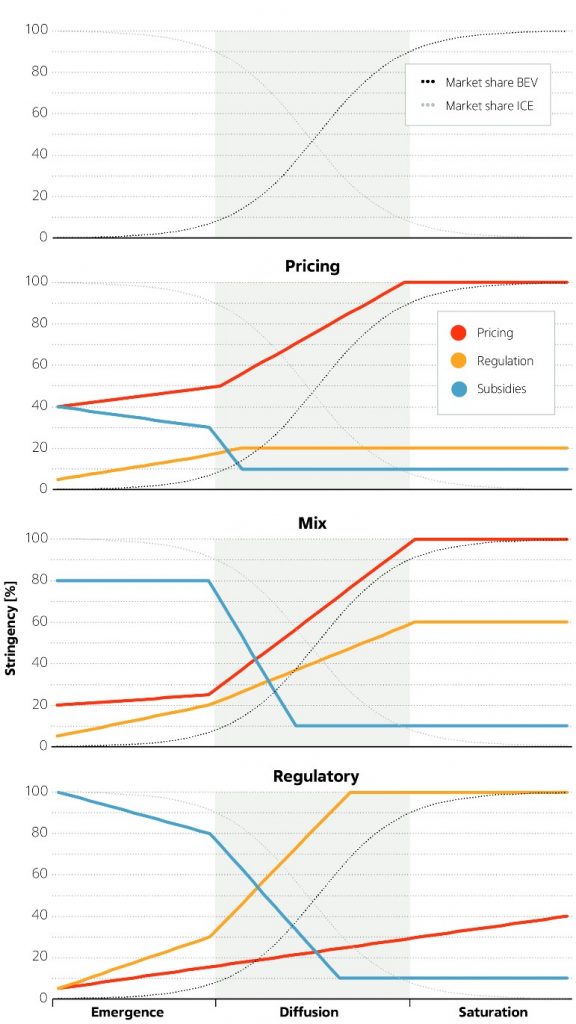
The approach for policy pathway construction and assessment in this report combines this broader logic of net zero technology transitions with sector specific challenges in economic, political, and governance dimensions. It proceeds as follows: (1) First, we characterise the current phase of transition in the sector of analysis – in this study, road transport LDV – based on available modelling and other relevant data. (2) Second, we aim to anticipate and characterize key sectoral challenges relevant to future phases of the transition, building on academic and policy literature and the climate policy discourse. (3) We then assess how the current (status quo) policy mix pathway addresses the identified intertemporal challenges in that sector. (4) Finally, we construct alternative policy pathways based on our observation of policy debates, academic and policy literature, taking a policy mix ‘patching’ (Howlett and Rayner 2013) approach (drift, conversion and addition/termination of instruments) to provide and assess options of how the current policy mix can evolve over time to best meet intertemporal challenges. Specification of these alternative policy pathways is not fixed but intended to inform deliberation processes in different contexts, including policymaker deliberations, citizen fora and expert community discussions in different sectors and regional contexts.
We use instrument stringencies as a conceptual comparative approach to represent different sequencing logics, within and across pathways. Instrument stringency refers to the level of environmental ambition in a policy instrument’s calibration, e.g. a higher fuel carbon price is more stringent than a lower one. We ensure instrument stringency metrics are consistent across pathways so that design logics can be compared, both with respect to scaling of the different instruments within a pathway over time, and how these design logics compare across pathways. For example, the maximum stringency (100%) for carbon (fuel) pricing applies to the pathway which relies heavily on that instrument to drive the transition (Fuel focus). The other pathways’ use of carbon (fuel) price is represented on the same relative stringency scale, to indicate that the instrument does not reach as high price, and scales more gradually over time.
We test our approach by applying it to emission abatement of light duty vehicles (LDVs) in Germany. A workable conceptualization of climate policy instrument mixes needs to demonstrate its usefulness in application to a specific sector, otherwise it is at risk of remaining too broad and superficial. We focus on LDVs because of their central importance in the German transport sector transition. In particular, we focus on the expansion of full BEVs as the currently most prominent candidate in terms of expected emission reduction potential and costs (Koller et al. 2021). We are aware that other mitigation options (modal shift, avoiding transport) are important for decarbonising the transport sector, but choose to constrain the analysis to keep it tractable.
We qualitatively consider pathways that promise to enable GHG abatement from LDVs in line with the GHG reduction and EV deployment targets for transport in 2030. We explicitly discuss the risks of failing to meet the defined GHG targets for different pathways, but our guiding principle is to consider pathway designs that promise to deliver the same necessary emission reductions (identical environmental effectiveness to ensure comparability). We aim at identifying how each pathway addresses sector transition challenges, and key associated risks, to identify trade-offs related in choosing among policy pathways. In doing so we also identify several areas of uncertainty or gaps in current knowledge which should form the basis of future research. The report proceeds as follows: First, we characterise the ongoing transition for LDVs in Germany (Section 2). Next, we evaluate anticipated challenges relevant for policy design for the LDV transition in Germany (Section 3). We then illustrate and assess the status quo future policy pathway, incorporating the EU commission’s Fit for 55 proposals (Section 4). Section 5 constructs, assesses, and compares three alternative future policy mix pathways. Section 6 concludes.
2. State and trends of the LDV transition
We briefly assess the state and expected trends and uncertainties of the LDV transition to net zero emissions in Germany. Doing so will help us define key policy challenges for linked to this specific and the following phases of the transition (section 3), and to assess how the current policy mix addresses these challenges and supports the transition both now and in the near future (section 4).
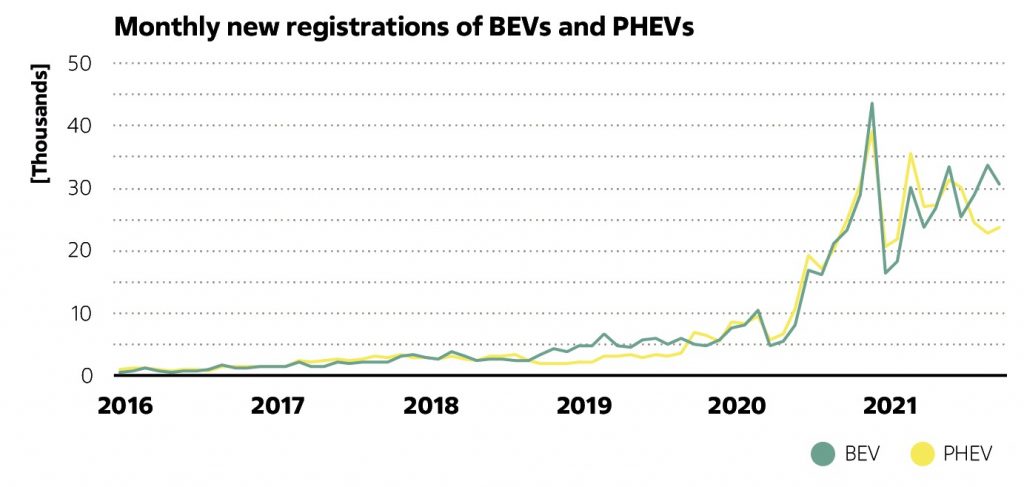
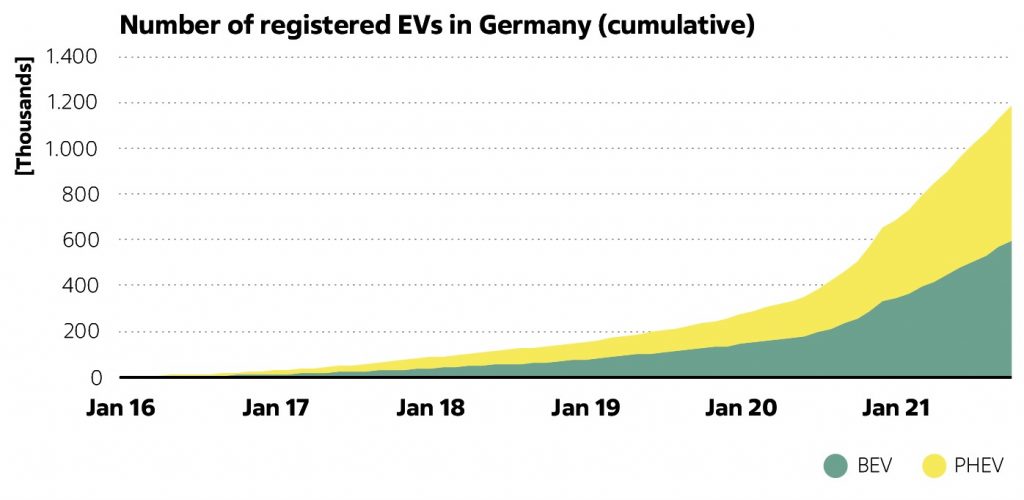
Sales costs of new BEVs have been declining significantly and are projected to match ICE vehicles within the decade. BloombergNEF (2021) forecast that pre-tax retail prices of BEVs will become cheaper than ICE vehicles in Europe as soon as 2027. These predictions critically depend on assumptions about future battery cost reductions. Resource availability and prices as well as technological advances in battery technology (e.g. saving on resource needs) are key determinants of these cost reductions.
Life cycle costs today are already lower for many BEV than ICE, across different vehicle categories, in particular if taking current support policies into account (Agora Verkehrs-wende 2022). Many BEV already offer lower total costs of ownership than ICE vehicles because BEV fuel costs for electricity are much lower per km compared to ICE vehicles. Overall, maintenance costs of BEVs are roughly 40% lower per km than those for ICE vehicles (Burnham et al. 2021). In addition, current subsidies reduce the costs of new vehicle purchases (Agora Verkehrswende 2022). However, issues around range anxiety, consumer myopia, high upfront cost, limited ownership duration of initial buyers and uncertainty about future resale prices have tended to impede uptake of BEVs in the past (Pevec et al. 2019).
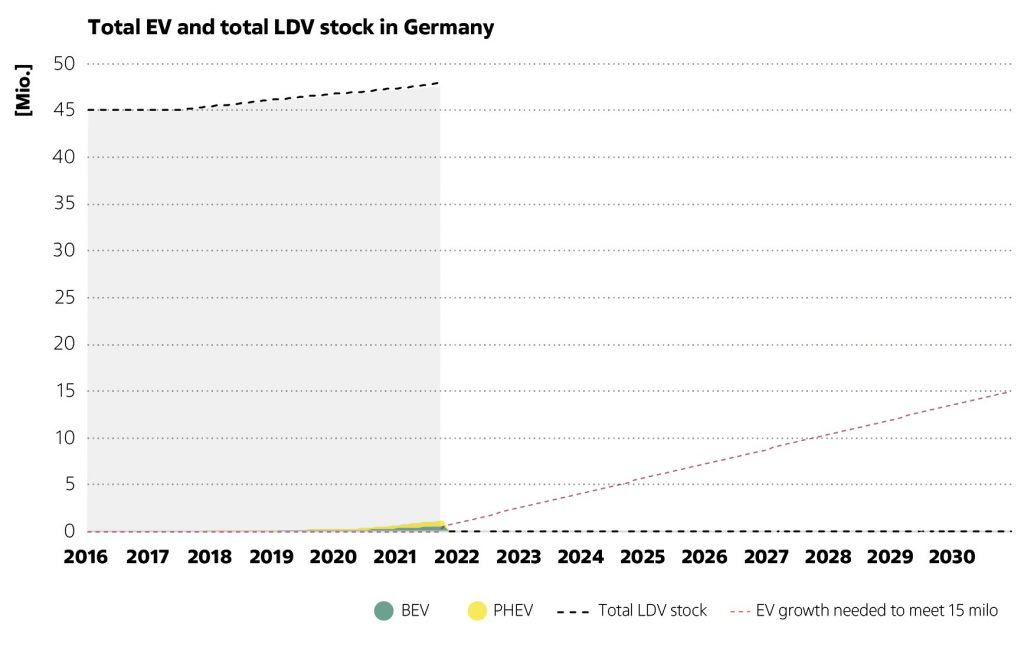
Germany’s market for BEVs has expanded rapidly in recent years. Being among the laggards by international comparison in the past, lately Germany’s BEV market has seen the largest growth in Europe with a BEV sales share of 14% on average in 2021 (KBA 2022). Strong EV sales likely resulted from enhanced range (i.e. new models or existing models with larger battery size), changed purchase subsidies (see Section 4.3), and compliance requirements with EU vehicle fleet CO2-intensity standards (Agora Verkehrs-wende 2022). No econometric analysis of the individual contributions of these and other factors is available though, to our knowledge. Figures 2 and 3 display the monthly and cumulative registrations of BEV and PHEV.
Public charging infrastructure has expanded significantly in recent years. As of January 2022, ~52.000 public charging points were in operation, including ~44.000 standard charging points and ~8.000 fast charging points (Bundesnetzagentur 2022). At current deployment rates (scaling of rates over the past 12 months) around 180,000 chargers will be installed by 2030. To attain the new coalition target of 1mio public chargers by 2030, almost 10.000 public charging points need to be installed per month on average (Figure 6). There is some uncertainty over how many charging points will be needed by 2030, with estimates around 1:10 (charger: vehicle) for urban areas and around 1:20 for suburban areas (Nicholas and Wappelhorst 2020). There is also debate over how long the state should subsidize installation, before market actors take over. Irrespective of these uncertainties, the observed current deployment rates are rather low.
Costs of public charging infrastructure have remained relatively constant. While costs of EVs have continued to decline, the costs of public charging infrastructure have remained constant or even increased in some instances (new designs of fast chargers). For example, total costs (material and labour) of a 150kw fast charger for public use are currently around $103k, and is only estimated to decrease to $100k by 2030 (Bauer et al. 2021), partly due to increasing labour costs. Other research is more optimistic about the potential for cost reductions of fast charging infrastructure (Funke et al. 2019).
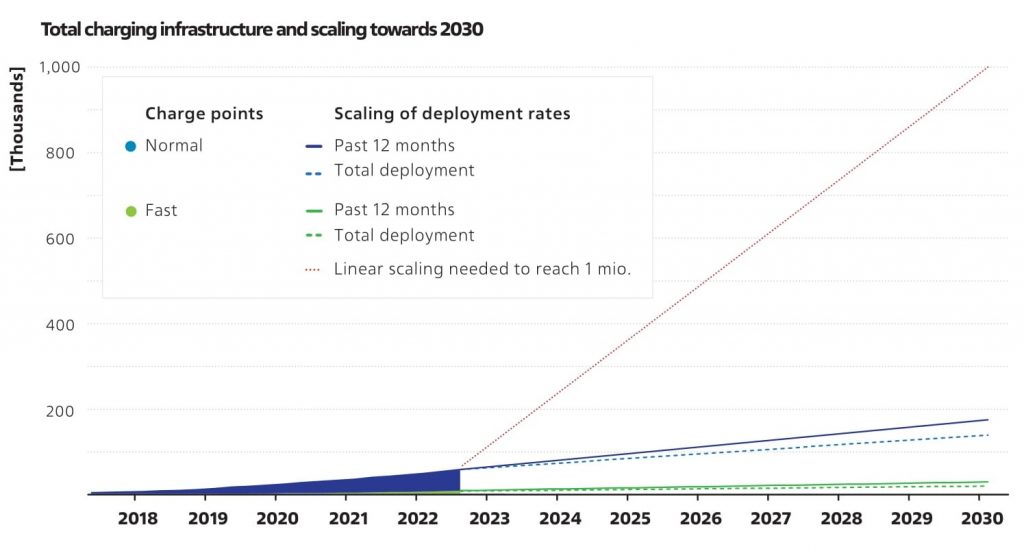
In terms of technological transition stages, the LDV transition in Germany currently is in the early diffusion stage. Despite the recent increase in EV market share, the cumulative total in comparison to the existing number of vehicles registered in Germany (48.5 mio.) is still less than 2% (Figure 4). BEVs are only beginning to become competitive with ICE vehicles in terms of costs and convenience (e.g. availability of charging infrastructure).
Upscaling deployment of BEV is key towards attainment of 2030 GHG and BEV deployment targets. For example, Gimbert (2021) anticipates that 60% of new registrations need to be BEVs by 2025, and 95% by 2030 to attain the 2030 GHG targets. Compared to the previous government which aimed at 7-10 mio. EVs on the road by 2030, the new government envisages 15 mio. The new target requires adding an average of 130.000 BEV per month up to 2030 (Schill 2022), whereas average sales in 2021 were 29.633 BEV per month (KBA 2022). While the actual adoption pattern can be expected to follow an S-shaped curve rather than a linear trend (Figure 6), this illustrates the significant scale of the challenge.
Surprises will occur and need to be anticipated in policy design and governance. Given the scale and complexity of the LDV and broader mobility transition, surprises about technological developments, behavioural change or policy performance will emerge and the governance of public policy should be set up anticipating this. How will BEV costs evolve with surging global demand for required basic resources – will material supply or technological developments adjust to demand rapidly and enable declining battery prices? Will crises like the pandemic or geopolitical tensions disrupt supply chains and drive up prices? How will the petrol and diesel station market develop when facing tumbling volumes of ICE vehicles on the road by the end of the 2020s – will declining economies of scale accelerate ICE vehicle phaseout? Governance of policymaking needs to be adaptative, continuously monitoring trends and adjusting the policy mix as challenges escalate (Flachsland et al. 2021). One way in which we aim to integrate such uncertainties in our analysis of policy mix pathways is by considering the possibility of both very high and very low costs of switching to BEVs (for whichever reason). The second way is by assessing how different policy pathways will perform with respect to the road transport transition challenges identified in the following section, notwithstanding the significant ex ante uncertainties about their realization. The third way is to assess the complexity of governing (here including: monitoring, assessing, and adjusting) the different policy mixes.
3. Policy mix design challenges and ex ante assessment criteria for the LDV transition
This section identifies key challenges for achieving the ambitious 2030 road transport emission reduction and BEV targets envisaged by Germany. Based on a review of peer-reviewed academic literature and policy papers (see Annex II), we particularly focus on identifying intertemporal challenges of the sector’s transition. We will employ these challenges as assessment criteria for different pathway options in Sections 4 (baseline) and 5 (alternative policy pathways).
3.1. Environmental effectiveness
Environmental effectiveness is our primary focus when designing policy pathways. To ensure attainment of environmental effectiveness, each pathway uses a combination of instruments following its respective design logic, implemented at stringencies capable of delivering the 2030 transport sector targets. This allows for comparison across pathways with respect to the other design challenges, given that they all attain the same level of GHG abatement by 2030. Accordingly, market failures for example are conceptualised as only affecting dynamic cost effectiveness, since even with persistence of these failures, the pathway designs are capable of delivering GHG abatement, albeit at significantly higher costs (low cost effectiveness).
There is no explicit emission reduction pathway for the LDV sector in Germany, but the alignment of LDV fleet emissions with the 2030 GHG transport sector target and 2045 GHG emission neutrality in Germany requires deep structural change. The revised Bundes-Klimaschutzgesetz (KSG 2021) envisages an overall transport sector GHG reduction from 139 MtCO2eq in 2022 to 85 MtCO2eq in 2030 (~40% below the 2022 level), with linear annual reduction targets in between. By 2045, Germany aims at achieving GHG emissions neutrality, which we interpret to imply zero CO2 emissions from the stock of passenger road vehicles in Germany. While the KSG does not specify an LDV GHG target (with transport comprising also heavy-duty vehicles (HDV) and other modes), LDVs currently contribute roughly 2/3 of total direct GHG emissions from transport and thus need to be reduced significantly by 2030. This extremely challenging set of GHG targets requires a fundamental transformation of the sector. Unlike a transport system modelling exercise, we do not assume or derive a numeric target for LDV sector GHG emissions since we perform a qualitative analysis. Also, different policy pathways in different sectors might imply different optimal GHG levels in the LDV sector (depending on interaction with emission reduction in other sectors).
We focus on two key options for achieving the envisaged LDV emission reductions: Expanding BEV sales and reducing the stock of ICE vehicles. With our focus on LDVs, GHG emission reductions can generally result from five interacting aspects: (1) reducing the carbon intensity of new cars with internal combustion engines (i.e. incremental ICE vehicle innovation, shift in purchase behaviour towards more efficient cars); (2) reducing the GHG content of fuels used by ICE vehicles (e.g. low GHG bio- and e-fuels); (3) reducing the use of ICE vehicles by shifting to other modes or reducing travel; (4) removing ICE vehicles from the fleet by scrappage or export; and (5) adding new BEVs to the fleet instead of ICE vehicles while decarbonizing electricity generation. In our pathways, we focus on options 3-5, i.e. expanding the sales of new BEVs, phasing out the existing ICE vehicle stock, and reducing use of ICE vehicles. We do not consider policies explicitly aiming at options 1&2. The rationale is that (a) we expect the bulk of emission reductions to result from ICE vehicle phase-out and BEV phase-in, and (b) we aim at keeping our analysis as simple and tractable as possible.
3.2. Static and dynamic cost effectiveness
We adopt a broad notion of costs. We define “costs” as the societal resources in terms of opportunity costs (e.g. foregone consumption) required to achieve a given GHG reduction target in the LDV sector. In a quantitative modelling analysis, different indicators for costs might be employed (e.g. total transport system expenditure). To simplify analysis, we do not consider co-benefits of the LDV transition such as improved air quality, reduced noise and resulting positive health effects. Cost effectiveness is defined as minimizing the costs of attaining a given GHG reduction target. Cost effectiveness defined as such (e.g. IPCC 2014) is desirable because it (a) frees up resources to pursue more ambitious emission reduction targets and/or other important societal targets (e.g. health care, education), and (b) minimizes the overall cost burden to be distributed across different actor groups, thereby reducing political challenges (see below). Conversely, cost-ineffectiveness can undermine acceptance by reducing available societal resources and aggravating distributional conflicts, thereby increasing political challenges of attaining GHG targets. It is useful to distinguish between (a) the costs and (b) the cost effectiveness of policy mix pathways. The total costs of GHG reduction pathways are determined both by factors within and beyond the control of policymakers. Our approach to policy mix pathway analysis focuses on those challenges that policymakers (in our case: in Germany and the EU) can address: Market failures, political and governance challenges, and other obstacles to cost effectiveness. We turn to these obstacles in more detail below. However, even when designing policy mix pathways to maximize cost effectiveness, costs of the LDV roll-out are still influenced by factors outside the control of German and EU policymakers. For example, prices and access to basic resources on world markets are only partly or not at all influenced by domestic policies or multilateral policy (e.g. geopolitical shocks or pandemics disrupting supply chains). Technological progress reducing the costs of battery technologies is partly shaped by policies and institutions in Germany and the EU, but it also involves exogenous uncertainty about physical and chemical engineering constraints. When we refer to (maximizing) cost effectiveness of policy mixes and pathways, we are interested in how policy instrument mixes can minimize overall cost given these exogenous factors. In our assessment of pathways, we also consider cost uncertainty to the extent it might affect the calibration of policy instruments, such as the level of carbon (fuel) pricing required to achieve given environmental targets under varying cost scenarios.
| Challenges | Components | Key Aspects/indicators |
|---|---|---|
| Environmental Effectiveness | BEV sales | Number of new BEV vehicles sold (market share) |
| GHG from existing fleet | Demand reduction (reduced use of existing ICE stock or switching from ICE to other modes of transport).Retirement of existing ICE vehicles from fleet | |
| Cost Effectiveness | Static cost effectiveness | Harmonizing marginal abatement costs across all short-term mitigation options |
| Dynamic cost effectiveness | Achieving least-cost timing of BEV deployment over time: neither too little (foregoing learning by doing effects) nor too much (costly) BEV deployment early on (and vice versa too much/little later)Addressing all market failures affecting dynamic cost effectiveness, including consumer myopia, learning by doing spillovers, R&D spillovers, network externalitiesEnsuring policy credibility to avoid investment hold-up by firmsRequiring limited information by policymakers and low costs of adjusting policy mix under uncertainty (see also “Governance” below) | |
| Fiscal burden | Costs & revenues to state | Fiscal costs/revenues generated from policy mix Higher fiscal cost places higher strain on government finance, and more susceptible to contestation/opposition |
| Distribution | Impacts on population groups | How policy mix distributes costs among the population Policy mixes differ in salience of costs (e.g. higher for carbon (fuel) pricing, lower for subsidies and standards) |
| Political Feasibility | Population | Acceptance among population groupsInfluenced by factors including trust in government, political preferences, ideologies, values, knowledge and perceived intrusiveness of instrumentsClosely linked to perceived distributional impacts across population groups |
| Firms | Acceptance among industry interest groups/stakeholdersLinked to distribution of costs (incl. competitiveness) and benefits on incumbent car manufacturers and new firms | |
| Governance | Administrative/ information requirements | Demands on the state to monitor, evaluate, and update policy mix over timeInformation, administrative and enforcement requirements are higher for some instrument optionsComplexity increases with more instruments, increases interaction effects and likelihood of unintended consequences |
Static cost effectiveness is desirable but not a sufficient criterion for assessing policy pathways. Static cost effectiveness refers to minimizing short-term mitigation costs by harmonizing marginal costs of mitigation options within and across sectors and regions over a brief period of time (e.g. a year). By ensuring that all actors face the same GHG price signal across all their available mitigation options, they will consistently choose those short-term mitigation options in producing, purchasing and operating passenger vehicles that are cheaper than this explicit or implicit price, unless inhibited by market failures or other barriers (Staub-Kaminski et al. 2014). Carbon (fuel) pricing is considered an ideal instrument from a static cost effectiveness perspective because it incentivizes all available short-term mitigation options (particularly use, but also scrappage and purchase). By contrast, policies such as CO2-intensity standards for new vehicles do not incentivize reductions in vehicle use. However, the concept of static cost effectiveness ignores market failures that relate to mitigation cost reductions over time.
Dynamic (or intertemporal) cost effectiveness is essential for analysing policy mix pathways. Dynamic cost effectiveness refers to minimizing mitigation costs of achieving environmental targets over a longer period such as one or several decades, and can be expressed in terms of cumulated mitigation costs. It particularly requires taking into account reductions in mitigation costs (e.g. conceptualized as marginal abatement cost curves) due to technological progress over time. Also, how policy addresses market failures affecting the speed and scale of technological progress is important to assess dynamic cost effectiveness of policy pathways. For the case of BEV, optimizing dynamic cost effectiveness refers to promoting a deployment pathway that balances early deployment of higher cost BEV to facilitate further cost reductions via learning by doing effects with later deployment of then cheaper BEV (e.g. due to technological progress in battery production and expansion of global raw materials mining capacities; see Figure 7 for illustration). We are here particularly interested in the risk of and ways to avoid major “policy errors” that would entail large scale dynamic cost ineffectiveness, i.e. of a magnitude that would lead to emission reduction targets being violated or even explicitly reduced because they become politically unacceptable. This might be the case e.g. with massively subsidizing relatively expensive BEV early on and thus vastly expanding their deployment, instead of waiting for scaling up of deployment until cost reductions are realized. Conversely, very low early adoption rates e.g. due to lack of short-term policy stringency might lead to less-than-optimal learning by doing and resulting delays of possible cost reductions, and may later also necessitate extremely high deployment (and ICE vehicle scrappage) rates, which might be particularly costly e.g. in case of production bottlenecks (Figure 7).
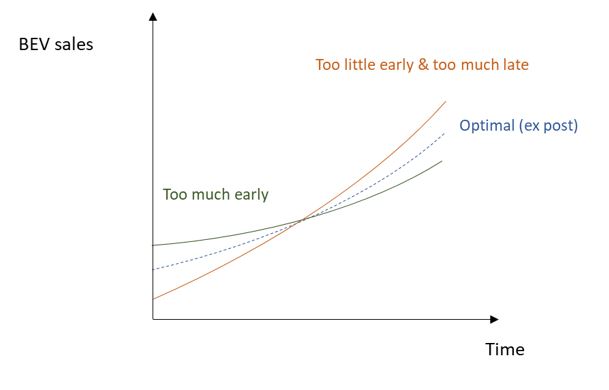
Market failures impairing dynamic cost effectiveness need to be addressed using targeted policy instruments. In a simple textbook setting with perfectly informed rational producers, consumers and omnipotent governments imposing a cumulative carbon budget as well as lack of additional market failures, a carbon (fuel) price increasing at some optimal discount rate is the only required climate policy instrument to maximize both static and dynamic cost effectiveness. However, additional market failures and governance challenges such as consumer myopia, EV charging infrastructure network externalities, positive learning-by-doing externalities in the deployment of BEVs, or lack of credible government commitment to a given policy, mean that even a perfect carbon (fuel) price cannot alone implement the maximally cost-effective outcome (Fischer and Newell 2008, Vogt-Schilb and Hallegatte 2014). The theoretically perfect carbon (fuel) price trajectory (derived ignoring market failures) would in this case lead to a shortfall of cumulated mitigation if implemented via a fixed carbon tax. In case of an ETS it might lead to an initially low and then steeply increasing and overly costly (i.e. dynamically cost ineffective) allowance prices and emission reductions late in the 2020s and beyond if anticipation on allowance markets is imperfect relative to the social optimum (thus also possibly rendering such a pathway politically infeasible and affecting its credibility ex ante, see below). In a perfectly rational allowance market, an unnecessarily high allowance price trajectory might emerge to compensate partly for the non-implementation of additional instruments. Even an “optimised” carbon (fuel) pricing pathway considering these additional challenges (e.g. by way of implementing a higher level of carbon (fuel) pricing early on) would not be optimal, since addressing additional externalities and challenges by separate instruments can implement an overall more cost-effective outcome (Kalkuhl et al. 2012). We next discuss key externalities and market imperfections relevant for dynamic cost effectiveness in the LDV sector transition.
Consumer myopia refers to consumer discounting lifetime costs of vehicles at disproportionately high rates. EVs currently have a higher upfront capital cost than ICE, but lower operational costs, which already makes them have comparable or even lower lifetime costs (Agora Verkehrswende 2022; BloombergNEF 2021). However, a common finding is that consumers under-value long term costs and savings (Allcott and Wozny 2014; Gillingham and Munk-Nielsen 2019; Andor et al. 2020; Wolfram et al. 2021), and due to bounded rationality are more likely to make suboptimal choices.1The magnitude of this effect is disputed, with some research suggesting only limited evidence of consumer myopia (Busse et al. 2013; Sallee et al. 2016). Policy needs to be designed to overcome this behavioural characteristic, otherwise myopic consumers might keep buying overly costly cars, in terms of lifetime costs. A related issue concerns whether consumers are able to make rational decisions, due to a lack of ‘perfect’ information (Safarzyńska and van den Bergh 2018). For example, Plug-in Hybrid Electric Vehicles (PHEVs) are widely perceived as delivering GHG abatement and offering lower fuel costs, yet evidence suggests a significant performance gap between real-world emission reductions and those suggested by lab testing (Tietge et al. 2019; Plötz et al. 2020). On average, real-world fuel consumption and CO2 emissions of PHEVs for private drivers in Germany are over twice as high as in official test procedures, and up to four times higher for company cars. Policy can help shape cognitive expectations through provision of accurate information about life-cycle costs of vehicles, and by implementing registration or purchase taxes based on accurate performance data of new vehicles. The rationale would be to raise upfront costs of more expensive (life-cycle) options and/or reduce costs of lower life-cycle cost options to correct the distortion raised by consumer myopia and bounded rationality. However, there is significant uncertainty about the size of this potential effect, and thus optimal policy design and calibration.
Knowledge production spillovers resulting from learning-by-doing in the development, production and use of BEV can be important for dynamic cost effectiveness. Basic Research & Development spillovers between firms (Jaffe et al. 2005) and learning effects within firms and tacit knowledge production (Nelson and Winter 1982; Nightingale 2003) reduce costs of BEV over time. Learning effects can also apply to consumers, locally through positive spillovers as the number of adopters of the new technology increases, and collectively as cognitive views and values shift as the new technology becomes culturally and symbolically embedded in normative views. Consumer learning effects therefore not only reduce the effects of myopia by providing information and helping guide behaviours which leads to increased diffusion of BEVs, but also therefore increase market-pull dynamics, incentivising increased firm innovation, which can create a self-reinforcing virtuous cycle (Aravena and Denny 2021). From a societal perspective, in absence of policy interventions these learning-by-doing dynamics lead to market failures since car manufacturers and consumers will underinvest relative to the societally dynamically cost-effective level particularly in earlier phases of production of BEV, when these spillover effects are particularly high but cannot be fully appropriated by firms (e.g. due to reverse engineering) or consumers. This justifies additional policy instruments supporting early deployment to realize these learning effects, which would be phased out over time as the magnitude of these effects decline.
Network externalities can inhibit or slow down adoption of BEV. For BEVs, the initial build-up of charging infrastructure involves potential network externalities (Zhou and Li 2018; Springel 2021). Private actors may be less willing to invest in infrastructure at the beginning of the transition, as the investment is under-utilised. However, for BEVs to be an attractive alternative to ICEs, there needs to be sufficient infrastructure available. As diffusion of BEVs increases the private sector is expected to increase investment in charging infrastructure as risk is reduced and expected revenues increase. Research suggests that although the incidence of charging points in Germany already exceeds the EU’s recommended minimum ratio of one point to ten EVs, inadequate infrastructure coverage remains a binding constraint on EV uptake and the continuation of public support hence appears warranted (Sommer and Vance 2021). Public support of infrastructure extension also has indirect effects on BEV adoption through targeting range anxieties, increasing convenience, and adding to learning by doing effects as the number of BEVs increase over time. Again, related public policies would be phased out over time as the magnitude of the externalities decline.
Credible government commitment and increased market certainties reduce investment risks, which can lead to more BEV capacity investment by manufacturers and higher cost reductions. High political commitment to policy mix pathways delivering transition targets reduces investment risk, and firms have a higher incentive to invest in low carbon options (Newell and Goldsmith 2001; Brunner et al. 2012). This relates to the interpretive effects of policy mix change (Pierson 1993; Edmondson et al. 2019) – the information that formalised or informal policymaking outcomes provide to actors, thereby shaping expectations and directing investment and innovative activities (Edmondson et al. 2019). Also, if firms observe lack of credible commitment – for example when experiencing unexpected dismantling of support policies – they are more likely to direct more attention towards lobbying and rent-seeking in order to maintain the status quo or to steer the transition in a direction that suits their interests, rather than fully committing resources to radically changing their business models and supply chains (Roberts and Geels 2019).
Credibility can be increased by targeting investments over emissions, and through policies which establish a forecasted trajectory. Instruments which target investments can reduce time inconsistency problems, which reduces uncertainties (Kalhuhl et al 2020). This is typically more common with regulations and subsides which target investments (stocks) but can also be achieved through investment taxes. Increased certainty can also be provided through implementing commitments to a transition pathway. Subsidies and possibly regulation anchored in legislation (creating enforceable property rights) can provide more certainty (Brunner et al. 2012). Technology specificity of the policy mix can also increase market certainty, leading to increased investment in innovation, upscaling and infrastructure provision for specific technologies (Bhadwaj et al. 2020), but there is a potential trade-off with government potentially making errors in picking winners and foregoing innovation in non-considered technologies.
Governing policy pathways that achieve dynamic cost effectiveness under uncertainty is a major challenge. Numerically characterizing the optimal sequence of technological (e.g. optimal timing of ramping up BEV vehicles) and behavioural mitigation (e.g. car retirement and purchase decisions) using models is challenging even using numerical models. Modelers, policymakers, and firms all face (different) information constraints and irreducible uncertainties, including about the precise magnitude of externalities discussed above and corresponding optimal policy design and calibration. These only taper off as the transition advances and as rigorous ex post research develops and provides more and more empirical evidence about the size of externalities, cost reductions and elasticities. The realized cost effectiveness of a policy mix path is also affected by the extent to which the governance challenges can be managed by policymakers, especially with regards to information requirements and dynamic adjustment needs. Differences in information requirements and readjustment needs must therefore be taken into account as relevant elements in assessing alternate policy mix pathways. However, operationalizing this criterion is challenging as well. As one proxy, we consider information requirements and needs for dynamic updating (and its complexity) by policymakers for the different pathway options in the evaluation category “governance”, but highlight that further work e.g. on the institutional setup for governing policy mixes over time would be useful.
Trade-offs exist for dynamic cost effectiveness relating to uncertainties and the level of market intervention. Less interventionist approaches (e.g. pricing only) with greater degrees of flexibility can allow the market to adapt more easily to exogenous shocks to the system, such as large fluctuations in price of components and materials. However, such an approach is susceptible to market failures, which may lead to slower BEV diffusion, which incentivises less investment, hampering dynamic cost effectiveness and in a worst case scenario may under-attain 2030 targets for diffusion. Conversely, a highly prescriptive approach which attempts to direct the trajectory and target all failures to accelerate transition, is potentially more susceptible to dynamic cost ineffectiveness in presence of exogenous uncertainties. If supply chain costs turn out to be much higher than anticipated (due to crises, material and component shortages etc.), then mandated proxy targets for BEV diffusion rates might result in much higher costs. In a worst-case scenario, high costs and supply shortages might result in political pressure to relax ambition, which could undermine credibility. Consequently, striking the right balance between targeting market failures and providing policy credibility (via directionality), while also allowing enough flexibility to adapt to uncertain conditions and allow market mechanisms to optimise price performance improvements is at the core of intertemporal cost effectiveness. A policy mix that induces increased use of alternative abatement options (e.g. ICE vehicle use reduction) and a temporal shift in the BEV deployment schedule minimizing costs over time while preserving the environmental targets is desirable. Credible empirical scientific studies further clarifying and preferably quantifying these uncertainties in the specific EU and German context (and beyond) would be extremely valuable.
3.3. Distributional effects
We focus on the distributional effects across population groups. Policy mixes that bestow resources on target groups are more likely to produce/maintain their political support over time (Campbell 2012). Policy mixes can either bestow resources or incur costs and loses on target groups (Pierson 1993; Edmondson et al. 2019). How visible and traceable benefits/costs are (Pierson 1993), and to what extent these are dispersed or concentrated within the population will affect the strength of these ‘resource effects’. Resource effects can affect interest groups and stakeholders, but we do not consider the distributional impacts on business here as it is difficult to identify asymmetries in how firms would be differently affected across our alternative policy pathways below. Our alternative pathways achieve the same volume of BEVs deployed by 2030 (by assumption), providing equivalent market challenges and opportunities to manufacturers. We also do not engage in questions around national component requirements and industrial policy, which would require dedicated cost-benefit analysis. Further work addressing the distributional politics for car manufacturers and firms more broadly across alternate policy mix pathways would be useful.
The LDV transition will likely have different impacts across income groups. To the extent poorer households in Germany own cars (relatively few do in the poorest deciles, Kalkuhl et al. 2022), increasing the costs of operating existing ICE vehicles (e.g. via carbon (fuel) pricing) or of purchasing new vehicles (e.g. possibly via ICE vehicle standards, BEVs) might hit them disproportionally hard since they tend to spend a higher share of their income on LDV-related mobility than richer groups (on higher share of fuel expenditure in household consumption, see Kalkuhl 2022). The related loss in disposable income and reduced mobility opportunities are inextricably linked to social disadvantage and exclusion (Ohnmacht et al. 2009, Lucas 2012; Schwanen et al. 2015; Urry 2016). Particularly affected/vulnerable groups include: elderly people, people with reduced mobility, low-income groups and unemployed people. These effects are more likely to occur in rural and deprived areas with less availability of alternative modes of (public) transport (Caulfield et al. 2022).
While all policy pathways involve costs, the level of total costs (i.e. cost effectiveness) and their salience will differ across policy pathways. Higher dynamic cost effectiveness reduces the overall pie of costs to be distributed across income groups (Section 3.2). The salience of GHG pricing policies (GHG taxes, emission trading schemes) is considered higher than that of standards indirectly changing costs (e.g. of new vehicles, or fuels). This is widely perceived to facilitate political mobilization against carbon (fuel) pricing policies (Douenne and Fabre 2020). In particular, there is significant concern over the political acceptance of very high carbon (fuel) prices (Axsen et al. 2020, see below).
Policy pathways raising significant fiscal revenues offer the opportunity to directly steer distributional outcomes via recycling. Policies generating fiscal income open up opportunities for revenue recycling and thus directly steering the distributional impacts across income groups, e.g. via lump sum recycling anticipated to lead to (on aggregate) progressive outcomes in Germany (Baldenius et al. 2021).
3.4. Fiscal effects
Fiscal effects can refer to the costs incurred on the state associated with supporting the policy mix over time, or conversely if the mix design generates revenues. Policy mix design can incur high strain on state budgets if it relies heavily on subsidies. Conversely, pricing mechanisms can alter the relative purchase costs of BEVs, either directly through registration taxes, or indirectly through carbon fuel pricing, while also generating revenues.
Combining instrument types can reduce fiscal strains on state budget. Policy mix design can combine instrument types to reduce overall fiscal burden. For example, policy designs which involve both revenue-generating and subsidising components (e.g. “Bonus-Malus”) can complement each other to contain fiscal costs. Disincentivising behaviour through pricing can generate revenues while incentivising another behaviour, which also reduces the amount of subsidy needed since the purchase costs of taxable stock (ICEs) increases relative to the non-taxable stock (BEVs).
Fiscal effects are associated with support and opposition from budgetary guardians for climate policy. If policy mixes generate high fiscal costs, they are more likely to raise concerns among budget guardians and those prioritizing other state spending priorities (e.g. health, education), and thus political opposition (Oberlander and Weaver 2015; Edmondson et al. 2019). Reducing the fiscal burden can therefore help shield the policy mix from political contestation, especially in times where state revenues are constrained (e.g. economic recessions, austerity, crises). If policy mixes raise revenues, not only is the policy mix more likely to retain support, but funds can be used for multiple purposes including targeting distributional outcomes, investing in green technologies, or supporting the general budget (Klenert et al. 2018, Kellner et al. 2022).
The envisaged erosion of gasoline and diesel fuel tax revenues raises a challenge for public finance. Phasing out gasoline and diesel use implies gradual loss of ~€36 bn annual fuel tax revenues for the state (Haushaltsgesetz 2021). Other fiscal sources will need to be substituted from within or outside the LDV sector, assuming the state budget will not be reduced accordingly. This challenge equally applies to all policy pathways achieving zero LDV GHG emissions.
3.5. Political feasibility
Political feasibility is a key consideration in policy mix design and relates to the potential for implementation of the policy reform, and its policy durability over time. Whether or not a reform option is possible to be implemented, and if the political support for this is likely to be sustained over time is central concern for policy pathways construction. However, political feasibility is also closely related to other design challenges: cost effectiveness, distributive effects and fiscal effects. Therefore, addressing the previous challenges in pathway design also increases the prospects for acceptance and sustained political support over time of the pathway.
Prospects for policy mix reform depend on party policy platforms and enabling or constraining political coalitions. Instrument selection and stringency can be largely dependent on the strength and size of supportive political coalitions (in particular across parties forming a coalition government) who are needed to enact and support reforms. Given current political conditions some reforms may not be possible until more favorable political coalitions form (Patashnik and Zelizer 2013; Oberlander and Weaver 2015). Conversely, if supportive political coalitions weaken post-enactment, reforms may become increasingly contested over time, leading to dismantling.
Formation of policy platforms and political coalitions is significantly influenced by acceptance and support from (a) voters and (b) industry. Political parties form their climate policy platforms in the context of electoral systems, public opinion and (competing) industry interests. Democratically elected policymakers will avoid being penalized in elections for introducing climate policies that reduce the likelihood of being part of a government coalition, e.g. by losing vote shares (Stokes 2016). Broadly, ambitious climate policies tend to be adopted where public opinion is favorable (Levi et al. 2020). Conversely, a lack of acceptance for policy mixes or its deterioration over time might lead to their watering down or even dismantling, thus putting the attainment of GHG targets in jeopardy. While most German citizens are concerned about climate change and support climate change mitigation, many ambitious policies, especially in the transport sector, remain controversial (Levi et al. 2021). Carbon (fuel) pricing, for example, tends to be one of the least popular climate policies in the transport sector, likely because costs are highly visible and trust in the political implementation of carbon taxation is limited.
Public acceptance of reforms is influenced by a range of factors including distributional impacts, general political preferences, values, trust in government, and perceived policy outcomes (e.g. emission reductions). Research shows the acceptance of specific climate policy instruments is driven by economic self-interest, climate change attitudes, and political trust as well as by perceptions of fairness and effectiveness (Carattini et al. 2019; Douenne and Fabre 2020; Maestre-Andrés et al. 2021). Carbon (fuel) pricing, for example, tends to be more accepted when political institutions are well-governed, when citizens are compensated for the burden of carbon (fuel) pricing, and when social policies are included in the policy mix (Levi et al. 2021). To understand public opinion towards different types of policy instruments, we focus on their (perceived) consequences, notably the extent to which they are regarded as effective, fair, and un-intrusive.
Public acceptance can be increased through a sequencing design logic. Implementing an unintrusive carbon tax initially, and gradually increasing the stringency over time could allow time for initial opposition to policy implementation to stabilise, mitigating provoking public contestation through immediately high pricing. Studies suggest that citizens quickly become accustomed to measures after they have been introduced, especially if perceived burdens turn out to be lower than feared before implementation (Harrison 2013; Jagers et al. 2020; Konc et al. 2022). Initially moderate carbon pricing might also be complemented by other initially moderately stringents instruments yielding additional emissions reduction effects, thus potentially dispersing salience of the intervention across multiple instruments (instead of a single highly visible and potentially politicized instrument with significant hike in stringency). We are not aware of robust evidence on such a potential mechanism though.
Public acceptance can also be increased through use of compensation measures. The particularly salient upfront costs of carbon (fuel) pricing compromise public acceptance of pricing at high stringencies. However, research indicates that implementing revenue redistribution to compensate the public may mitigate opposition. However, this effect is believed to be more pronounced for traceable ‘lump sum’ payments and observed to be low for indirect compensation mechanisms (Baldenius et al. 2021, Mildenberger et al. 2022, Kellner et al. 2022).
Industry and specifically automobile manufacturing interest groups can constrain ambitious policy reforms through lobbying. Interest group’s influence is considered a primary obstacle for climate change policy adoption, especially in the transport sector, where capital is very concentrated (Kornek et al. 2020). Germany is home of some of the world’s largest car companies and in the Southern Bundesländer, car manufacturers and their supplier employ a significant share of the German voter base. Moreover, Germany’s transport ministries have been mostly run by conservative parties who perceive it as their responsibility to protect the German car manufacturing industry (Flachsland and Levi 2021). We consider potential opposition and support by German car manufacturers, noting that more ex ante analysis comparing potential reactions to alternative policy mix pathways in the German corporatist setting would be useful.
Manufacturers’ support of electrification appears to have recently increased (in general). Some manufactures may remain reluctant to rapid electrification of new vehicle sales, but in general preferences have been changing. The German car industry has until recently opposed climate policies in the transport sector, partly because it represents an extremely powerful vested interest group with a highly profitable business model based on the ICE vehicle solidly entrenched in a corporatist governance context (Meckling and Nahm 2018; Flachsland and Levi 2021). This behaviour might be interpreted as producer myopia, discounting policymakers’ announcements of long-term decarbonization efforts. Some companies still lobby for continued production of ICE vehicles and associated use of hydrogen or e-fuels (at least in light-duty vehicles or trucks). However, Germany’s largest carmaker Volkswagen (VW) has invested strongly in electro mobility and is openly supporting stricter climate policies in the transport sector. Currently, almost all German car manufacturers invest in electrifying their product portfolio, but the degree to which they can comply with stricter climate policies and their acceptance of them strongly varies across companies.
Understanding of the formation of political party climate policy platforms in the context of the German (and other) electoral systems, voter preferences and industry interests remains limited. Even while political feasibility is a key consideration in designing and evaluating climate policy mixes ex ante, a conceptually clear and empirically operationalized framework for precise analysis is lacking. Research should advance understanding in this direction given the high relevance for societal decision-making and welfare. In the meantime, predictions about political feasibility need to be treated with care and the significant uncertainties should be clearly communicated. One way of addressing these uncertainties in real world policymaking is via governance provisions that put the option of (non-)incremental ratcheting up of policy stringency of instrument mixes regularly on the agenda (e.g. the German Climate Law’s annual review mechanism, see Flachsland and Levi 2021). Such institutional windows of opportunity might then align with favourable (or unfavourable) changes in policy platforms and political coalitions.
3.6. Governance
Our pathways assume a patching construction logic, which involves amending and reconfiguring the existing policy mix currently implemented. Real world policymaking is messy and often involves patching and layering upon existing polices (Howlett and Rayner 2013). A major consideration is that policymakers do not have a blank slate on which to enact a new package of instruments. Much more commonly adjustments to policy mixes involve patching existing mixes, through layering (adding policies on top of existing mixes), drift (changing the substance of existent policies), and conversion (significant changes in policies; Howlett and Rayner 2007), or addition and termination of instruments. Termination is procedurally more challenging than other procedural interventions. Our pathways accommodate these considerations by building from currently enacted mixes and plans for their reform (i.e. EU Commission Fit for 55 proposal, German coalition treaty).
Governance requirements depend on several factors which relate to pathway design and instrument choice. Governance requirements for pathways depend on: (a) the informational and administrative requirements of selected instruments, (b) their need for recalibration and adjustment over time, and (c) the number of instruments utilised and associated complexity of the pathway design.
Instrument choices have different informational and administrative requirements. Regulatory-based approaches typically have higher administrative requirements, such as robust procedures for monitoring of vehicle emissions intensity which are susceptible to issues of ‘gaming’ and evasion (Reynaert 2021). Technical capabilities are required for monitoring, along with access to accurate information. Absence, or low capacities, of institutions or enforcement agencies make implementing, or updating/adjusting stringent policy (e.g. technology standards) difficult, which can have adverse implications for credibility of the policy mix (Edmondson et al. 2020). Similarly, emissions trading mechanisms and carbon taxation require credible monitoring and other administrative infrastructures. Carbon (fuel) pricing instruments also require updating under learning about their performance and in changing circumstances, as illustrated by the constant flow of EU ETS reforms since its inception. Choosing instruments which have high informational and administrative requirements increase the governance challenge, which may lead to higher likelihood of governance failure and may undermine credibility.
Governance of policy pathways need to be adaptive, so instrument recalibration mechanisms and planned revision steps must be included in the design. Due to the complexity of real-world policymaking, conditions change, and unintended consequences will occur, which will require amendments or subsequent policy patching (Howlett and Rayner 2013). Policy mixes need to co-evolve with changes in the world (Edmondson et al. 2019), both internal system dynamics (e.g. market trends, public acceptance) and external shocks (e.g. sudden changes to international supply chains for components). This requires reflexive and iterative policymaking processes (Hoppmann et al. 2014), and instruments should be designed with mechanisms embodying either automatic or structured discretionary political adjustments, allowing to effectively respond to changing conditions (Jordan and Moore 2020). Some instrument options will require more recalibration, primarily those which need to be adaptive to exogenous trends such as component prices and market prices of BEVs. This comes with a trade-off of increased information and administrative requirements and reduced certainty, which can hamper dynamic cost effectiveness.
Complexity increases administrative requirements due to likelihood of errors and unintended consequences, which increases need for recalibration. More complex policy mix designs increase the likelihood of unintended interactions due to increased instrument interactions occurring in a complex, changing and uncertain world (Jacobs and Weaver 2015). Frequent revisions and amendments add administrative complexity and open the mix to errors as well as more political contestation, increasing the risk of politicisation of certain issues (Jordan and Matt 2014). Contestation may reduce the effectiveness of a mix design if ambitions are ‘watered down’, for example if other crises occur which are politically salient. Mechanisms can be designed as secondary legislation, as a form of institutional shielding (Lockwood et al. 2017), allowing bureaucrats to make revisions without parliamentary consent, thereby lowering the likelihood for continued contestation. Having multiple overlapping and perhaps even redundant policies in place might be another way of addressing concerns over political contestation and watering down from an environmental effectiveness perspective, but while this argument appears (implicitly) relevant in the policy discourse we do not further pursue this line of argument due to lack of systematic examination in the peer-reviewed literature.
4. Future policy mix pathways – construction and baseline
We now turn to analysing future policy mix pathways. We first briefly describe our descriptive framework (Section 4.1). We then reconstruct and assess the baseline “policy as usual” pathway of policies currently in place in Germany and Europe, incorporating the EU Commission’s Fit for 55 proposal (Section 4.2). For a static snapshot overview of the current LDV policy mix for Germany, see Annex I.
4.1. Constructing and assessing policy mix pathways
Three types of consumer decisions determine the transformation pathway in the LDV sector: Scrappage, purchase and use of vehicles. First, the decision to remove ICE vehicle from the stock of existing stock via scrappage or exports is central to eventually phasing out the existing ICE vehicle stock. It depends on the expected costs and benefits from anticipated new purchase (or the decision not to buy another LDV). Second, the decision to purchase a new (or used) vehicle, and particularly whether this is a BEV (thus contributing to achieving environmental targets) or a new ICE vehicle, determines the longevity of the ICE vehicle stock and thus lifetime emissions. It depends on expected costs and benefits of using the vehicles. Third, marginal decisions on the use of existing ICE vehicles determines the volume of sector CO2-emissions (Figure 8). For simplicity, we ignore the step development of new vehicle types by car producers which determine the portfolio of available vehicles for purchase (and related market failures, political challenges, and policies).
There are different externalities associated with these three types of decisions. Consumer myopia plays out in purchasing decisions. Producer learning-by-doing effects depend on their volume of production for sales, which is the flip side of purchases. By contrast, consumer learning-by-doing effects play out in the use of BEV, and network externalities can inhibit the roll-out of EV charging infrastructure affecting the convenience of using BEV. Finally, CO2 emissions from ICE vehicle driving lead to the fundamental climate externality to be mitigated by climate policy (bottom of Figure 8). Again, we ignore externalities in the development phase of new vehicles for the sake of simplicity, where particularly research and development knowledge spillovers and political challenges appear less relevant in the upcoming phases of the German LDV transition.
We focus on instruments that critically affect these three types of decisions. We restrict our analysis to those instruments that, based on our literature review of climate policy instruments in road transport (Annex II), we consider as most effective and important in driving the LDV transition (Bhardwaj et al. 2020; Levi et al. 2021; Agora Verkehrswende 2021). These instruments directly affect different types of decisions (Figure 8), but note that since decisions interact, instruments also affect other decisions (e.g. anticipated carbon (fuel) pricing for gasoline or diesel will affect the calculus of buying a new car, which in turn affects scrappage decisions). The rationale is to minimize the number of considered instruments (they range from 4 to 8 across our scenarios) to reduce complexity, while retaining a perspective broad enough to cover policies that constitute the core of alternative policy mixes. Additional policies can play important complementary roles (e.g. by removing regulatory/legal/institutional/behavioural challenges), but fully considering them would overcomplicate the analysis.
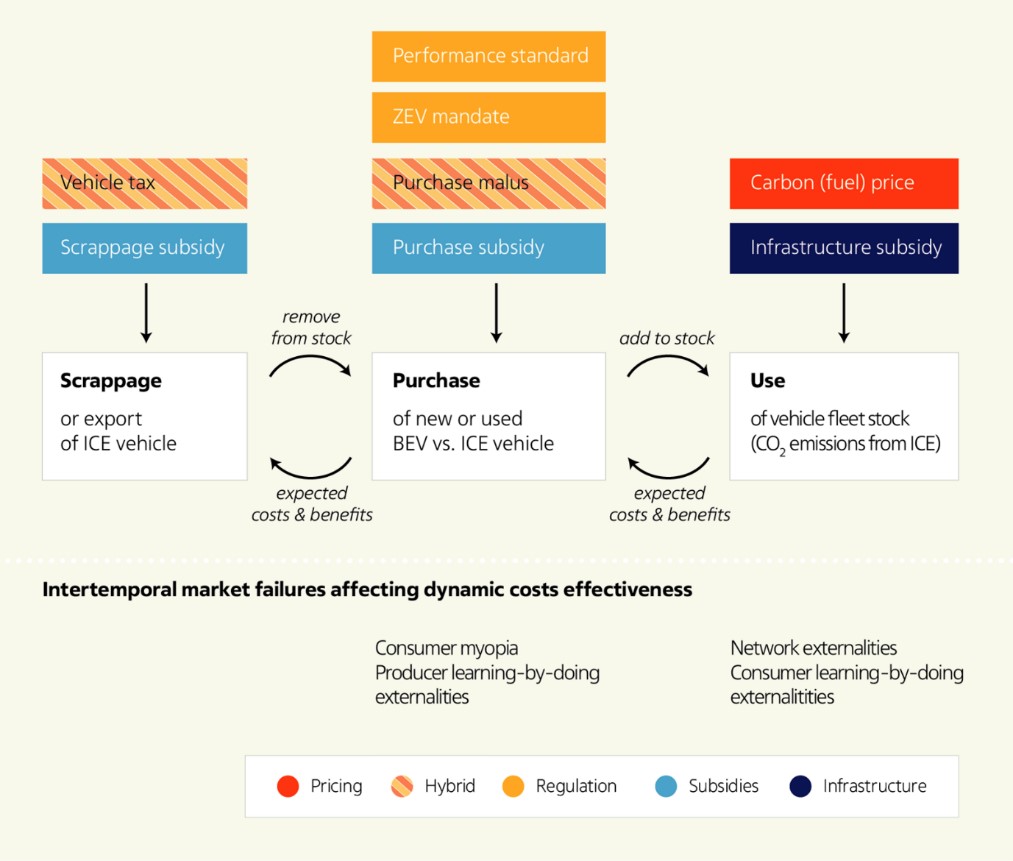
Moving beyond a static consideration of pricing vs. regulation, or mix, as the main pathway design archetypes. We advance the policy debate by (a) focussing on the dynamics of the LDV transition (Figure 8), (b) devising innovative combinations of instruments which can drive the transition while optimising design challenges, for example by reducing fiscal burden by offsetting costs of subsides with complementing pricing (Malus), and by (c) considering policy design as evolutionary and dynamic.
Policy pathway construction relates to different emphases on vehicle stock dynamics. We construct three alternate pathways which differ in their approach and instruments for addressing vehicle stock turnover dynamics. We started by constructing and assessing the status quo instrument mix for the LDV sector in Germany, and then construct assess alternate pathways which evolve from the status quo following a policy patching logic (Howlett and Rayner 2013). We sought to design each pathway in a way that ensures environmental effectiveness and political feasibility (to the extent possible given the constrained set of considered instruments), and yields the best possible outcomes in the other challenge/evaluation dimensions in an iterative application of ex-ante assessment criteria and redefinition of pathway mix design.
Pathways are constructed with diffusion of BEVs as the focal technology. We focus on BEVs as the main option for decarbonisation of the LDV sector. Primarily, BEVs are currently the most suitable technology option capable of delivering large scale GHG emission reductions. Since our focus is on attainment of the 2030 sector targets for Germany, we consider this the only viable option to deliver sufficient GHG abatement. We acknowledge the current debate around the use of e-fuels as an alternative to BEVs, with the main argument being that the existing stock of ICEs can be utilised with a new fuel. However, due to the current costs and energy intensity of e-fuel production we do not consider this viable in the near future. We do not exclude the possibility that e-fuels may play an increased role in decarbonisation of the existing stock in the future, but since our pathways extend until 2035, we do not consider e-fuels as playing a significant role before then, which is consistent with current modelling work on transport in Germany.
Alternate pathways are labelled in relation to pricing for carbon in either fuel or the vehicle stock. We utilise different combinations of instruments to either target fuel (usage), stock turnover, or a mixed sequential approach. We name the first two as ‘Fuel focused carbon pricing’ and ‘Stock focused carbon pricing’, since they rely either mainly on carbon (fuel) pricing or the use of vehicle taxes (registration and use) imposed on the stock of the vehicle fleet.
Instrument stringency is used as a concept to compare the temporal dynamics of instrument designs within and across pathways over time. We determine a maximum and minimum stringency for each instrument type, which applies across pathways, and allows comparison of the pathway design logics. For example, carbon (fuel) pricing is highest in the pathway which relies heavily on this instrument to drive the transition (see Fuel focus). In this pathway this instrument scales up rapidly and reaches the maximum stringency of 500 euros/tonne of CO2. That is not to say that we consider 100% stringency as optimal, or the desired outcome of the instrument, but rather the value possibly needed in order to drive the transition according to the respective pathway’s design logic. For comparison, the carbon (fuel) price in the Mix pathway scales up more gradually and doesn’t reach 500 euros in the time frame represented, with its central scenario reaching maximally around 300 euros by 2035.
Constructing stringency ranges across policy mix pathways. To determine a maximum and minimum stringency, we draw on past, current and envisaged policy prescriptions, existing modelling work, and available policy analyses of instrument implementations in Germany and other countries. Importantly, we do not quantitatively derive or assess these values within an integrated numerical modelling framework, which is desirable in the future. Our aim here is to develop and test a conceptual framework that can tie together qualitative, modelling, and empirical insights for policy pathway construction and ex ante assessment purposes. For detailed information on how we determined the specific values please refer to Annex III.
Policy pathways comprise core and supportive instruments. In the baseline and our policy scenarios in Section 5, instruments are classified as core, supportive or residual. Core instruments are central to the environmental effectiveness of the mix, and without the core instruments implemented at sufficiently high stringency the mix is expected to fail to deliver the 2030 GHG targets. In a numeric modelling analysis, removing or relaxing the stringency of these instruments would lead to failure in GHG target attainment. Supportive instruments address other challenges such as distributional impacts or cost effectiveness (e.g. network externalities). Removing them would not jeopardize environmental effectiveness but diminish performance in these other dimensions. Residual instruments are redundant overlapping instruments as removing them would not alter GHG outcomes.
All policy mix pathways assume identical mitigation cost uncertainty. As noted in Section 3.2, some elements of mitigation costs are independent from German and EU policy design (e.g. costs of batteries and EVs, ease of behavioural adjustments). They are uncertain and may turn out to be high/low in future scenarios, independent of the mix in place. Policy mix pathways differ in how they perform under different realizations of these uncertainties. For example, the policy mixes allowing for unconstrained carbon (fuel) price increases are assumed to endogenously respond to high mitigation cost realizations by yielding high carbon (fuel) prices delivering the GHG targets, either via market-adjustment in an ETS or through carbon tax hikes by the regulator. In scenarios with upper constraints on the level of carbon (fuel) pricing, effectiveness is ensured by regulatory or hybrid (pricing/regulatory) mechanisms that are adjusted as uncertainty resolves. Conversely, realization of low mitigation costs would entail low carbon (fuel) prices in all scenarios and might allow relaxing other instruments (or ratcheting up emission reduction targets). We represent these policy instrument calibration uncertainties via stylized shaded uncertainty ranges in the figures. Note that these ranges mainly serve illustrative purposes and are not based on precise numerical assessments but plausible assumptions. Future modelling work specifying, and to the extent possible, constraining these uncertainty ranges will be very useful.
4.2. Baseline – policy as usual with Fit for 55 package
National and EU policy including the Fit for 55 proposals characterize the baseline pathway. We represent the baseline policy mix pathway, incorporating currently legislated policies in Germany relevant for LDVs (see Annex I for an overview) and the EU Commission Fit for 55 package proposal. We consider two particularly relevant Fit for 55 elements: The update of emission performance standards for new ICE vehicles, and the implementation of a second EU emissions trading system for transport and buildings (ETS-2). We also consider a few incremental reforms of the baseline mix which promise to enhance its performance.
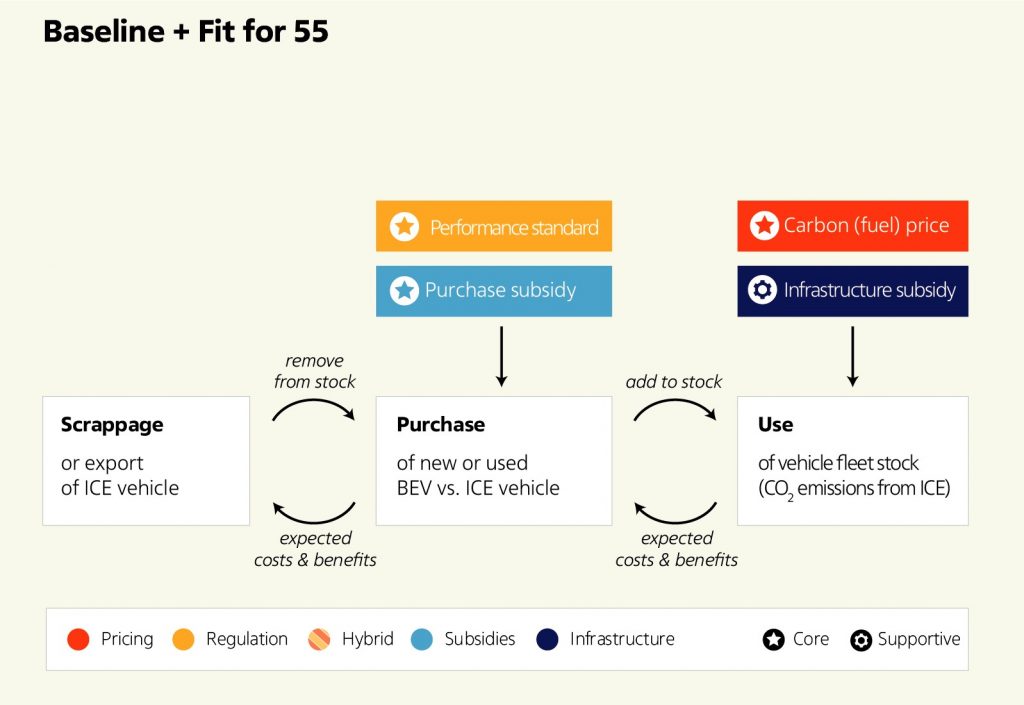
The baseline pathway utilises a combination of instruments focusing on purchase decisions and usage, but most instruments are currently at low stringency levels. The current mix design places emphasis on subsidising market diffusion of BEV and PHEV. It currently utilises pricing and regulatory measures at low stringencies, which does not significantly alter market dynamics in favour of BEV diffusion by 2030 or give sufficient incentive for reduced usage of ICE stock or scrappage. We describe and assess the main instrument designs utilised in the status quo policy mix including the anticipated changes to be implemented in the EU Fit for 55 package.
We assess the status quo pathway drawing on existing empirical analyses, modelling and evidence from the wider academic literature on design characteristics of instruments and mixes. The baseline instrument design features and assessments are outlined in Table 2. Having assessed the instruments in detail, we give an overall assessment of the baseline pathway, which is summarised in Table 3. We find that even with improved instrument design, the baseline pathway is very unlikely to deliver required GHG reductions in line with the 2030 targets.
Baseline – instrument design features and assessment
We describe and assess four main instruments which characterise the baseline pathway. We describe the four main instruments which make up the baseline pathway and assess their current implementation in Germany. In line with our challenges/assessment criteria outlined in section 3, in our assessment we prioritise environmental effectiveness above all other challenges, and we therefore primarily assess the baseline pathway on this basis.
Carbon (fuel) price – BHEG (nETS)The German carbon (fuel) pricing scheme in the road transport sector (nETS) is only legislated until 2026. It is not yet specified how it would evolve afterwards or if an ETS-2 will be put into place. While the current government’s coalition treaty suggests that some carbon (fuel) pricing will be in place, the future road transport carbon (fuel) price thus remains uncertain. We choose to represent a range of potential carbon (fuel) price outcomes in our analysis, based on modelling conducted in the Ariadne project (Pietzcker et al. 2021) at the upper end and the lowest price estimated/projected by the EU Commission (2021b) for ETS-2 at the lower end.
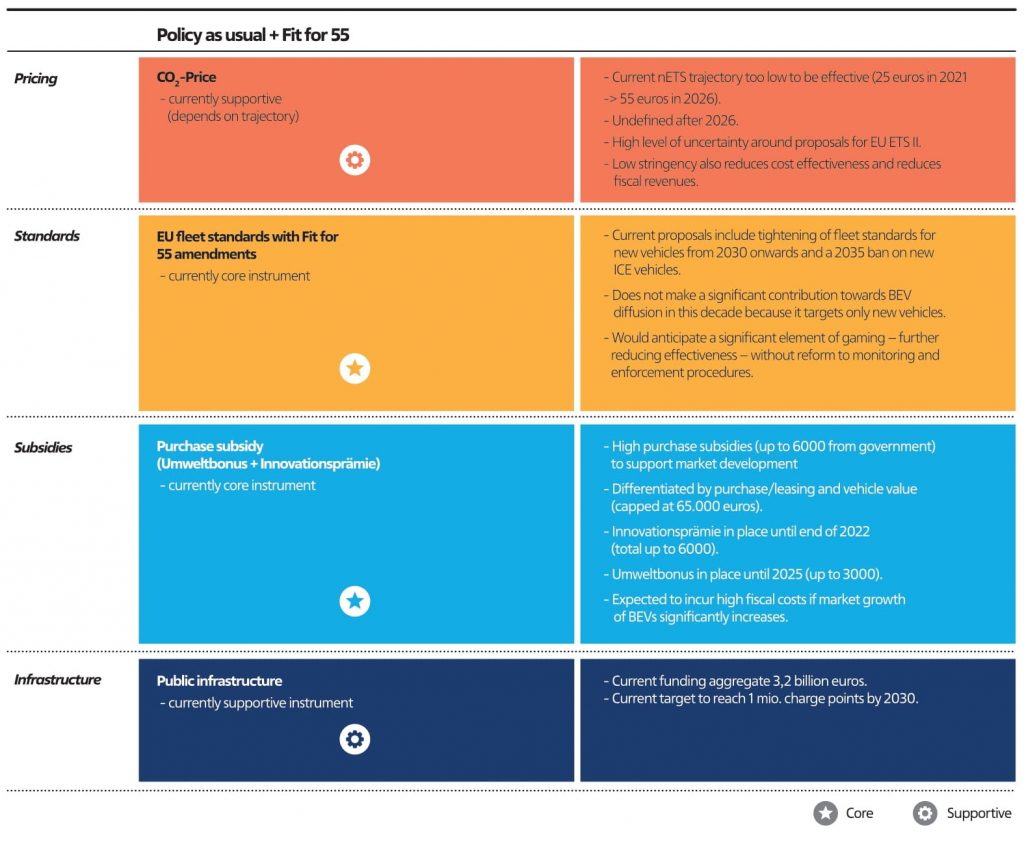
The envisaged nETS price ceiling from 2026 onwards – or an analogical ETS-2 price ceiling – can result in higher emissions than a firm emissions cap. If mitigation costs and thus carbon (fuel) prices turn out to be very high, and the envisaged price ceiling in the nETS is triggered, sector emissions might exceed the KSG target. Such shortfall might be compensated using various flexibility mechanisms, including overachievement of targets in other German sectors, EU intergovernmental flexibility mechanisms, as well as banking and borrowing provisions under the ESR. In case of a price ceiling in an ETS-2 and the analogical case of it being triggered, Germany might – in addition to these provisions – implement additional price (e.g. national carbon (fuel) price top-up) or non-price instruments (e.g. updating towards more stringent regulation or subsidies).
The low stringency and lack of nETS specification beyond 2026 impairs dynamic cost effectiveness. The current fixed price pathway below the level and rate of increase expected to be in line with delivering 2030 GHG targets (Edenhofer et al. 2019, Repenning et al. 2021) very likely fails to deliver a credible signal coordinating manufacturer and consumer investments levels that would maximize intertemporal cost effectiveness. In addition, uncertainty over price levels (price collar, type of pricing system at German or EU level) beyond 2026 will likely lead to underinvestment relative to the cost effective pathway (Ohlendorf et al. 2022).
The current nETS price trajectory to 2026 results in low fiscal revenues and the enacted revenue recycling mechanism is not progressive. Edenhofer et al. (2019) find the incidence of the nETS features an inverted U-shape in distributional impacts across income groups: while low and high income deciles experience relatively low additional expenditure, after revenue recycling, middle income groups bear the brunt of the burden. Yet overall distributive impacts are currently limited due to the low stringency. Other revenue recycling mechanisms such as lump-sum per capita recycling would yield more progressive distributional outcomes (Eisenmann et al. 2020; Kalkuhl et al. 2021, Budolfson et al. 2021).
Emission performance standards – EU vehicle fleet standards
Tightening of the EU vehicle fleet CO2-performance standard suggested by the Fit for 55 proposal does not significantly contribute to attaining German 2030 targets. The proposal for adjusting the 2030 average vehicle fleet intensity would make it roughly 15% more stringent than currently in place (EU Commission 2021c; Wappelhorst et al. 2021). In view of German 2030 GHG targets, the Fit for 55 tightening of performance standards will thus only contribute additional abatement after 2030 – changes in stringency remain constant over five year periods (and do not increase incrementally in-between). It will thus not help meet German 2030 targets beyond the current policy schedule. The main change introduced by Fit for 55 is that the standard effectively introduces an ICE vehicle sales ban in 2035. Many policy analysts have indicated that the suggested 2030 tightening might be inadequate in terms of scaling towards a 2035 ICE ban (Gimbert 2021; Wappelhorst et al. 2021)2Wappelhorst et al. (2021) recommend 25% more stringency.. In addition, incrementally increasing standards annually rather than in 5-year steps would support stock turnover more smoothly over time rather than stepwise. It would also achieve higher levels of carbon abatement from new vehicles faster by being cumulatively more stringent (Wappelhorst et al. 2021).
Improvements in monitoring vehicle CO2-performance are needed to avoid gaming. Current lab-based performance testing undermines the effectiveness of the vehicle fleet CO2-performance standards (Tietge et al. 2019; Reynaert 2021). Reforms to the monitoring and enforcement of this instrument are needed if this is envisaged to be a or the main instrument used for driving innovation and BEV sales. One option might be real time reporting of vehicle CO2-performance (EU Commission 2021c).
The current EU CO2-performance standards have a mildly regressive effect. The performance standard increases the cost of cars. Even though poorer households tend to drive smaller and more efficient cars and the impact on cost increases is low, it is still higher in proportion to their income compared to more affluent groups (Baldenius et al. 2021).
Purchase subsidies – Umweltbonus and Innovationsprämie
The Umweltbonus remains in place until 2025, and the Innovationsprämie until January 2023. As of February 2022, the current federal subsidies (of up to €6000 total) for BEVs will remain in place throughout 2022. From 1st January 2023, it is expected that the Federal contribution will drop to €4000, and in 2024 reduce to €3000, remaining in place until the end of 2025. If the market for BEVs substantially increases prior to 2025, this could incur high fiscal costs.
Umweltbonus and Innovationsprämie are associated with many BEV car purchases, even if no rigorous assessment attributing sales to policy instruments and in particular potential interactions with the vehicle fleet CO2-performance standards is available. Overall, nearly 900k vehicles have been subsidized in Germany (45% of which are PHEV, and 55% BEV) (BAFA 2021). Of the currently registered ~600k BEVs on the road in Germany, 83.4% were supported by subsidy. The number of registrations increased markedly after the value of the purchase subsidy increased in 2020, but careful empirical ex post analysis attributing the magnitude of the effects of these subsidies and separating them from effects of other policies and factors is not available and would be very useful. The high uptake has already led to substantial use of the earmarked €3.2 billion of funding to support the mechanism (as of February 2022).
Improved subsidy design could reduce windfalls and increase effectiveness. The number of vehicles that could be supported with the same amount of funds could be increased by reforming the mechanism. Projections for manufacturing and sales costs of EVs have indicated significant cost reductions throughout this decade, with price parity already achieved in some segments and other segments achieving competitiveness throughout the decade (BloombergNEF 2021; Transport & Environment 2021). If these cost decreases materialize, the current subsidy design is at risk of over-subsidising EV purchase by 2025. If it is continued, the subsidy value should be recalibrated annually to correlate with the price differential between ICE vehicles and BEV manufacture more closely.
Effectiveness of subsidies could also be improved through better targeting, which might also increase acceptance. Targeting different income groups has been demonstrated in the literature to improve the environmental effectiveness and cost effectiveness of the instrument through reducing windfalls. It also alleviates regressive outcomes by helping those who may otherwise be unable to purchase new vehicles, are otherwise forced to pay more to drive, or are excluded due to high costs. These reforms might also enhance the acceptance of this measure. Studies of the distributional impacts of the current subsidy schemes would be very useful.
Withdrawing support for PHEVs would achieve higher GHG abatement and increase intertemporal cost effectiveness. From 1 January 2023, the Umweltbonus will only be available for vehicles that demonstrably have a positive climate protection effect, which is defined by the electric driving share and a minimum electric range. Consequently, the alternative CO₂ requirement of a maximum of 50 grams CO₂/km will probably be dropped. A minimum range of 80 kilometres is to apply as early as 1 August 2023. While these changes are an improvement on current design, withdrawing support for PHEVs altogether would be more effective at delivering GHG abatement. Recent evidence has suggested that PEHVs do not achieve their anticipated emission reductions (Plötz et al. 2020). Valais, Switzerland, has recently withdrawn policy support for PHEV to focus on supporting BEVs (Borrás 2022), and there is currently debate if the rest of Switzerland will follow suit. Focusing on BEVs ensures that operational emissions match those anticipated. Similarly, focussing policy on BEVs would increase the intertemporal cost effectiveness by providing more clarity, and increasing investment in BEV technologies rather than PHEV which are not capable of achieving net zero emissions.
Infrastructure – public infrastructure provision
While the EV infrastructure target extends towards 2030, deployment support is currently scheduled until 2025. The current Electromobility Funding Guideline runs until 31 December 2025 and has a total volume of around 551 mio. Euros (BMVI 2022). The 2030 infrastructure target envisages 1 mio. Public charging points (KoaV 2021, p.51f)3KoaV (2021, p. 51f): „Ziel von einer Million öffentlich und diskriminierungsfrei zugänglichen Ladepunkten bis 2030 mit Schwerpunkt auf Schnellladeinfrastruktur…“ („Target of one million publicly and non-discriminatorily accessible charging points by 2030, with a focus on fast charging infrastructure…”). Nicholas and Wappelhorst (2020) collate existing modelling estimates of public charger-to vehicle ratios, indicating an average of around 1:13-14 in 2030. On that basis, current targets for infrastructure would be adequate to support the targeted 15 mio. electric vehicles by 2030, assuming some additional provision from the private sector.
Current deployment rates for public infrastructure are not sufficient to achieve 1 million public charging points by 2030. We focus on the ambition level as a proxy indicator for infrastructure, acknowledging that this is an imperfect approximation of current policy initiatives. We note however, the current deployment rates do not match ambition levels (as displayed in Figure 6 – Section 2), and implementation needs to be improved in line with the policy objective’s ambition. Assessing infrastructure policy is more complex than for the other instrument options for several reasons. First, infrastructure support is a package of instruments which includes both fiscal policy (deployment subsidies) and regulatory measures (i.e. mandates for current Autobahn fuelling stations to install charging points). These instruments are also implemented at both regional and national levels, which adds to the complexity. Therefore, aggregate funding is not a good indicator, since it is not possible to correlate current deployment rates with aggregate funding provision. We also do not have access to how much of the current funding provisions have been exhausted so cannot make an approximation for scaling based on current deployment. The subsidy rate per installed unit is also not a good indicator, since there is much higher uncertainty with regards to future cost trajectories of unit costs than for BEVs.
It remains an open question for how long government should actively subsidize or regulate private and public EV charging infrastructure expansion. It appears plausible that in the initial phase of the transition an active role of the state in expanding EV private and public charging is justified due to network externalities (Maurer 2022). Recent evidence from Norway (Koch et al. 2021) suggests that at some point markets can and will take over: earlier for private charging due to self-interest of users, and later for public infrastructures. When exactly these points are reached is currently not well understood (ANNEX I), and is an important area for further research. There are also indications that e.g. fuel station chains are beginning to adjust their business models (Stüber 2021). In addition, the state will have to play a role locally to (trans-)nationally in reducing micro-barriers e.g. in local spatial regulation or electricity network regulation, but in our analysis, we abstract from these (important) questions to retain focus.
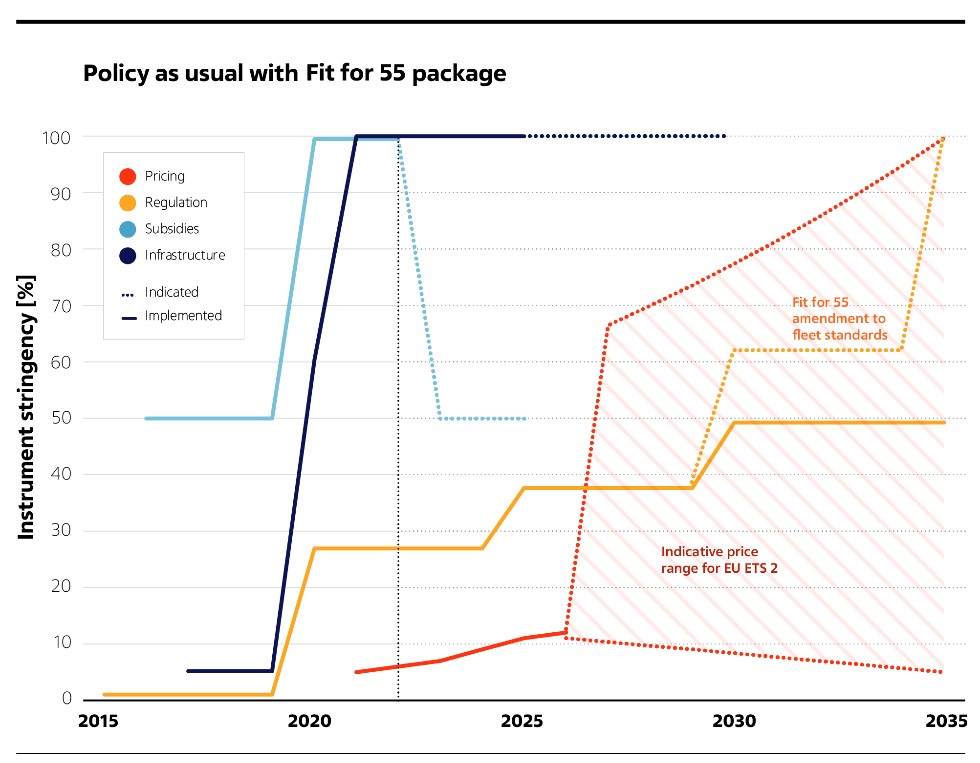
Carbon (fuel) pricing is much too low to be effective, with no future trajectory. As outlined above, the nETS stringency is currently much too low to have any noticeable impact on either the sales of BEV or emission reduction of the existing vehicle stock. Another key issue facing the nETS is the lack of clarity past 2026, which reduces the ability of the current mix to create a long-term signal increasing the credibility of the political commitment for substantive change in the sector before 2030.
Baseline – overall pathway assessment
The baseline pathway with currently adopted policies and Fit for 55 is insufficient to meet 2030 environmental targets. An assessment of the baseline pathway with regards to policy mix design challenges is summarised in Table 3. In general, if simply continued, the German road transport policy mix will not deliver the 2030 targets, which is mainly attributed to the relatively unambitious levels of stringency of two of the core instruments, the carbon (fuel) price and the emission performance standards. The emission projection report commissioned by the German government finds that – even when assuming extended and raised carbon (fuel) prices – the 2030 transport sector target will be missed by approximately 50% (projected emissions in 2030: 126 MtCO2, Climate Change Act sector target: 85 MtCO2) (Repenning et al. 2021).
Carbon (fuel) pricing is too low to be effective, and lack of future trajectory beyond 2026 undermines credibility and dynamic cost effectiveness. As outlined above, the nETS stringency is currently too low to have any noticeable impact on either the sales of BEV or emission reduction of the existing vehicle stock. Another key issue facing the nETS is the lack of clarity past 2026. The long-term clarity and credibility of future carbon (fuel) pricing is fundamental for intertemporal cost effectiveness, and to create a long-term signal for substantive change in the sector before 2030. Political commitment is needed to overcome consumer and producer myopia, drive innovation and price-performance improvements. While the German government is currently advocating adoption of the ETS-2 (Graichen 2021), the level and trajectory of mid- to long-term carbon (fuel) pricing remains unclear.
Vehicle fleet CO2-performance standards proposed in the Fit for 55 package are not sufficiently ambitious in view of German 2030 targets. Similarly, the current fleet standards are too low to have a significant effect. While there is more clarity about the fleet standards leading to 2030, the planned stringency levels are not capable of delivering the levels of abatement needed though incentivising BEV sales by 2030, allowing for more moderately incremental efficiency gains of ICE vehicles and/or the continued sales of hybrid vehicles.
Subsidies have been associated with BEV uptake but have high fiscal costs and no rigorous ex post evaluations are available. Subsidies could be tailored to become more cost-effective (achieve more additional EVs for same fiscal cost) and equitable. Continuous reliance on subsidies for driving the transition would likely entail very high fiscal costs.
Infrastructure plans are ambitious, but the effectiveness of current policies and the need and timing for sustained state intervention is unclear. Bauer et al. (2021) suggest that 1 mio. charging points by 2030 appear to be roughly in line with the target of 15 mio. vehicles. However, as pointed out recently by (BDEW 2021), technological change makes it difficult to precisely anticipate the number of charging points needed by the end of the decade, and therefore the infrastructure expansion targets should remain flexible to incorporate potential technology and market developments. Consequently, the effectiveness of current policies and planning processes as well as the need for continued state support in the next phase of the LDV transition is not well understood.
Revisions to these key instruments are urgently needed to achieve German GHG targets. The current rapid uptake in EVs might be driven to a significant extent by the Umweltbonus (+ Innovationsprämie). To continue these subsidies will be very expensive. If they are withdrawn due to high fiscal strain, the recent growth in BEV sales might decrease if other stringent policies are not implemented to sustain diffusion rates, as observed previously with the 2009 Abwrackprämie. Therefore, to support rapidly expanding BEV market growth, and to achieve higher GHG abatement by targeting the existing stock more directly, more ambitious mix designs are needed.
In case of adoption of the Fit for 55 proposal, environmental effectiveness would critically depend on design and effects of the ETS-2. In principle, an ETS-2 introduced 2026 and featuring very high prices might incentivize massive uptake of new BEV and reduce emissions from the existing ICE vehicle fleet. However, not only would this need to happen within only four years (assuming EU ETS-2 inception in 2026), it also requires political support across all EU member states covered by the scheme. Moreover, achievement of the German GHG target with an EU instrument would only occur by chance, as it is not calibrated to achieve that.
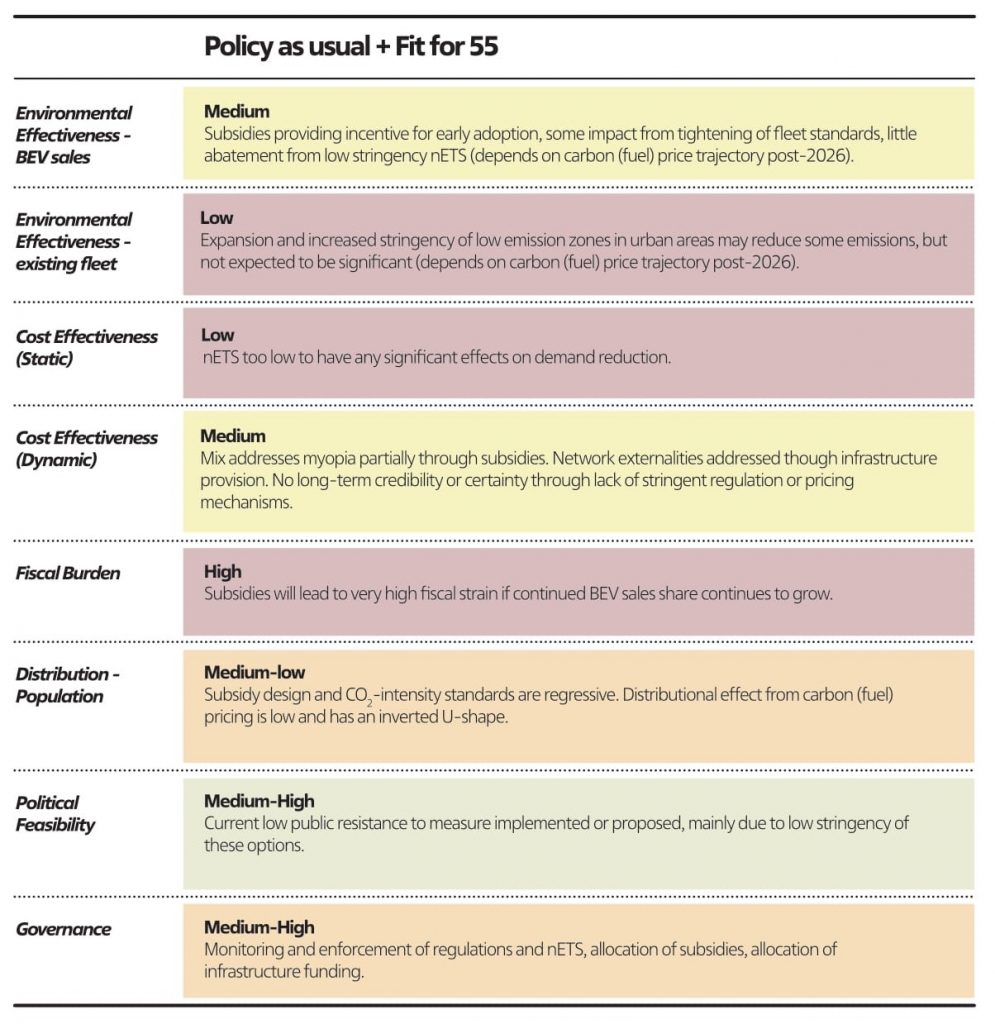
5. Alternative policy mix pathways
Characterizing three policy mix pathways to achieve the 2030 GHG sector target. Our assessment of the baseline pathway revealed insufficient abatement to deliver the German 2030 transport sector GHG and EV deployment targets, while incurring high fiscal costs. We now propose three alternative policy mix pathways that promise higher GHG abatement, while lowering fiscal costs and increasing cost effectiveness. For each mix, we first specify the configuration of policy instruments over time and discuss important effects with respect to the transition challenges and interactions among instruments (with detailed descriptions and the quantitative specification in Annex [III]).
We assess each pathway separately across three periods (up to 2025, 2025-2030, and 2030-2035). We extend the analysis until 2035 as this is the envisaged date for phasing out new ICE vehicles according to the Fit for 55 proposals. The initial period is an enactment phase 2023-2025 where status quo is recalibrated through implementing reforms. The following period is 2025-2030, which represents the remaining time to scale up the pathways to attain the 2030 sectoral targets. The final phase is 2030-2035 which represents a period at which all instrument pathways are operating at high stringency and effectiveness, and placing significant pressure on the scrappage of ICE, rapidly accelerating the LDV transition. We extend the analysis until 2035 as this is the envisaged date for phasing out new ICE vehicles according to the Fit for 55 proposals.
We label pathways by the differing role of carbon (fuel) pricing. In the first pathway (“Fuel focus”), carbon (fuel) pricing is the core instrument which significantly increasing fuel prices. This pathway assumes additional market and network failures are not very significant, and complementary policies are phased out quickly. In the second pathway (“Stock focus”), direct carbon (fuel) pricing (fuel) plays less of a role and is a supportive instrument mainly targeting demand reduction of existing stock, while other instruments deliver the main stimulus for BEV sales and ICE vehicle scrappage. In the third pathway (“Mix”), carbon (fuel) pricing is a core instrument but the trajectory starts at a lower level and then ramps up quickly over time. It is supported by additional instruments with higher initial stringency to overcome challenges hampering market growth of new BEV sales and compensating for the initially moderate carbon fuel price. Accordingly, the stringency ranges of carbon (fuel) pricing varies across the pathways, reflecting the different roles that the instrument fulfils in these mixes (Figure 11).

Each alternative pathway offers higher environmental effectiveness and lower fiscal burden than the baseline pathway. We design each pathway to lower the fiscal burden on the state and to deliver GHG abatement in line with 2030 German sector GHG 15 mio. BEV and 1 mio. EV charging station targets. Carbon (fuel) pricing and hybrid instruments (regulatory instruments featuring vehicle purchase and ownership taxation) are core instruments across the pathways. Resulting revenues from vehicle and fuel pricing can be used to fund subsidy policies or can be redistributed to provide more progressive distributional effects. In the mix options that continue to support purchase subsidies (‘Mix’ and ‘Stock focus’) the costs of financing these ‘Bonus’ instruments are supported by the revenues of complementary pricing mechanisms (‘Malus’).
We do not incorporate an own proposal for reforming EU vehicle fleet CO2-performance standards due to design and implementation challenges. Even at the levels of stringency suggested in the Fit for 55 proposals, we only expect these standards to make a limited contribution towards the attainment of the 2030 targets. Much more ambitious standards would be needed to make a significant contribution to GHG abatement before 2030, including a design reform towards incrementally (annually) increasing targets (Transport & Environment 2021). Moreover, the fleet standards are currently susceptible to issues of gaming (Reynaert 2021), and exploitation of flexibility mechanisms (Tietge et al. 2021), which create a performance gap between estimated and observed effectiveness requiring urgent reform and where it remains open if they can be effectively resolved. These design and enforcement reforms require consensus among member states, and imminent implementation to have a significant effect before 2030. More importantly, even if implemented these reforms are unlikely to align with Germany’s ambitious 2030 targets. Therefore, our pathways consider policy options that Germany can pursue nationally, the assumption being that there are greater prospects for more ambitious reforms, both in terms of stringency and implementation time.
The Fit for 55 EU vehicle fleet CO2-performance standards are considered as a residual instrument in all of our mix options. We have designed each pathway to be significantly more ambitious than Fit for 55 EU fleet standards. Moreover, aforementioned issues with design and implementation of these standards render them a sub-optimal instrument option. In the ‘Fuel focused’ pathway, a highly stringency carbon (fuel) price is utilised which is expected to generate a strong incentive for both manufacturers and consumers, instigating diffusion of BEVs at a more ambitious rate than the fleet standards. In our ‘Mix’ pathway, we use a purchase Bonus-Malus mechanism instead for supporting early BEV market growth. This mechanism benefits in three main ways, revenues, flexibility mechanism in price scaling, and more simple design. This means that while it is still reliant on accurate testing procedures being in place and therefore still vulnerable to gaming, issues associated with the exploitation of flexibility mechanisms are mitigated. The ‘Stock focused’ pathway uses a ZEV mandate placed on manufacturers as a core instrument. This benefits from greater transparency and does not rely on emissions testing, which alleviates gaming issues. These designs render fleet standards a residual or redundant instrument across all pathways.
Within their respective logic, all pathways are constructed to aim at “optimally” addressing sector challenges. Our design proposals are based on available academic (see Annex [II]) and policy literature – on how to maximize each pathway’s performance with a view to meeting the transition challenges. A key objective of this report is to invite challenges of and debate about (a) the logic of alternative policy mix pathways, (b) their precise specification given different challenges or assessment criteria, and (c) the analysis of effects of instruments and their interactions, which ideally would be quantitative using suitable models incorporating important effects.
The three policy mix pathways contribute to delivering the 2030 GHG sector and BEV deployment targets by assumption but differ in how they address sector transition challenges. All pathways assume identical mitigation cost uncertainty. We assess each of them with respect to our LDV transition challenges and conclude by comparing key risks of the mixes in Section 6.4.
5.1. Fuel focused carbon pricing (Fuel focus)
Fuel focused design
This policy mix pathway utilises carbon (fuel) pricing as the single main instrument, which proponents argue can maximize cost effectiveness, if additional challenges do not play a significant role. This pathway emphasises carbon (fuel) pricing to stimulate transition, with vehicle purchase decisions being influenced by second order effects which affect the behaviours of consumers (Figure 12). The primary rationale is to maximize static economic cost effectiveness by incentivizing all mitigation options via explicitly establishing the full marginal abatement costs. If the market or policy failures as identified in Section 3 are not significant or pervasive, this could work out well. However, if challenges are significant and persistent, cost effectiveness and even environmental effectiveness (e.g. if targets, or price signals, are relaxed in reaction to political backlash) are impaired relative to the other pathways. The high prices in this option are expected to have significant effects both on the use of the existing vehicle stock and on vehicle stock turnover, i.e. increasing BEV sales. This pathway also minimizes fiscal burden by quickly phasing out subsidies and infrastructure support measures. It generates significant revenues enabling targeting distributional outcomes via revenue recycling.
High carbon (fuel) prices are required immediately and will rise over time. An immediate price hike via an adjustment of the nETS would help improve short-term environmental effectiveness, in order to sustain market growth of EVs while phasing out subsidies. However, there remains some uncertainty over the short-term response (price elasticities), so a flexibility mechanism would have to be incorporated to allow for fluctuation in case of a continued fixed price. In a cap-and-trade system such as the envisioned ETS-2, this would happen automatically. The initial carbon (fuel) price hike can be implemented by adjusting the nETS, either by directly increasing the fixed price or enabling free floating prices (Pahle et al. 2022). In the mid- to long-term, the nETS might continue or be replaced by an EU ETS-2, which might need to be supplemented by a national German carbon (fuel) price top-up in case national GHG targets are to be achieved but the ETS-2 price remains insufficient. In case the nETS or an ETS-2 would feature some maximal price level which is attained, the resulting shortfall in mitigation would need to be achieved either via other policy instruments in the sector, or outside the sector. Otherwise, the environmental target is missed.
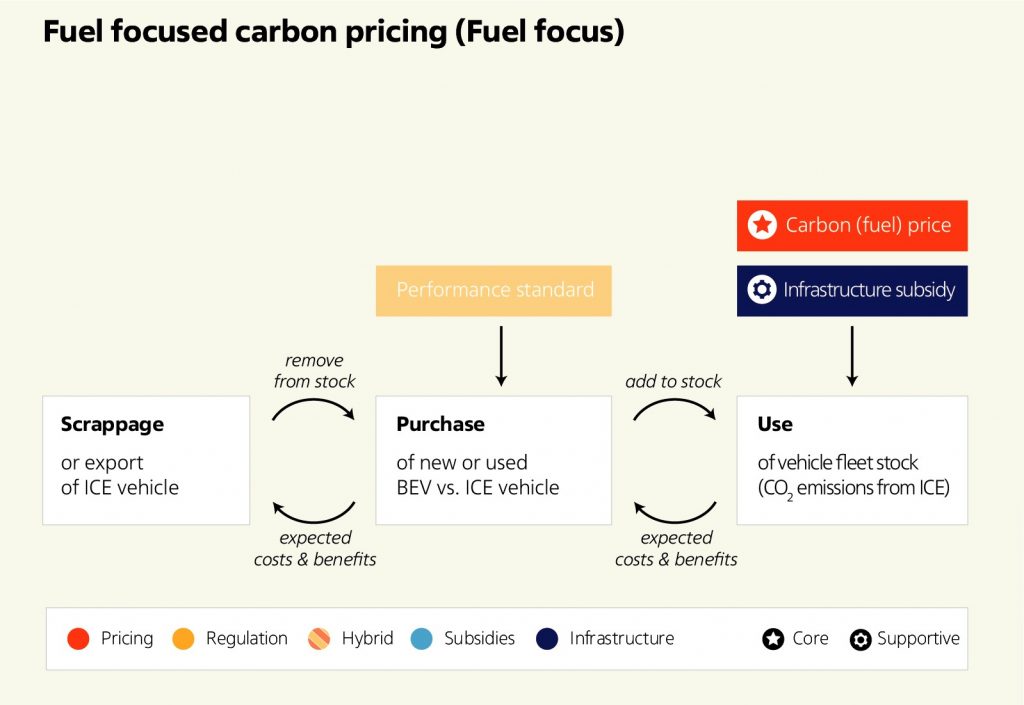
Another rationale is to reduce administrative and informational burdens on the state. The main administrative responsibilities of the state are to monitor and if necessary, update the pricing mechanism. The other main area of responsibility is to actively maintain and operate the targeted revenue redistribution mechanism in place to alleviate the distributional impacts that high carbon (fuel) pricing would have on the population.
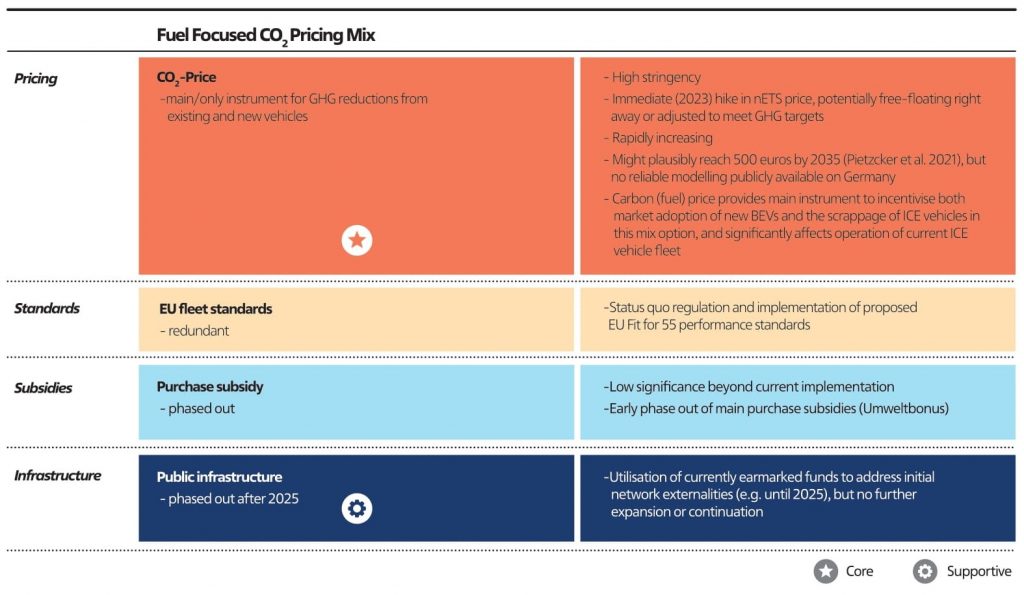
This mix option includes the EU Fit for 55 proposals for performance standards but they are expected to become redundant. This choice is mainly to avoid generating further political feasibility issues arising from decoupling Germany from the EU proposals. However, under the design rationale of this mix option, the price alone should be high enough that BEV sales will be incentivized and are expected to exceed the rate mandated by the fleet standards.
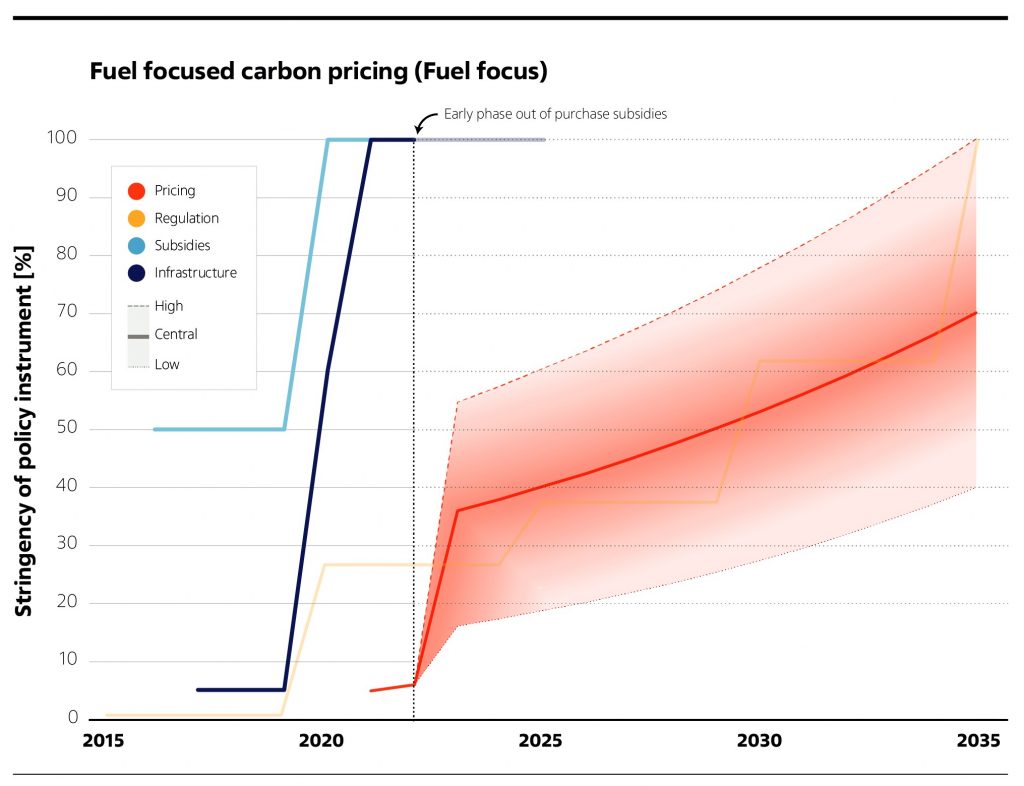
The national vehicle purchase subsidy program would be phased out immediately. In this mix carbon (fuel) pricing is intended to be a more cost-efficient measure towards incentivizing early market adoption because the existence and magnitude of additional market failures is expected to be much lower.
This mix option does not extend current support for infrastructure provision beyond 2025. The rationale is that a private sector market for infrastructure provision will have time to develop by then, incentivised by the high and increasing price signal.
Fuel focused assessment
The environmental effectiveness of this mix option in stimulating BEV sales is strong. The rapidly increasing carbon (fuel) price provides a significant immediate incentive for reducing the use and number particularly of ICE vehicles. Uncertainties around short-term elasticities may require even higher short-term price hikes than estimated here if emissions are to be reduced immediately. There is less uncertainty over the longer-term response to pricing and it appears reasonable to expect it will be very effective – assuming the required high carbon (fuel) price levels can be maintained politically (see below).
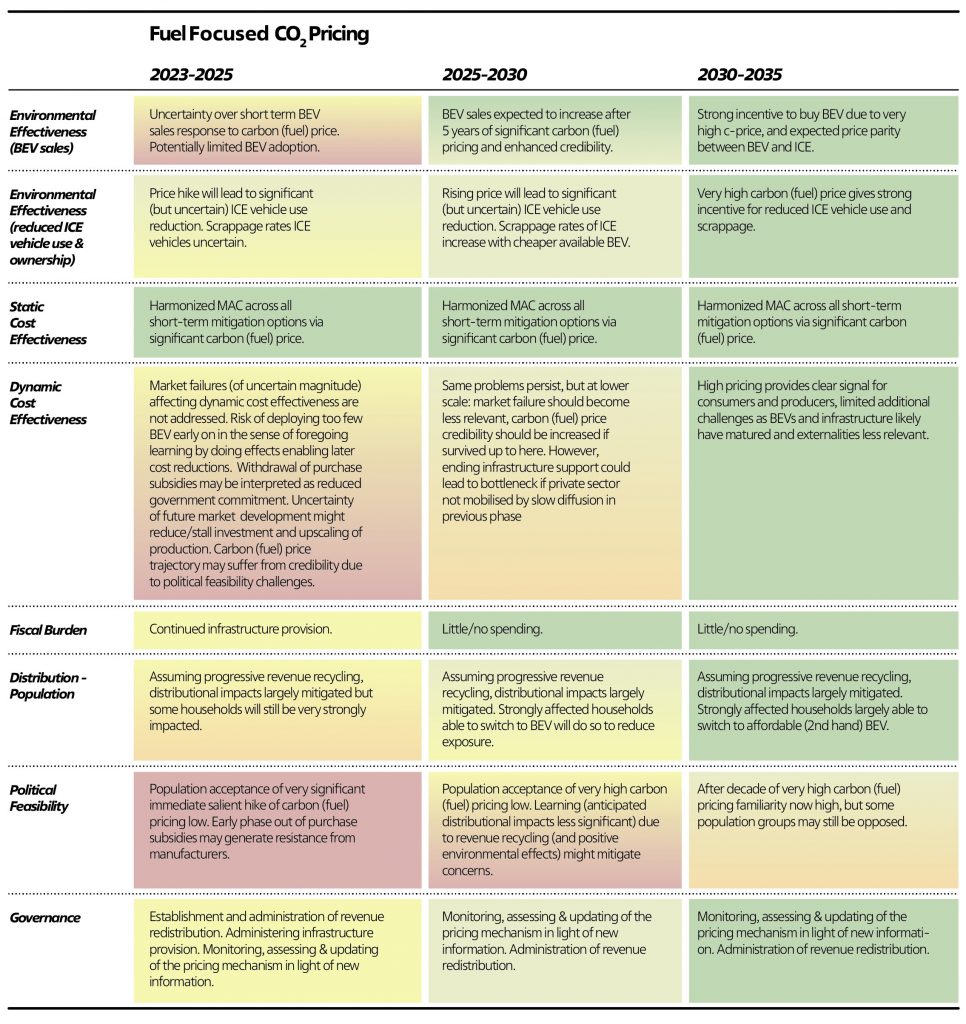
The dynamic cost effectiveness of this pathway is dependent on the magnitude of additional market failures. Static cost effectiveness (harmonization of MAC) within the sector is ensured by reliance on fuel carbon pricing incentivizing all short-term abatement options. Carbon (fuel) pricing can also be a dynamically cost-effective instrument, providing there are minimal unanticipated additional market failures. It also assumes the price gives enough credibility to direct the actions of firms. If these market failures exist at significant scale though, this mix is not dynamically cost effective as they are not addressed. Too few BEV may be deployed early on relative to an optimal case taking into account e.g. learning-by-doing spillovers. It is unclear if the current infrastructure provision and the credibility of a high price signal are enough to create a private market for infrastructure given uncertain network externalities, but we assume current support stays in place and is sufficient. Also, it remains open if the German government can credibly commit to a highly ambitious carbon (fuel) pricing pathways for at least a decade given expected political challenges (see below).
This mix option has a low fiscal burden for the government. This mix option involves some initial expense in supporting infrastructure roll-out until 2025, but this is phased out after this initial period. The pricing mechanism would instead create revenues, rather than incur costs on the government. The revenues would be primarily used in the revenue recycling mechanism to offset the distributional impacts of high carbon (fuel) pricing. Some percentage of the revenues could be used to support other policy objectives.
The distributive effects of this mix option could vary significantly. Distributional impacts are dependent on the design and implementation of the carbon (fuel) pricing revenue recycling mechanism. The analysis by Kalkuhl et al. (2021) suggests that lump sum recycling complemented by targeted compensations (e.g. Fernpendlerpauschale) can ensure progressive outcomes on average. However, even with generally progressive revenue recycling in place, some low-income houses with high gasoline/petrol consumption, who cannot afford to switch to BEV and have fairly inelastic demand for LDV transport, will be negatively affected. This will result in concentrated regressive impacts within these population groups. Moreover, some households may lose because their properties are insufficiently known to the government to implement targeted compensation. In case a very high carbon (fuel) price signal is implemented via an EU ETS-2, backlash from population segments with lower per capita GDP and higher fuel expenditure shares can be expected unless effective compensation mechanisms are put in place (Held et al. 2022).
Political feasibility appears low due to high salience of carbon (fuel) pricing and potential hardships where revenue recycling works imperfectly. Currently, there is little support for strong increases in carbon (fuel) pricing in Germany and the current coalition treaty rules this option out. Low support for pricing originates from several viewpoints (Sapienza and Zingales 2013; Douenne et al. 2022; Sommer et al. 2022). Primarily, doubts or underestimation of potential emission reduction effects. Secondly, skepticism that government will redistribute the revenues from carbon pricing. Finally, overestimation of impacts on personal net costs, and impacts on the poorer parts of the population. The key risk of this pathway is that there will be sustained and strong political opposition to hiking carbon (fuel) pricing, which prevents prices to rise high enough for sustained adoption of BEVs in the short-midterm. Even when sufficient price levels are achieved, there might be a political backlash, in particular when compensatory measures are not implemented with sufficient quality or pace. Backlash may result in reduced ambition (e.g. as in the case of France after the yellow vest protests), or even termination.
Some administrative requirements exist but are generally low to moderate. These include updating and management of the pricing mechanism and the management of revenue recycling and targeting. Overall, governance requirements remain relatively slim.
5.2. Stock focused carbon pricing (Stock focus)
Stock focused design
The main rationale of this policy mix pathway is that core policies (ZEV mandate, bonus-malus systems for purchases and existing vehicles) focus on stock turnover dynamics and related market failures and challenges, while moderate carbon (fuel) pricing acts as a supportive instrument. This pathway focuses on policies directly addressing stock turnover decisions to drive the transition and tackle market failures related to scrappage and purchase decisions (Figure 14). A moderate carbon (fuel) pricing trajectory contributes some emission reductions by incentivizing demand reduction from the existing ICE vehicle stock but is not a core instrument. A ZEV mandate combined with fiscal malus (tax) and bonus (subsidy) instruments on new purchases, and a rising significant vehicle tax on the stock of existing vehicles, are the key instruments to incentivize sales of new BEV (relative to ICE vehicles) and to phase out ICE vehicles from the stock.
A national ZEV sales mandate is implemented as a core instrument to ensure environmental effectiveness by accelerating the diffusion of BEVs. A national ZEV sales mandate ensures an increasing diffusion of BEVs. The mandate requires car manufacturers to sell a certain proportion of ZEVs of the vehicles they produce4This instrument type was first introduced in California in 1990, and versions have since been implemented elsewhere in the US, regionally in Canada and as a national regulation in China., or face penalties. The mandate might be introduced in 2025 at moderate stringency but could scale-up quickly leading to an ICE vehicle sales ban e.g. around 2030 (see Annex IV). Such an ambitious national ZEV sales mandate would render EU vehicle fleet CO2 performance standards redundant in Germany, by requiring a much more rapid increase in BEV sales.
The ZEV mandate is a more transparent regulatory mechanism than fleet standards, which mitigates gaming and evasion. The ZEV mandate has much more transparent reporting and monitoring requirements than performance standards, which are reliant on accurate vehicle emissions performance testing. Accordingly, the mandate is more robust, and less susceptible to gaming (Reynaert 2021; Tietge et al. 2021).
The ZEV mandate should feature a tradeable quota scheme to maximize cost effectiveness. This enables manufacturers to trade permits between each other in a competitive market, which has been demonstrated to improve cost effectiveness by expanding flexibility across manufacturers (Greene et al. 2014; Lutsey et al. 2015; Sykes and Axsen 2017; Ou et al. 2018). A ZEV sales mandate ensures a market trajectory, which helps address producer myopia by providing more certainty. The mandate establishes a trajectory which does not require annual readjustment and recalibration, which provides more certainty than a pricing or hybrid mechanism with fluctuating prices to deliver BEV diffusion. This helps reduce risk and increase investment, which can improve dynamic cost effectiveness. However, in the event that BEV costs are notably higher than anticipated today, an ambitious mandate could lead to increased/politically prohibitive costs for consumers. In a worst-case scenario, the mandate might need to be relaxed to appease political acceptance tensions.
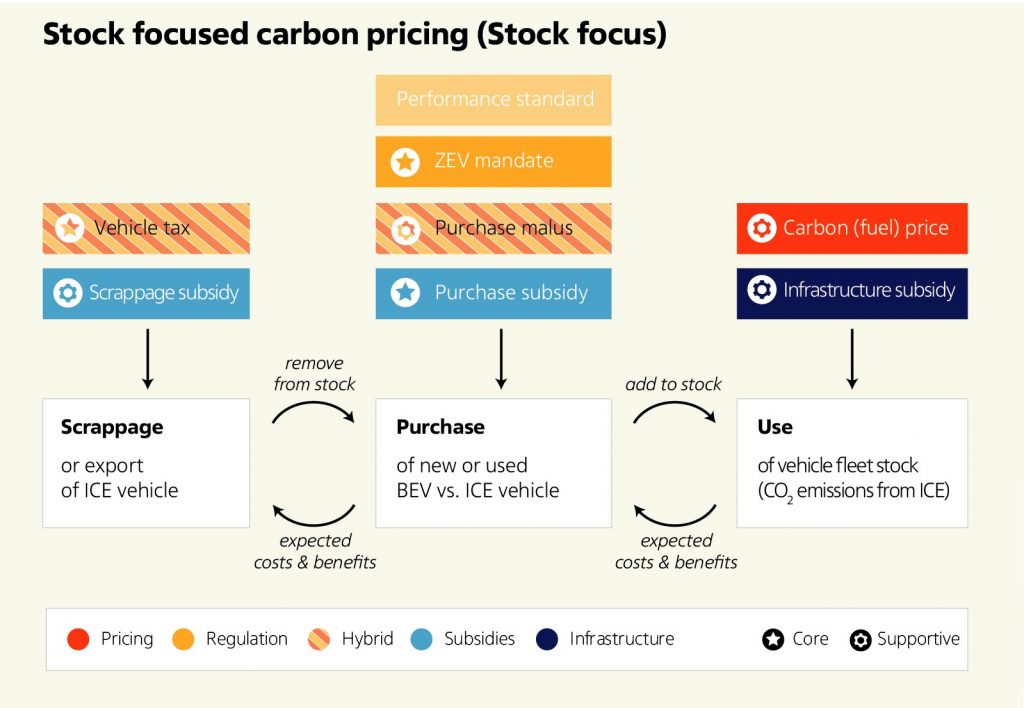
Company cars could be targeted first with ZEV requirements to improve distributional effects. Company cars currently represent 65% of new vehicle sales in Germany (Transport & Environment 2021). Implementing more stringent requirements for ZEV purchases on company cars, shifts the emphasis on to firms (rather than individual consumers) to drive uptake of new market sales. Company cars also have a higher turnover rate, which has the added benefit of creating a large number of used vehicles relatively quickly, making BEVs more affordable for broader population groups sooner by creating a second-hand car market.
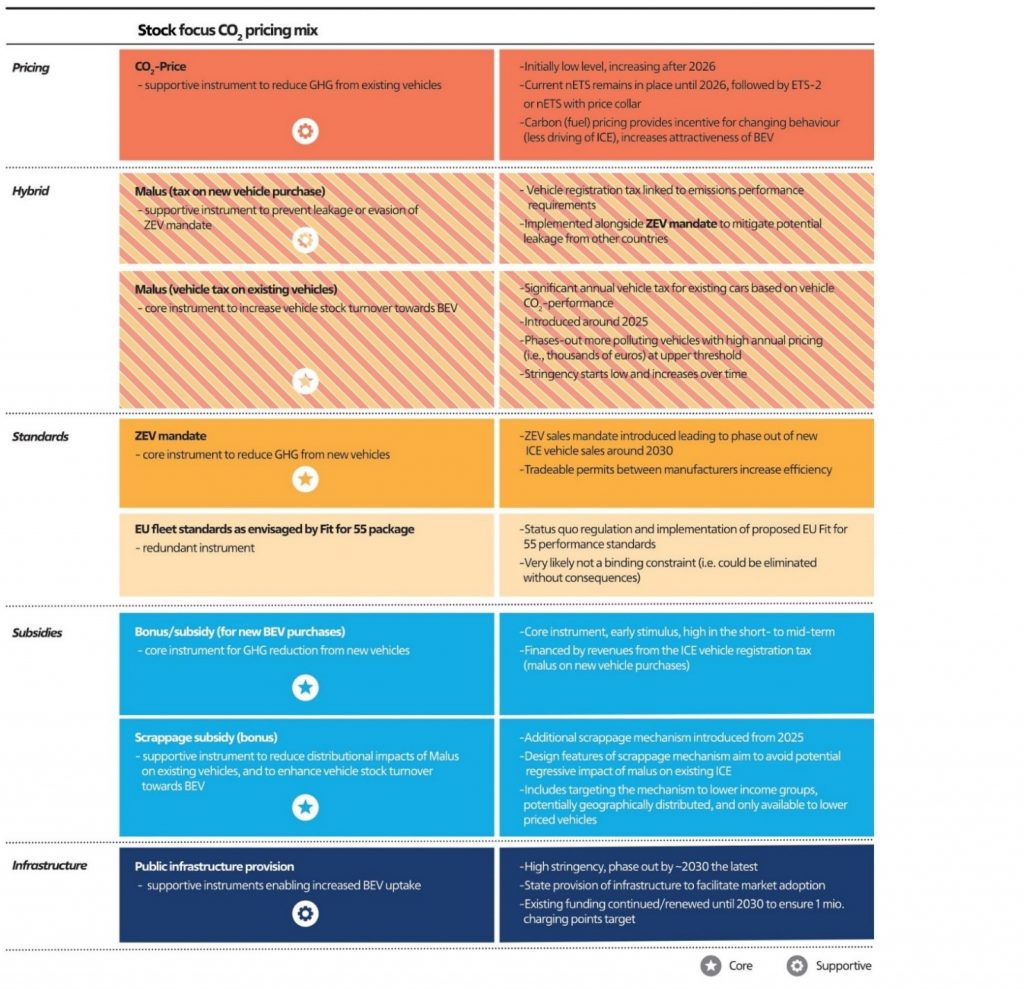
The ZEV mandate is supported by a bonus-malus mechanism for new purchases. Bonus-malus mechanisms involve introducing stringent vehicle purchase taxation of ICE vehicles and using part of the revenues to subsidise the purchase of new BEVs5To date, Bonus-Malus mechanisms have been implemented in France, Sweden and Italy (République Française 2020; Transportstyrelsen 2022; Tomo 2020).. Current designs involve different rates depending on the CO2 emission intensity of vehicles and differ in terms of vehicles included in the taxation rate. For example, the malus in France currently only applies to vehicles over 128g/km CO2 and increases exponentially in increasing vehicle CO2-intensity, with an upper tax rate of 40,000 euros for vehicles over 223g/Km (République Française 2022).
The registration tax (malus) is needed to reduce potential leakage, since a ZEV sales mandate alone is susceptible to leakage effects due to the EU’s single market. If ZEV mandates are implemented for sales as point of regulation – as is standard practice where these are implemented (an alternative might be registrations as point of regulation), they may be susceptible to leakage effects. Given the EU’s single market, consumers might circumvent a national ZEV mandate likely leading to higher ICE vehicle prices set by manufacturers to disincentivize purchases by purchasing ICE vehicles at lower costs in neighbouring countries and registering them in Germany. A registration tax (malus) applying to new ICE vehicle registrations and increasing in vehicle CO2-intensity adds an incentive for consumers to reduce CO2-intensive ICE vehicle purchases (and registration) and thus reduces incentives to evade a ZEV mandate. The malus (tax) also generates additional revenues while providing a price-based incentive for behavioral change. Issues associated with correct CO2 classification of vehicles exist, as for the performance standards, but are less detrimental for environmental effectiveness as the mechanism plays a supportive role to address leakage, is not the primary mechanism for BEV sales delivery and might be re-calibrated to ensure environmental targets are achieved. Leakage effects are not expected to persistent since anticipated cost reductions in BEV manufacture estimate they will be cheaper to purchase than ICE vehicles by 2027 (Bloomberg NEF 2021). However, if anticipated costs reductions do not materialise as quickly as predicted due to component shortages, then the registration tax will significantly dampen leakage effects.
Fiscal costs of bonus-malus system can be designed to remain very low. A key benefit from a bonus-malus is increased tax revenues supporting the subsidisation of new vehicles, reducing fiscal strain of supporting market growth, with related benefits in enhanced learning by doing externalities and reduced consumer myopia issues. Moreover, the malus (increased tax) also creates an incentive to guide behavioural change as well as subsidising EV purchases. Proportionately, this means that even at a lower subsidy rate, EVs become more attractive as they are not subject to the Malus.
The bonus (subsidy) for BEV purchases includes increased targeting than current design, which increases effectiveness and cost effectiveness. Targeting for bonus provisions which exclude higher income groups improves the cost effectiveness of the mechanism, by reducing windfalls to those consumers who would have purchased a new vehicle anyway. This could be implemented via submission of a tax return for eligibility (like Kindergeld). Potential benefits should motivate recipients to provide required forms, and should not add much administrative complexity to authentication and approval of application. Doing so also reduces the potential for negative interactions with the ZEV mandate, and places more emphasis on manufacturers to internally subsidise to drive the uptake of luxury cars to more affluent consumers.
The bonus (subsidy) for BEV purchases may be phased out sooner due to internal manufacturer subsidisation driven by ZEV mandate. Since a ZEV mandate requires internal subsidisation of sales BEV prices by manufacturers (i.e. reducing costs of ZEV to stimulate sales, cross-financed by higher costs of ICE vehicles), this may lead to lower BEV prices sooner, which means that additional market subsidization has the potential to be phased-out sooner than in the “Mix” pathway (see below). Effectively, with a ZEV the bonus-malus mechanism can be expected to be implemented by manufacturers instead of the state. In that sense, the ZEV mandate can be considered a stock pricing instrument alike the bonus-malus purchase and ownership/scrappage mechanisms with positive (taxes) and negative (subsidies) stock pricing. A vehicle tax on the existing fleet is also needed to mitigate leakage on the new car market, and incentivise scrappage of ICE. The bonus-malus mechanism for new vehicles only targets new vehicles, and if implemented independently, and without high stringency carbon pricing to disincentives continued ICE vehicle usage, we would expect to see leakage in the used car market, and potentially a decline in the number of sales of new vehicles domestically. To mitigate this potential outcome, this pathway also uses a second bonus-mauls system, applying to used vehicles. This bonus malus consists of an annual road tax which increases proportionally to the age and emissions performance of the vehicle, and a scrappage subsidy which can be used against the purchase of BEV (new or used) when an ICE is traded in and removed from the existing stock.
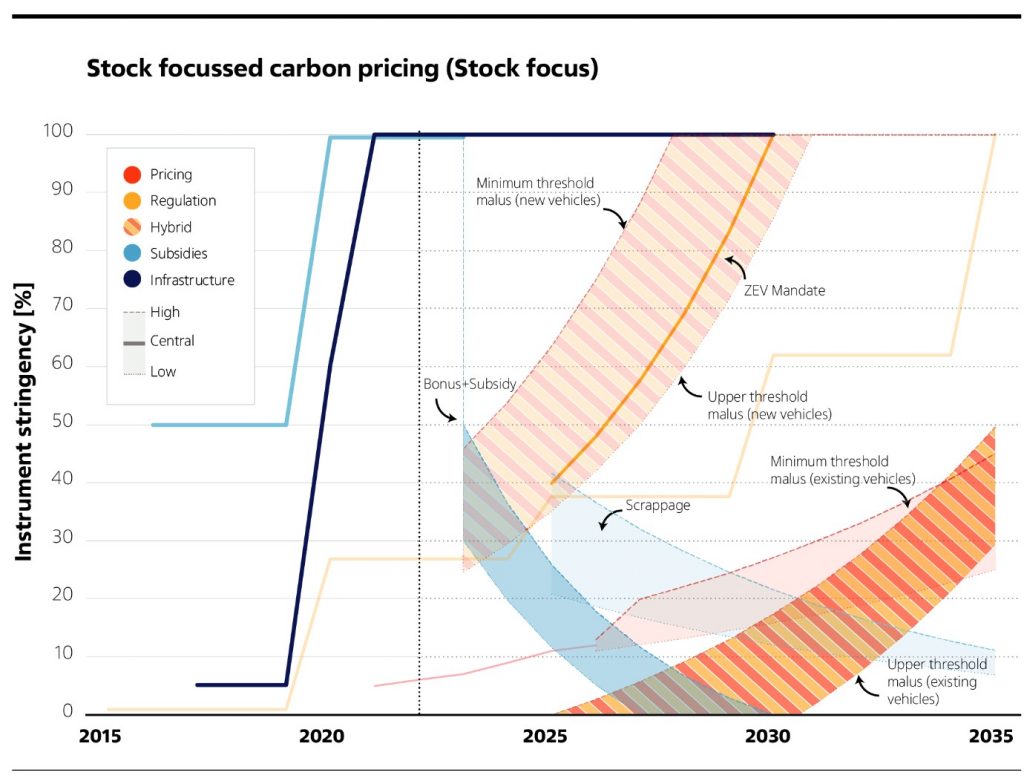
A second malus (vehicle ownership tax) on existing vehicles incentivizes the removal of ICE vehicles from the current stock/fleet and prevent leakage in the used car market, and is a core instrument to ensure this phase out. This pathway proposes raising annual vehicle taxes to significant (unprecedented levels), increasing in relation to the CO2-performance rating of a vehicle. Similar to the registration tax for new vehicles, the instrument design would have a taxable emissions range. At the low threshold (e.g. initially 200g/km), a modest tax rate would apply, which could increase exponentially over time. An upper emissions limit might be introduced later (e.g. 2030), incurring a very high fiscal penalty (potentially thousands of euros per year). This would act as a strong deterrent to effectively phase-out older and more inefficient cars from the vehicle stock, since in this mix the carbon (fuel) pricing trajectory is set too low to achieve this in line with GHG targets. The stringency of the emissions tax range should be scaled-up to achieve a complete phase-out of ICE vehicles, potentially around 2040. Without such an instrument in the mix, GHG emission reduction targets for 2030 and beyond would likely not be achieved since the lifetime of existing ICE vehicles would be extended – given potentially higher costs of (all) new vehicles, and relatively low costs of gasoline and diesel absent significant pricing of carbon contained in fuels.
A scrappage support mechanism increases stock turnover and reduces potential distributional impacts of the malus on existing vehicles. A scrappage mechanism would be implemented to provide additional incentives for stock turnover. The mechanism could use revenues from the malus (annual vehicle tax) on existing vehicles, so needs not incur fiscal costs on the state. The malus could also support consumers worst affected by malus (existing vehicles) and who would otherwise be unable to switch to a BEV due to financial constraints.
The scrappage mechanism can be designed to target vulnerable groups. The scrappage mechanism could be geographically differentiated (as suggested by Holland et al. 2016), targeting more rural areas first with less availability of alternative low-GHG transport options. Eligibility of applicants could also be assessed based on demographic information such as income group. Making the scrappage mechanism applicable to second-hand cars may also increase its effectiveness at targeting low-income groups, since these vehicles will be more available later in the decade. This mechanism could also include funding for electric retrofit of existing ICE vehicles6France has implemented a subsidy for supporting the retrofit of existing ICE vehicles of 5000 euros., which could reduce additional GHG from manufacturing new vehicles, and provide a lower cost alternative for zero emission LDV mobility.
Infrastructure provision is continued until 2025 and reviewed afterwards. We consider the targets for infrastructure provision appropriately stringent for now, but the evidence base for this judgment is low. Even with a much more ambitious market share of EVs by 2030 and 15 mio. EVs on the road, the planned provision of public charging points should be enough to support this new market (as discussed in the baseline Section 4.2). We expect that, compared to the baseline, increased certainty and BEV uptake would instigate more interest from the private sector, who would continue the expansion of charging infrastructure through Vehicle-to-Grid (V2G) solutions, since the investment carries much lower risk and promises higher returns on investment due to the higher demand for charging infrastructure. If there is significant growth in the private sector for infrastructure provision, state support can be phased out sooner than 2030.
Stock focused assessment
This option is likely highly effective for incentivising BEV sales. ZEV mandates have been found to be an effective instrument for incentivising BEV sales (Bhardwaj et al. 2022; Sykes and Axsen 2017). In addition, the initially high and sustained subsidies make this option likely highly effective at incentivising BEV sales in the short-term. The ZEV mandate and bonus-malus mechanism have combined effects of stimulating new sales while removing old cars from use. One study indicates that the interaction between a subsidy and EV sales mandate is unclear as the subsidy might just offset some of the intra-firm cross-price subsidisation that automakers might perform to comply with the EV mandate (Wolinetz and Axsen 2017). However, in this mix, the bonus and scrappage mechanisms include targeting, and are not freely available to all purchases, so such effects are expected to be reduced. From 2030 the sales of ICE would be banned. An implementation challenge is CO2-intensity classification of ICE vehicles for the purchase malus, very much alike related challenges (and options to address these) with EU vehicle fleet CO2-performance standards discussed above.
While this pathway is likely effective in removing ICE vehicles from current stock, it is less effective at incentivizing travel reductions from the current ICE vehicle fleet. After the introduction of a malus on existing vehicles, GHG emission might decrease significantly if the annual vehicle tax malus quickly leads to early retirement of significant fractions of the ICE vehicle fleet. In 2019, 39.5% of vehicles registered on the road in Germany (18.9 mio. of a total 48 mio.) were over 10 years old (KBA 2021). Phasing out these older and more inefficient vehicles should have a significant effect on GHG emissions. However, prior to its implementation, GHG abatement from the existing fleet is expected to be low. There is otherwise limited incentive to reduce ICE vehicle driving as the carbon (fuel) price remains moderate. This shortfall in short-term GHG abatement (compared to ‘Fuel Focus’ with very high levels of carbon (fuel) pricing) may need to be compensated by higher vehicle fleet turnover rates towards BEV, or increased efforts to retrofit the existing stock.
The economic cost effectiveness of this option is unclear. The intertemporal cost effectiveness may be relatively high by incentivizing learning by doing effects (in particular when focusing ZEV mandate on a single technology such as BEV, Fox et al. 2017), targeting consumer myopia and network externality-related market failures, and possibly providing higher credibility. On the other hand, intertemporal cost effectiveness can be hampered by regulators getting the timing of policy stringency wrong – e.g. too high/low stringency policies in early years leading to escalating vehicle prices early/late in the pathway, with higher than required overall costs. The potential for increased mitigation via reduced gasoline and diesel consumption due to significant carbon fuel pricing is not harnessed and needs to be compensated by other, more expensive options. Over time the cost effectiveness of this option is expected to improve, due to the increased role of carbon (fuel) pricing, the reduced fleet share of ICE, and reduced prevalence of market failures as the transition matures.
This fiscal burden of this mix option is moderate. Infrastructure funding is extended to 2030. The purchase bonus and the addition of a scrappage mechanism are not expected to add fiscal burden to the state, since the revenues from the two malus mechanisms (new and existing vehicles) can be redistributed to make the mechanism revenue neutral.
Distributive impacts are highly uncertain for this pathway because of complex and unprecedented design, but potentially regressive due to implementation of a significant malus on existing vehicles. The malus on existing vehicles is expected to affect low-income households more, who tend to drive older cars. The magnitude of this impact is speculative since this form of mechanism has not been implemented or – to our knowledge – analyzed at the envisaged high level of stringency. However, we would expect the malus for existing vehicles to have regressive impacts (Baldenius et al. 2021) which would need to be mitigated through complementary measures. A targeted scrappage (and retrofit) mechanism might alleviate some regressive distributional impacts, but again, the magnitude of this is uncertain.
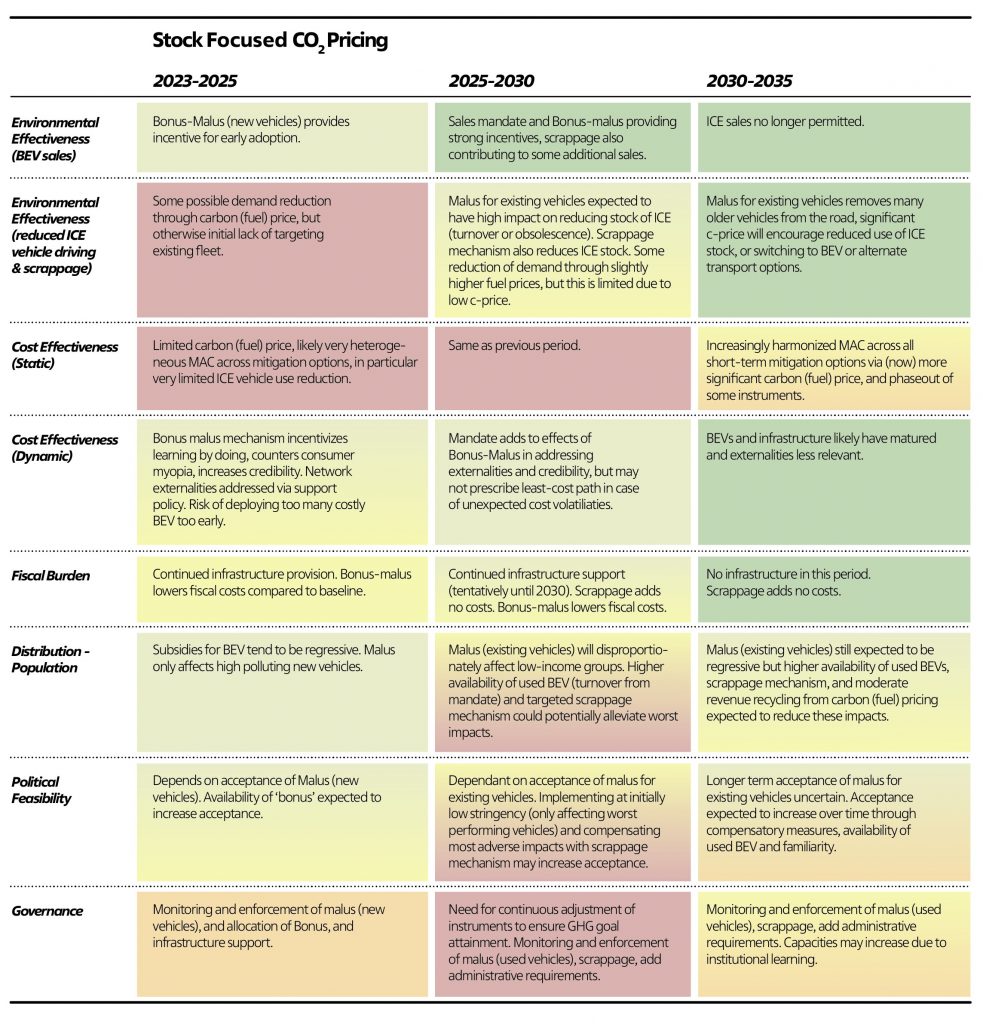
This mix has likely significant acceptance challenges related to the malus on existing vehicles, and potential opposition from car manufacturers to a ZEV mandate. Historically, ZEV mandates have been met with opposition from the auto industry (Collantes and Sperling 2008; Wesseling et al. 2015), which is a salient point for political feasibility in Germany, due to a strong car manufacturing lobby. Given that some manufacturers (e.g. VW) have been increasingly supportive of accelerated BEV diffusion, they may also support a mandate. However, other actors who have lobbied for the continuation of ICE production lines (e.g. BMW), are expected to contest the implementation of the mandate. Moreover, supply-focused regulations tend to have high acceptability among the general public (Rhodes et al. 2017). However, acceptance issues are expected with the malus for existing ICE. Acceptability might be improved through the design of implementation at initially low stringency, and with targeted support through the scrappage mechanism.
This mix has very high governance requirements throughout. The ZEV mandate has administrative requirements in issuing and allocating credits, and through enforcement. Implementation of both malus (new and existing vehicles) adds significant administrative burden and requires an accurate measurement regime for vehicle CO2-performance. The enforcement regime needs to be robust and credible, otherwise the environmental effectiveness of the mix is in question. Due to the higher complexity of the mix design, there is also a higher risk of unintended outcomes. High complexity requires constant monitoring, recalibration and reflexive governance, otherwise there is risk of policy failures (e.g. with respect to cost and potentially environmental effectiveness, political feasibility).
5.3. Mixed sequential carbon pricing (Mix)
Mix design
Carbon (fuel) pricing starts at an intermediate level (to enable political feasibility) and rises significantly over time to become the core instrument driving the transition; initially, it is complemented by a bonus-malus mechanism addressing stock turnover decisions and related market failures which phases out over time. This pathway employs a mixed sequential approach which initially targets stock dynamics (BEV sales) via related pricing and then places increasing emphasis on fuel carbon pricing over time (Figure 16). Sufficiently high and rising carbon (fuel) pricing at the core of the policy mix is eventually the key instrument to both incentivize BEV purchase decisions, and ICE demand reduction (via reduced use and earlier scrappage decisions). In the very short-term, subsidies, standards and infrastructure policies play a significant role to address challenges such as learning by doing externalities, consumer myopia and network externalities, but also to ensure political feasibility (i.e. avoiding backlash from immediately hiking the carbon (fuel) price to extremely high levels). These complementary policies are gradually phased out as the carbon (fuel) price increases to significant levels, and as challenges can be expected to decline in importance.
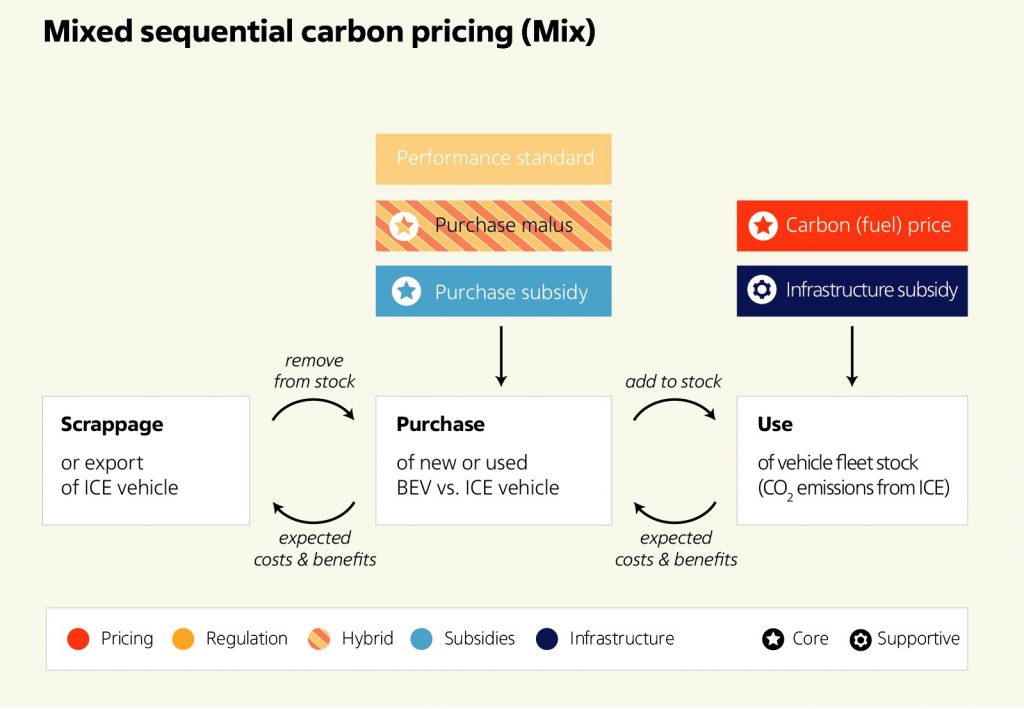
A moderate short-term hike in the price level and a medium-term fuel carbon price corridor make the carbon fuel pricing element in this pathway more politically feasible than in the ‘Fuel Focus’ pathway. Gradual ramping of carbon (fuel) pricing (controlled via a price corridor) increases political feasibility compared to immediate very high carbon (fuel) pricing. A nETS price collar could be implemented as soon as 2023 (Pahle et al. 2022). The carbon (fuel) price reaches high stringency towards the end of the decade, by which point there is an increased probability that manufacturers’ and citizens’ acceptance of very high levels of carbon (fuel) pricing will have increased as the vehicle stock and perceptions of and preferences on climate policies change (Mattauch et al. 2022).
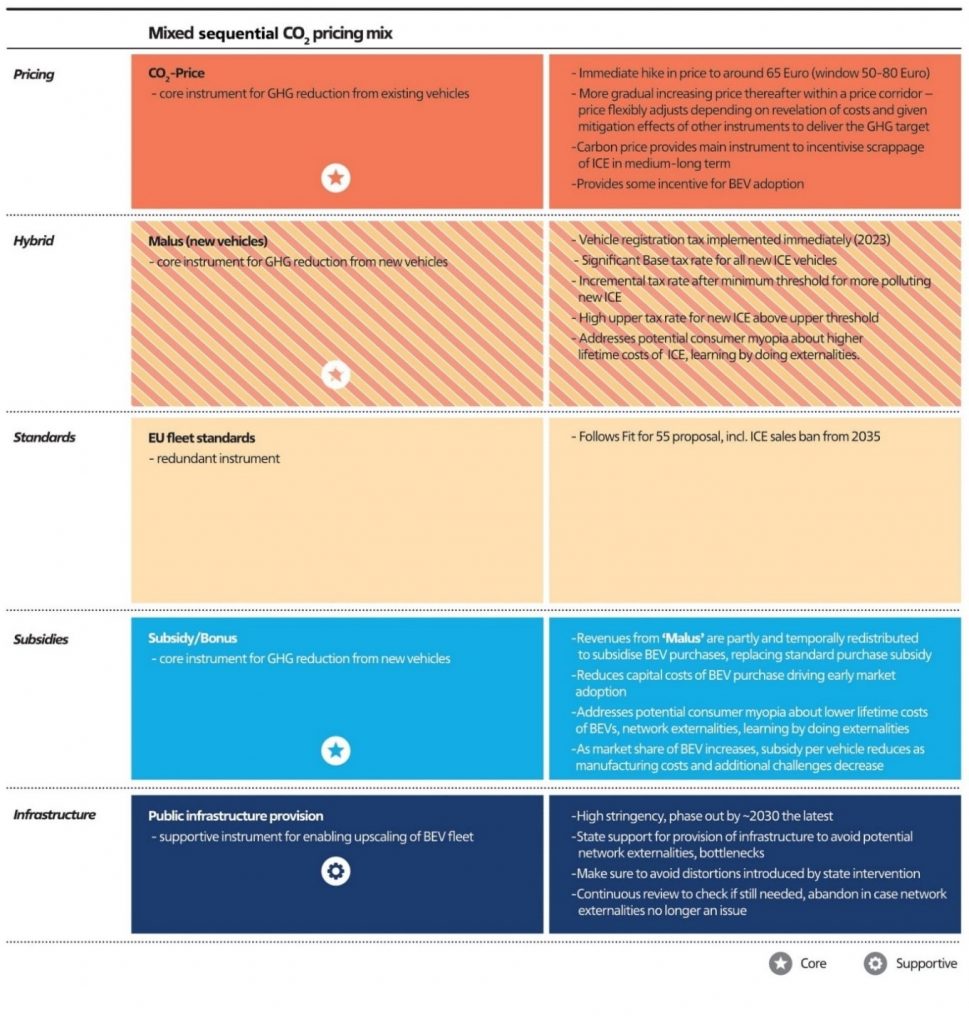
Some car manufacturers can be expected to be calling for a very high carbon (fuel) price to support their superior BEV-based business models. Finally, due to complementary instruments incentivizing the uptake of BEVs, it is expected that the carbon (fuel) price stringency will not need to rise as high as in a scenario where pricing is used as the primary mechanism to encourage BEV sales (‘Fuel focus’).
A bonus-malus mechanism for new vehicle purchases uses registration tax (malus) and purchase subsidy (bonus) as core instruments to drive BEV sales, particularly in early years. This mix design places greater emphasis on a registration tax (malus) to drive BEV diffusion (since it does not use a ZEV mandate). To ensure effectiveness, while acknowledging issues related to imperfect monitoring and associated evasion, the tax is implemented with base tax rate making it a more effective design, with a potential trade-off with increased political feasibility challenges for its implementation. This design for the malus in this pathway differs from the “stock focus” by applying a starting base rate tax (e.g. 500-1000 euros) to all new ICE registered (irrespective of CO2 performance rating), and also applies exponential taxation scaling after a minimum threshold (e.g. 100 g/km CO2) like the stock focus option. This design has immediately higher effectiveness, making BEV more competitive even without subsidy, and would generate substantially more revenues.
Regular recalibration of the malus will be needed to drive diffusion of BEV and may require scaling up pricing to attain a central scenario. Registration tax (malus) has an integrated central pathway based on emission performance trajectory, that the regulator needs to deliver, which will require recalibration of tax level relative to CO2 intensity. Recalibration of the mechanism will be needed to adapt to changes in new ICE and BEV prices, so a revision mechanism should be included in the design from the outset, for example on an annual basis.
High stringency bonus-malus systems can be regressive. High-intensity bonus-malus systems have been found to be more regressive than a more moderate combination of tax and bonus-malus (Pyddoke et al. 2021), but this remains uncertain. The main welfare differences are between urban locations and rural ones, therefore adjusting instrument design to target different geographical locations might reduce regressive impacts. Targeting recipients of the bonus based on vehicle value and applicant income could advance progressivity further. This could include different rates for vehicle sizes and prices. Alternative design features could also include targeting based on income groups (e.g. submitting fiscal documents proving eligibility), which has been demonstrated to improve the effectiveness of purchase subsidies (ANNEX II.3). The bonus (purchase subsidy) is likely a core instrument for initially incentivising continued market growth of BEV. The bonus for ZEV purchases in this pathway has much lower fiscal costs than baseline, being supported by revenues from the malus. Dependent on costs trajectories, the duration of the bonus availability could be extended, potentially up to 2030. Due to higher revenues generated from the base rate design of malus, this will not incur additional fiscal burden. As noted above, it remains open to which extent purchase subsidies achieve additional BEV purchases to the EU vehicle fleet CO2-performance standards.
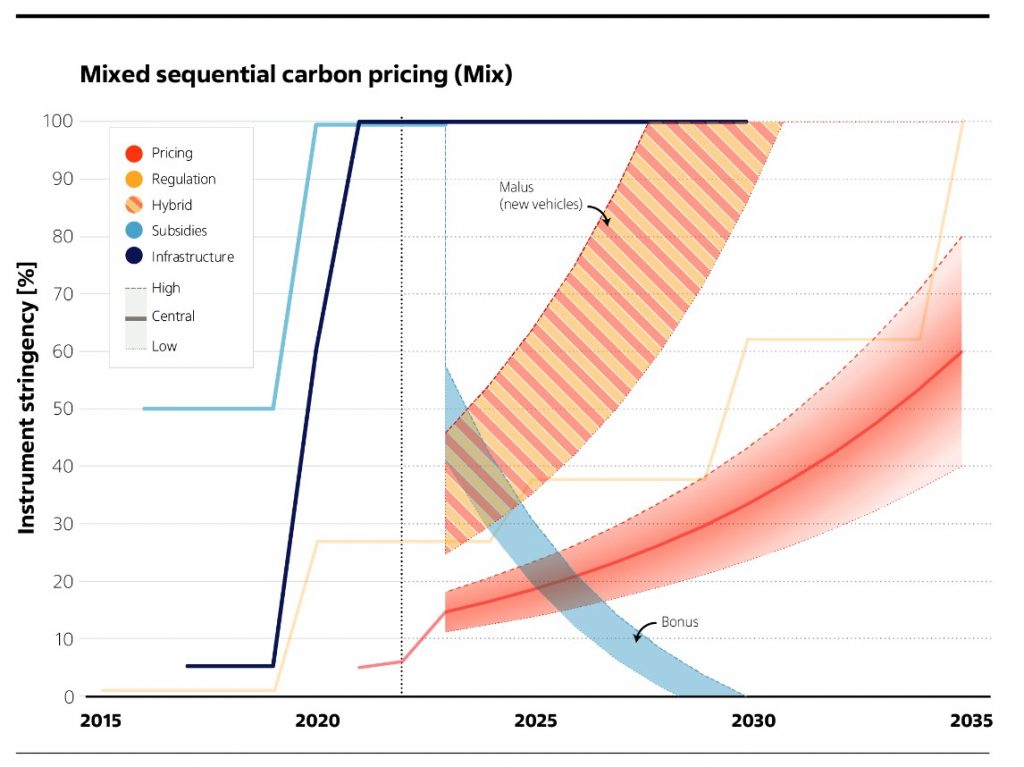
Link bonus levels to manufacturing cost trajectories of EVs to increase effectiveness. The Bonus should be adjusted annually to reflect decreasing manufacturing costs for EVs. This will improve the effectiveness of the instrument by avoiding over-subsidisation, reducing windfalls, and potentially supporting more vehicle purchases without creating fiscal strains. We suggest providing a decreasing bonus rate until 2028-2030, which allows for slower than anticipated cost-performance improvements in BEVs.
Infrastructure provision is continued in line with current deployment targets, with flexibility to private sector developments. If there is significant growth in the private sector for infrastructure provision, state support can be phased out sooner than 2030.
Mix assessment
The environmental effectiveness of this mix option is mainly achieved by a combination of carbon (fuel) pricing and a bonus-malus mechanism for new vehicles purchases, complemented by infrastructure support policies. The combination of bonus-malus (new vehicles) and carbon (fuel) pricing is expected to be highly effective at incentivising BEV sales initially and over time. There is some uncertainty over the effects of carbon (fuel) pricing on stock turnover and demand reduction, which may mean that a significant reduction will only occur later when prices increase in stringency. Therefore, the potential range for required carbon (fuel) pricing is large. We anticipate that the pricing range we display in Figure 17 will be effective if complemented by the bonus-malus, but the design needs flexibility to allow for sufficiently high prices to ensure environmental effectiveness if elasticities for reducing emissions from the existing vehicle stock are low. In case the price ceiling is triggered, other instruments are required to ensure environmental effectiveness.
The cost effectiveness of this mix option is likely high. Increased carbon (fuel) pricing helps target all abatement options relatively quickly, increasing the cost effectiveness of the mix design. The bonus-malus (being effective immediately) and long-term carbon (fuel) price with a pre-announced price collar are expected to have high intertemporal cost effectiveness by addressing consumer myopia (via bonus-malus), addressing network externalities both via the strong pricing signal and the complementary infrastructure support, and signalling credible commitment.
This option has moderate fiscal burden. The fiscal burden of this design is significantly lower than the baseline, due to the addition of the malus mechanism directly raising revenues and offsetting ‘Bonus’ subsidy. The main cost associated with this pathway is the continued provision of infrastructure. Dependent on the design of the carbon (fuel) pricing re-distribution mechanism, and the magnitude of revenues from Malus, surplus revenues could be used to offset infrastructure support.
The distributional impacts of this mix are highly dependent on carbon (fuel) pricing revenue recycling and bonus malus design. The main consideration is how progressive the carbon (fuel) price revenue recycling mechanism will be, but other effects such as second-hand BEV car market emergence will play an important role as well even if so far only poorly understood. Also, a high bonus from more stringent pricing could potentially be used to make purchases of BEV cheaper. Bonus malus may also have some regressive effects, but again these critically depend on policy design features.
The political feasibility of this option is considered moderate but uncertain. A sudden carbon (fuel) price hike may provoke fierce contestation by large segments of the German population. Opposition may ease over time due to familiarity and learning as beneficiaries from revenue recycling increase and from opponents if their anticipations of adverse impacts do not materialise (Mattauch et al. 2022). Opposition may also reduce since the bonus-malus mechanism will have helped stimulate increased BEV diffusion, meaning less people are directly affected by higher fuel costs. There is less evidence on acceptance of a Bonus Malus (new vehicles), but we expect the acceptability to be higher than carbon (fuel) pricing e.g. due to different salience and fairness perceptions, affecting only those purchasing new vehicles in a differentiated way. Still, there will likely still be opposition from specific population groups and possibly car manufacturers. Car manufacturers offering superior BEV may strongly support this mix given its relatively good overall performances across our evaluation criteria (see next section) and this potentially high credibility and feasibility.
This mix option has significant governance requirements, particularly initially. In the first stage, a lump sum carbon (fuel) pricing revenue recycling mechanism would need to be established to ensure progressive outcomes. Allocation of funds for infrastructure and revised targeted purchase subsidies, and dynamic adjustment of both over time in response to market developments, require adequate administrative capacities and processes.
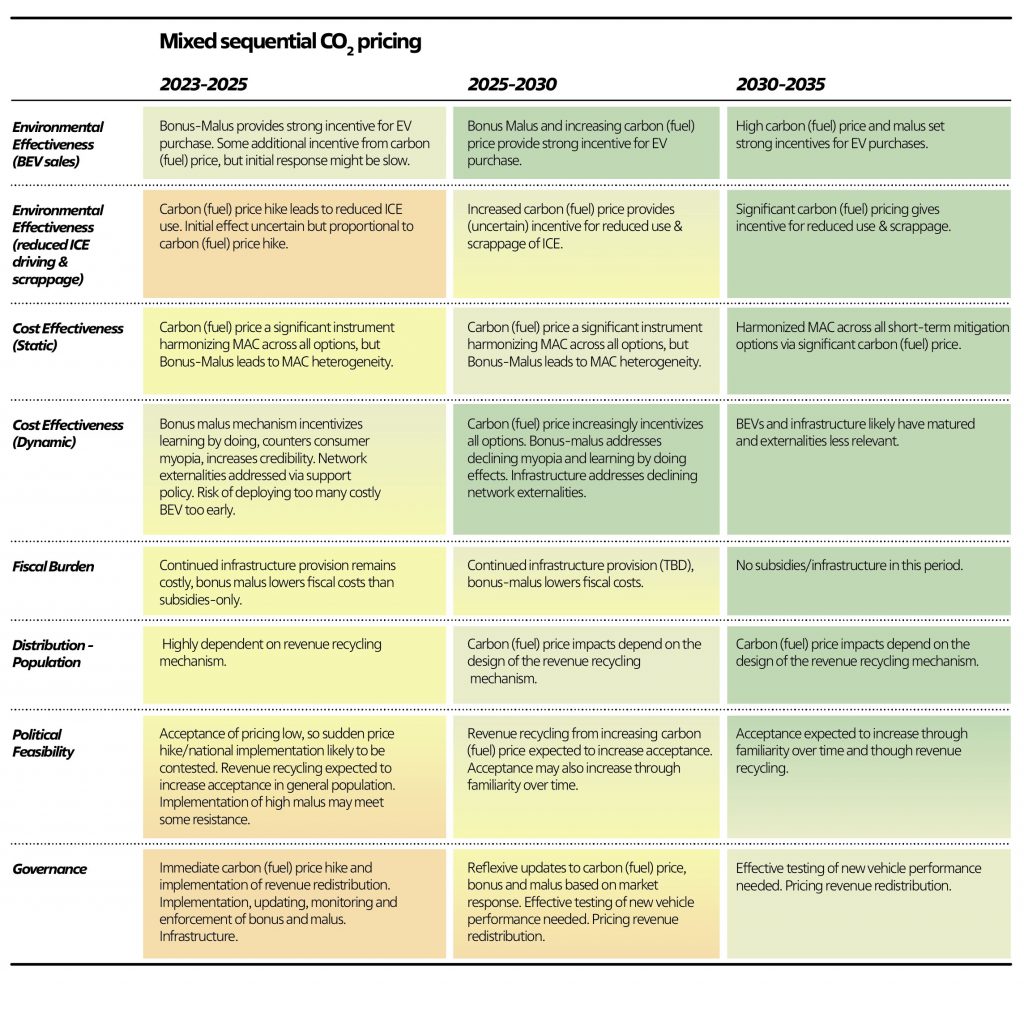
5.4. Comparative assessment
Each pathway requires some level of carbon (fuel) pricing to target all abatement options and maximize cost effectiveness. Carbon (fuel) pricing is the main mechanism targeting GHG abatement through demand reduction/increased fuel prices across all options. Without targeting fuel prices, GHG abatement associated with demand reduction of the existing stock is under-utilized, reducing environmental effectiveness and/or placing more emphasis on stock turnover, which will reduce cost effectiveness. Accordingly, carbon (fuel) pricing is needed even in more complicated mix designs (e.g. stock focus), otherwise overreliance on stock turnover as a mitigation option will increase costs.
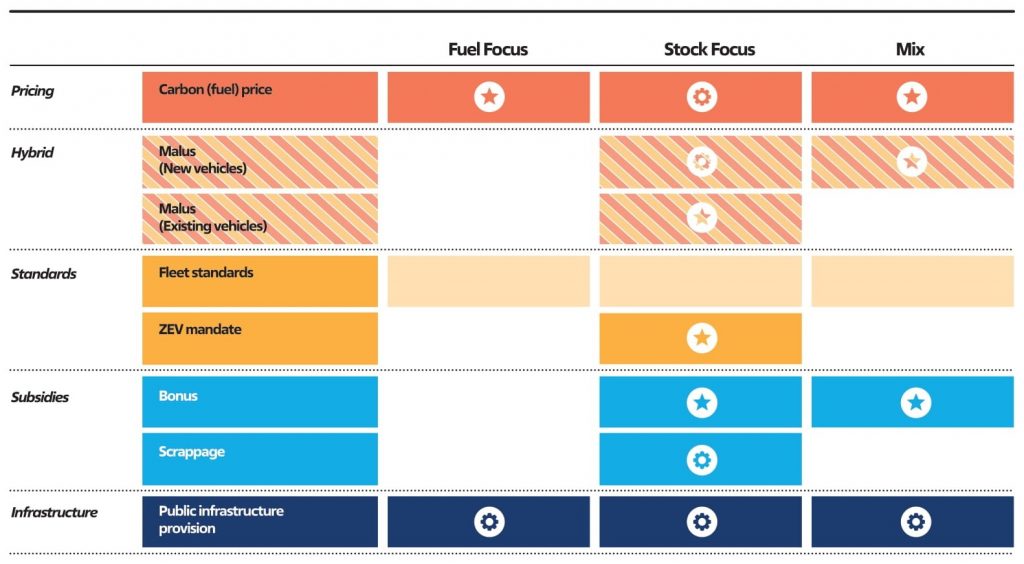
Reforms to emission performance and classification of vehicles is needed to improve effectiveness and credibility of standards and bonus-malus instruments indexed to vehicle CO2-intensity. Laboratory testing for classifying the CO2-intensity of new ICE vehicles for EU fleet standards has proved susceptible to gaming. So reform of the monitoring and evaluation, or classification procedures of vehicle and performance are needed to correctly characterize actual driving behaviour, otherwise environmental effectiveness of the malus instruments proposed in the “Stock focus” and “Mix” pathways would be compromised.
Political feasibility is a challenge in all pathways but given high salience, low level of popularity and likely distorted perception of distributional impacts of significant levels of carbon (fuel) pricing even with carefully crafted revenue recycling might be more challenging initially than stock pricing instruments (e.g. bonus malus). Political feasibility poses a challenge to implementation across all pathways, but particularly for stringent carbon (fuel) pricing. However, low acceptance appears to be based on expectations (fears) of adverse distributional impacts, which do not align with predicted outcomes, providing effective revenue redistribution and targeting of concentrated losses and compensating are also enacted. These measures are critical to reduce regressive distributional outcomes, and low public acceptance may reflect a lack of information provision about expected effects, and/or a lack confidence that these measures will be implemented effectively. Organizing a social learning process to align public perceptions with best available assessments of distributional impacts will be essential to alter instrument acceptance over time.
All mix options have strengths and weaknesses. We now compare the pathways with a comparative/summative assessment, and in terms of the main risks associated with each. The key risks associated with each pathway are outlined in Table 10, which includes risks which have the potential to undermine environmental effectiveness. To more directly compare our pathway assessments, a summative overview is represented in Table 11.
The main benefit from the ‘Fuel focus’ mix pathway is its simplicity and low fiscal costs. The main benefit from the fuel focus pathway is that there are low information requirements for the regulator, due to its simplicity. This mix option also has very low fiscal costs, providing wholesale oil prices remain relatively constant, which might otherwise require state funds to support compensation mechanisms. If sufficiently high the carbon (fuel) price should, in general, be sufficient to drive the transition and GHG emission reductions, but is dependent on market and network failures not being significant or persistent.
Political feasibility is a major challenge in pursuing the ‘fuel focus’ pathway, the other one being potential market failures which are not addressed. The mix relies on an immediate and significant hike in pricing. Pricing has historically been the least accepted instrument, therefore a sudden increase to unprecedented levels currently implemented anywhere in the world is expected to be strongly contested by those who oppose carbon (fuel) pricing7Or even those who advocate a more moderate approach of pricing as part of a wider policy approach.. The other consideration is that political commitment has to be high to this approach once implemented, as failure to fully implement will result in failure to reach GHG abatement targets. In addition, if there are additional unanticipated market failures that are not addressed by even a very high carbon (fuel) price, this will compromise dynamic cost effectiveness. This implies the need for even higher carbon (fuel) prices, reinforcing political feasibility concerns. Related to this, while high stringency pricing will be a highly effective instrument in the long run, there remain uncertainties which arise from the short-term elasticity to pricing particular with respect to vehicle fleet turnover. This may lead to an adaption phase (up to five years) before (myopic) consumer preferences shift significantly towards adoption of BEVs and/or reduced demand for ICE.
The main benefit of the ‘Stock focus’ pathway is that it targets potential additional challenges and has less risk associated with environmental effectiveness. This mix option utilises instrument designs which combine aspects of economic and regulatory mechanisms (ZEV mandate, and malus for new and existing vehicles). Essentially, the pricing components of these instruments directly incentivize changes in capital stock composition. This guides behaviours more directly than through a fuel price signal, which relies on market actors and consumers to adjust behaviours rationally. Accordingly, this mix design is less susceptible to consumer and producer myopia, and other market/network failures, which lowers risks associated with effectiveness of core instruments to achieve GHG abatement.
The main risks associated with the ‘stock focus’ pathway are linked to classification of ICE vehicle emission intensity, uncertainty, unintended consequences, potential governance failures and related risks to cost effectiveness. Since this mix design relies on multiple interacting instruments, there is a greater chance of governance failures, including implementation, monitoring and enforcement, and proper calibration of instruments, which might compromise environmental and cost effectiveness. While the instrument types used in this mix aim to reduce the occurrence of evasion and gaming (associated with the current fleet standards), the instruments here require a large role of the state to monitor and enforce several (and sometimes overlapping) mechanisms. This places higher burden on the state and increases the likelihood of unintended interactions, which may need more frequent intervention and recalibration than more simplistic mix designs. Particularly compliance and enforcement of fiscal penalties is essential for the mechanism to have ‘teeth’, including legal actions taken against firms and individuals for non-compliance, otherwise credibility and legitimacy of the mix is undermined.
There is particularly large uncertainty around the distributive impacts of implementing a malus on existing vehicles. A malus for existing vehicles has not currently been implemented at the ambition levels we are suggesting, which essentially equates to phasing out of existing ICE stock through high fiscal penalties. Since the low emission performance of older vehicles will be the first targeted by this mechanism, which are more commonly associated with lower-income groups, then the distributive impact of the mechanism is expected to be significant. One option is implementing a scrappage mechanism alongside the malus, targeted at reducing the most regressive impacts. Since this is an unprecedented approach, there is very high uncertainty regarding the distributive impacts even with targeted support mechanisms in place.
The main advantage of the ‘Mix’ pathway is that it increases acceptance by initially targeting purchase decisions and allowing carbon (fuel) pricing to scale up, while also performing best in the cost effectiveness dimension. This mix uses more accepted instruments to target the early diffusion of BEV, while allowing carbon pricing to scale up more gradually, avoiding the political feasibility challenges from carbon (fuel) pricing by increasing the price initially more moderately than in the ‘Fuel Focus’ mix. We anticipate that acceptance will increase over time due to increasing familiarity and many citizens receiving benefits from pricing through the revenue repayments, especially lower-income groups who tend to drive less. Therefore, the main political challenge is the initial hike in the level of the carbon (fuel) price trajectory.
While the ‘Mix’ pathway has few major weaknesses, its (initially) relatively limited effect to incentivize demand reduction and scrappage of existing ICE vehicles as well as uncertainty over political feasibility are perhaps the most important drawbacks. This mix design relies on carbon (fuel) pricing to provide the incentive to reduce demand from existing ICE, or to incentivise switching of the general fleet. Since elasticities are uncertain, pricing may not lead to significant reductions in GHG from existing vehicles until the price reaches very high stringency (2030-2035), which may result in lower abatement prior to 2030. As this mix does not have additional instruments which seek to reduce GHG emissions from existing vehicles and phase out ICE vehicles, this poses a risk for overall environmental effectiveness.
There are significant uncertainties related to the assessment of all pathways. We try to reflect significant uncertainties related to the performance of individual instruments, exogenous uncertainties about cost developments and price elasticities via ranges of policy instrument calibrations within our pathways as well as uncertainty ranges in our pathway evaluations. Numerical modelling would be very useful to more rigorously specify this uncertainty space but cannot completely resolve it.
Instrument related uncertainties also influence accuracy of estimations. The ambition levels presented in our mix options are currently unprecedented, anywhere in the world. We are considering a significant ramping up of climate policy mix instrument stringency in the decades ahead, so current expectations of aspects such as environmental effectiveness, cost effectiveness, and distribution may play out differently at such high stringency ranges to past and current observations. This applies to pricing mechanisms, where historical elasticity estimates are often based on gasoline and diesel market price fluctuations, but also to other instruments as behavioural responses are unclear. There are particularly high levels of uncertainty about stock turnover elasticities. We could potentially expect higher elasticities than those observed historically, particularly as BEVs and infrastructure become more cheaply available and consumer norms change over time towards higher acceptance of BEVs.
Exogenous uncertainties – e.g. changing socio-economic conditions – will affect future trajectories. Other unpredictable macro-level conditions (geopolitical shocks, financial crises, pandemics, increased climate related natural disasters, etc.) will have unpredictable impacts on projected pathways, in ways which may either help (accelerate momentum) or hinder (reorientation of funds to crisis) the rate of transition. Included in such macro considerations is potential international trade conditions, which may affect supply and costs of vehicle components.Uncertainty implies that policy mixes need to be constantly evaluated and adjusted in light of learning. In all mixes attainment of high GHG abatement in 2030 requires constant national adjustment of policy mix calibration. Adequate institutions and expertise for monitoring policy mix performances, and adapting it, will be essential.
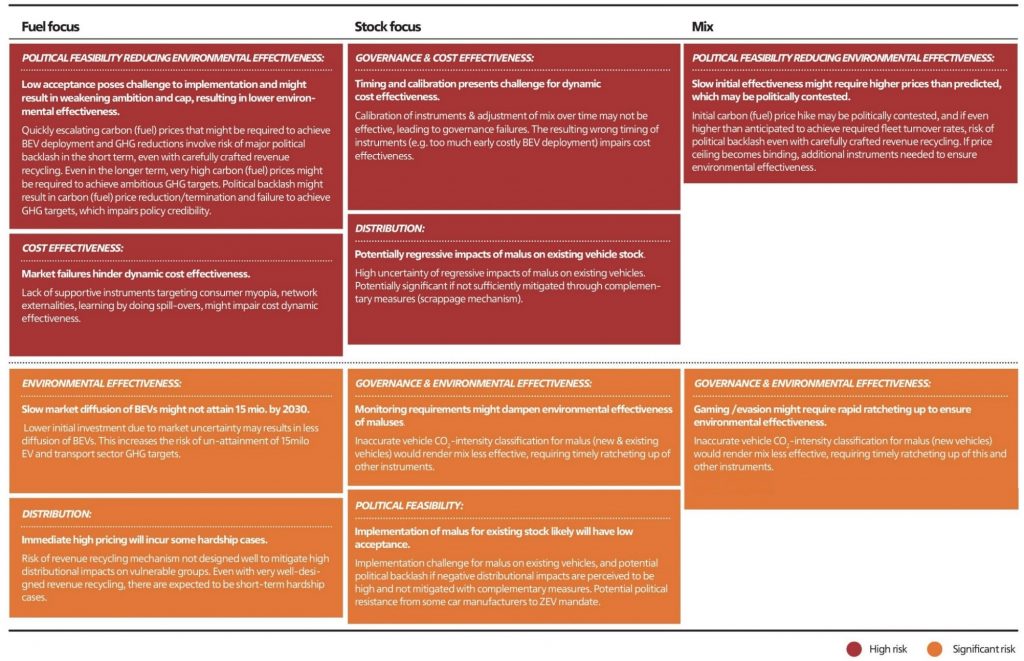
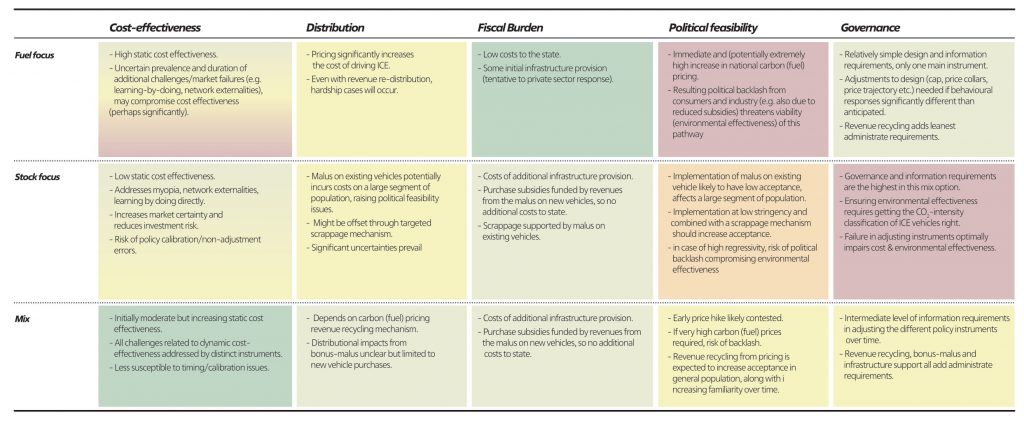
5.5 Limitations and further work
Our framing limits the scope of transport mitigation options to LDVs, and number of instruments. We do not comprehensively consider a wider range of transport options and policy instruments which could contribute towards demand reduction. These include the promotion of public transport and increased provision of public transport and cycling infrastructures. We exclude these to reduce complexity but acknowledge that they are important supportive interventions to further decrease GHG emissions by reducing ownership and use of LDVs. We also excluded consideration of renewable electricity generation expansion and network challenges involved in transitioning to a full BEV fleet. Without incentives for modal switching provided by these complimentary policies, some stock-focused policies – at least when they involve subsidies on car purchase or implicit subsidies (like standards or feebates that constitute implicit output subsidies), tend to lead to larger than optimal fleet size, i.e. suboptimal use of other transportation. Carbon pricing policies provide an incentive to use modal shifts to less carbon intensive modes of transportation. This is on the intensive as well as on the extensive margin. We also expect the malus for existing vehicles (road tax) to incentivise some modal switching but this effect is uncertain and is an area where more research would be very useful.
Existing constraining support mechanisms for ICEs may also need to be dismantled to accelerate transformation. We acknowledge that there are several existing policies which may have negative interactions with the pathways, which may need to be removed to facilitate a more effective and rapid transition, while maximizing cost effectiveness. Such policies, which support the continued use of ICE, lie outside the scope of our analysis, but we acknowledge them as potentially significant constraining factors and suggest attention towards dismantling these existing constraining measures. Particularly, existing company car tax benefits and the Pendlerpauschale are considered as key existing arrangements that should be reformed to accelerate transformation in this sector. There may also be wider conflicting policies which would apply to charging and electricity supply, such as Stromsteuer and road tolls systems to ensure fair pricing for infrastructure. While we acknowledge these potential conflicts which need to be resolved, they are outside the scope of our work.
Our assessments reflect socio-economic conditions prior to the recent Russian invasion of Ukraine and consequent energy crisis. Our assessments are based predominantly on data and existing analyses up to 2021, and therefore do not incorporate the recent changes to market conditions of fuel prices resulting from an embargo on Russian energy imports. Accordingly, at least in the short term, some of our estimates will need to be adjusted within pathways. In particular, carbon (fuel) prices will be currently overestimated since fuel prices are higher than anticipated and will deliver significant emission reductions short- and perhaps mid-term. Moreover, the ongoing energy crisis may have implications for political feasibility of some options over others, but it is currently too early to make a substantive comment on these implications. The larger point deserving more research is whether policy mix pathways differ in how they can respond to major external shocks.
Many effects of individual instruments and their interactions are highly uncertain, and research that can enhance robustness of the assessment matrix of policy mix pathways would be highly valuable. For example, better understanding the relative contribution of different policies to past expansion of BEVs in Germany (and elsewhere) would be very useful, even if that is challenging. Research geared towards understanding and improving the design of subsidy instruments to maximize cost effectiveness and minimize windfall profits in the German and other contexts would also be very useful. Distributional impacts associated with the “Stock Focus” pathway are particularly uncertain and work on this would be of interest.
Infrastructure stringency range is based on an ambition level for a package of instruments, rather than current subsidy per unit or aggregate funding allocation. We base the stringency level of public infrastructure provision on the deployment target, rather than the aggregate funding allocation towards supporting infrastructure provision. We do this for several reasons. First the technology trend of public chargers is uncertain. Second the allocation of funds does not necessarily represent efficiency. There is a wide range of national and regional incentives in place to support public infrastructure, therefore is it a package of instruments rather than an individual instrument option. Another option would be to use deployment rate as the stringency, but the direct effects of infrastructure provision is uncertain, and there are different opinions on rate and volume of infrastructure provisions needed, therefore it is not possible to determine an optimal pathway based on the interaction of additional instruments in each pathway without further research and availability of evidence. Therefore, we acknowledge that using ambition levels as a rough proxy for installed capacity is suboptimal, but concluded that it was a necessary trade off.
Acknowledging these limitations, this report aims to create a conceptual approach that facilitates the required future collaboration with (transport and other sector/cross-sector) modelling teams and other communities (e.g. legal) to expand assessment of climate policy mix pathways. Finally, we believe that similar integrated policy mix pathways analyses should be conducted for other sectors relevant for transitioning to net zero. These include industry, buildings, power, and agriculture. This will require cooperation across different disciplines, sector communities, and combining top-down and bottom-up perspectives. Our work is also relevant for international climate policy as all countries will need to devise climate policy mix pathways along with their Nationally Determined Contributions under the Paris Agreement’s mechanisms, and such policy pathways can offer important entry points for international policy coordination and cooperation (e.g. industry sector competitiveness, finance for transition support). Most importantly, it requires patience and willingness to turn inevitable disagreements on important, complex and normatively laden policy questions into constructive deliberation and ultimately sound policy decisions.
Our report identifies key current uncertainties, which pose challenges for effective design and governance, and are important areas for further research. Three main areas which need further research to help make better assessments and inform better policy design (Table 12). These relate to: (a) impact assessments of instruments and pathways; (b) dynamic design and governance over time, and (c) political dynamics. Credible empirical studies further clarifying and preferably quantifying these uncertainties would be extremely valuable, particularly in the German context, as much of the existing transport literature is focused on the US and Canada. More robust research in these areas would help mitigate the risk of governance failures.
| Topic for further work | Areas of focus | Key points/lines of enquiry |
|---|---|---|
| More reliable evaluations of instruments (mix) impacts are needed in some areas | Econometric analysis of current instruments (Purchase subsidies and infrastructure provision, road tax) | Econometric analysis of the impact of current instruments on investments, emissions and distributional outcomes for purchase subsidies for BEV sales, and infrastructure provision, would be very useful. Particularly for infrastructure, this could be complementary to further research on the scale and duration of support needed, and numbers of public charging infrastructure provision. |
| Effectiveness and distributional impacts of ‘Stock focus’ pathway, primarily high stringency (existing) vehicle tax | As argued in our report, some form of intervention is needed to accelerate ICE stock scrappage, in order to meet environmental targets. The two main options are carbon (fuel) pricing or pricing (or regulating) the use of existing ICE stock. The effects on scrappage/modal shifts of high stringency road taxation (malus in stock focus pathway) need further research.Distributional impacts of pricing the existing stock at high stringencies are highly uncertain (but expected to be regressive), and should be the focus of further work, particularly given the political salience (opposition) to introducing high stringency carbon (fuel) pricing. | |
| Conceptualizing dynamic design and governance of policy mix pathways over time, and integration with modelling work | Quantification of market failures and refined conceptualisation of dynamic cost effectiveness | While market failures are a key motivation for policy intervention enhancing cost effectiveness, hardly any quantification is availableUnderstanding of dynamic cost effectiveness and how specifically instruments can advance it (e.g. via addressing market failures) would benefit from further researchIn particular, research on the second order effects of high stringency carbon (fuel) pricing in more advanced stages of an LDV transition is needed. |
| Response of pathways to shocks and exogenous trends | Future work should focus on how policy pathways (should) respond differently to shocks and exogenous trends. This is particularly important given current uncertainties about supply chains, component availabilities, and international trade agreements. | |
| Better integration with modelling work | Current models do not consider the full range of challenges/assessment criteria we draw attention to in this report. Better integration of these factors would allow for more robust evaluation and calibration of instrument stringencies and pathways. | |
| Political dynamics | Linking policy impacts and acceptance of population and industry groups to reform prospects (policy feedback) | We use acceptance as a proxy for political feasibility in our work, but acknowledge that this is closely related to other important variables, e.g. distributive impacts and their perception. Further work should focus on better linking the various impacts of policy mixes on the acceptance from population groups (voters) and interest groups (industry), and then more explicitly link these to reforms, to substantively generate evidence on how these groups enable or constrain reforms. |
| Political party climate party platforms | The conditions under which political party climate platforms are formed and changed , and their impacts on reform prospects towards climate policy mixes that align with GHG targets. |
6. Conclusions
Formulating and assessing climate policy mix pathways requires challenging knowledge integration across different domains and disciplines. We suggest adopting a sequential perspective on characterising policy pathways for sectoral transitions, highlighting main intertemporal challenges, and reconstructing and assessing baseline (“policy as usual”) and potential alternative policy pathways. This requires combining knowledge of (at least): technology, behavioural and cost dynamics in transition processes (engineering and economics perspectives); of climate and transport policy instruments (empirical and conceptual economic and other policy instrument research); of institutional policy details (legal and practical policymaking perspective); and of empirical research relevant for assessing politics (political science). This is extremely challenging in practice but removing one of the perspectives will likely lead to omitting key variables and thus assessment – and ultimately policy – errors.
Our approach emphasises a need for policy mixes which actively phase out the use of existing ICE vehicles. Simply supporting the diffusion of new BEV vehicles (or other zero carbon technologies) is not sufficient to drive a transition in the LDV sector (or other sectors) at the scale and speed needed to realise GHG emission neutrality before mid-century. This approach emphasises the need for mix designs utilise instruments putting pressure on current markets, practices and norms, via high and currently unprecedented instrument stringencies capable of phasing out established business models alongside phasing in new and GHG-free ones.
We constructed pathways focussing on fuel pricing, stock pricing and a mixed approach. We highlight that displacing GHG emissions can be driven by focussing on fuel pricing or stock dynamics, but focussing narrowly on either has potential drawbacks. We also highlight that these logics can be combined through a sequential approach, with an early emphasis on stock dynamics, coupled with an increasing focus on fuel pricing which then becomes sufficient to drive mechanisms of continued transition. We constructed three pathways, to represent these different design logics: “Fuel focused carbon pricing (Fuel focus)”, “Stock focused carbon pricing (Stock focus)” and “Mixed focus sequential carbon pricing (Mix)”.
The “Mix” pathway performs best in our assessment, reducing the most significant challenges of the “Fuel focus” and “Stock focus” pathways. While each pathway is designed to be capable of delivering the 2030 targets the “Fuel focus” and “Stock focus” pathways face more challenges related to political acceptance, cost effectiveness and governance requirements. The “Mix” pathway utilises sequencing to incrementally scale up to higher stringency fuel carbon pricing, which improves political feasibility. The mix design focuses more attention on instruments with higher acceptance to drive the initial diffusion of BEVs, which allows the carbon (fuel) price to scale up and its utility in more based on reducing usage of the exiting stock, and on the scrappage of ICE vehicles from the road. The use of these purchase focused instruments not only increases acceptance overall, but also increases intertemporal cost effectiveness by directly targeting market failures, and gives more market certainty than a fluctuating price signal alone. Our assessment therefore indicates that combining pricing with complimentary measures is not only a second best approach to cope with political feasibility challenges but actually improves the efficiency of the design. However, the magnitude and the duration of the supportive instruments should be designed with sensitivity to the magnitude of the market failure.
This report serves as a starting point for further research seeking to better integrate conceptual developments in policy mix construction and evaluation in particular with modelling work. Complementing conceptual analysis (building on different empirical literatures) with ex ante modelling tailored to systematically exploring alternative policy pathways promises more precise and policy relevant outputs and to quantitatively assess conjectures about policy instrument mixes. In particular we expect that running model experiments with different policies in the mix switched on/off, testing how instruments need to be tightened to substitute for less ambitious other policy instrument choices, how policy mixes respond to external shocks, and how all of this affects their respective cost effectiveness, would be very useful. Increased representation of market failures within models, as well as calibration to (on many issues yet to be performed) empirical research for the German context would be extremely useful for such exercises. Finally, our framework allows and invites design and assessment of additional alternative policy pathways, as well as improvements in the framework itself. We hope this can improve important and controversial climate policy mix pathway debates by increasing structure and rigour over time.
Annex [I] – The current policy mix for LDV in Germany
Annex [II] – Review of generic evidence for core instruments
Annex [III] – Stringency for instruments in pathways
Annex [IV] – Illustration: market growth of BEVs and cumulative deployment (ZEV mandate scaling)
The authors would like to thank Michael Jakob, Matthias Kalkuhl and Robert Pietzcker for comments, and Kay Schröder for generating the figures.
This Ariadne background was prepared by the above-mentioned authors of the Ariadne consortium. It does not necessarily reflect the opinion of the entire Ariadne consortium or the funding agency. The content of the Ariadne publications is produced in the project independently of the Federal Ministry of Education and Research.
Literaturangaben
Aghion, P., Dechezleprêtre, A., Hémous, D., Martin, R., & Van Reenen, J. (2016). Carbon Taxes, Path Dependency, and Directed Technical Change: Evidence from the Auto Industry. Journal of Political Economy, 124(1), 1–51. https://doi.org/10.1086/684581
Agostini, C. A., & Jiménez, J. (2015). The distributional incidence of the gasoline tax in Chile. Energy Policy, 85, 243–252. https://doi.org/10.1016/j.enpol.2015.06.010
Andersson, J. J. (2019). Carbon Taxes and CO2 Emissions: Sweden as a Case Study. American Economic Journal: Economic Policy, 11(4), 1–30. https://doi.org/10.1257/pol.20170144
Antweiler, W., & Gulati, S. (2016). Frugal Cars or Frugal Drivers? How Carbon and Fuel Taxes Influence the Choice and Use of Cars. SSRN Electronic Journal. https://doi.org/10.2139/ssrn.2778868
aus dem Moore, N., Brehm, J., & Gruhl, H. (2021). Driving Innovation? Carbon Tax Effects in the Swedish Transport Sector. SSRN Electronic Journal. https://doi.org/10.2139/ssrn.3995632
AVD (2021). Benzinpreise in Europa. https://avd.de/wissensbasis/rund-ums-auto/artikel/benzinpreise-europa#:~:text=Aktuell%20liegt%20die%20Energiesteuer%20bei,einen%20Liter%20Benzin%20in%20Deutschland.&text=Seit%202021%20bezahlen%20Unternehmen%2C%20die,zun%C3%A4chst%2025%20Euro%20pro%20Tonne
Axsen, J., & Wolinetz, M. (2018). Reaching 30% plug-in vehicle sales by 2030: Modeling incentive and sales mandate strategies in Canada. Transportation Research Part D: Transport and Environment, 65, 596–617. https://doi.org/10.1016/j.trd.2018.09.012
Axsen, J., Plötz, P., & Wolinetz, M. (2020). Crafting strong, integrated policy mixes for deep CO2 mitigation in road transport. Nature Climate Change, 10(9), 809–818. https://doi.org/10.1038/s41558-020-0877-y
Azar, C., & Sandén, B. A. (2011). The elusive quest for technology-neutral policies. Environmental Innovation and Societal Transitions, 1(1), 135–139. https://doi.org/10.1016/j.eist.2011.03.003
BAFA (2021). Elektromobilität (Umweltbonus). Monatlich aktualisierte Zwischenbilanz des Förderprogramm Elektromobilität (Umweltbonus). https://www.bafa.de/SharedDocs/Downloads/DE/Energie/emob_zwischenbilanz.html
Bailey, J., Miele, A., & Axsen, J. (2015). Is awareness of public charging associated with consumer interest in plug-in electric vehicles? Transportation Research Part D: Transport and Environment, 36, 1–9. https://doi.org/10.1016/j.trd.2015.02.001
Bakker, S., & Jacob Trip, J. (2013). Policy options to support the adoption of electric vehicles in the urban environment. Transportation Research Part D: Transport and Environment, 25, 18–23. https://doi.org/10.1016/j.trd.2013.07.005
Baldenius, T., Bernstein, T., Kalkuhl, M., von Kleist-Retzow, M., & Koch, N. (2021). Ordnungsrecht oder Preisinstrumente? Zur Verteilungswirkung von Klimaschutzmaßnahmen im Verkehr.
Bär, H., Leisinger, C., & Neubert, M. (2021). Deutscher Aufbau-und Resilienzplan: verpasste Chance für eine klimafreundliche und soziale Mobilität? Aktualisierte. Retrieved from www.foes.de
Bento, A. M., Goulder, L. H., Jacobsen, M. R., & von Haefen, R. H. (2009). Distributional and Efficiency Impacts of Increased US Gasoline Taxes. American Economic Review, 99(3), 667–699. https://doi.org/10.1257/aer.99.3.667
Bhardwaj, C., Axsen, J., Kern, F., & McCollum, D. (2020). Why have multiple climate policies for light-duty vehicles? Policy mix rationales, interactions and research gaps. Transportation Research Part A: Policy and Practice, 135, 309–326. https://doi.org/10.1016/j.tra.2020.03.011
Bjerkan, K. Y., Nørbech, T. E., & Nordtømme, M. E. (2016). Incentives for promoting Battery Electric Vehicle (BEV) adoption in Norway. Transportation Research Part D: Transport and Environment, 43, 169–180. https://doi.org/10.1016/j.trd.2015.12.002
Borenstein, S., & Davis, L. W. (2016). The Distributional Effects of US Clean Energy Tax Credits. Tax Policy and the Economy, 30(1), 191–234. https://doi.org/10.1086/685597
Bristow, A. L., Wardman, M., Zanni, A. M., & Chintakayala, P. K. (2010). Public acceptability of personal carbon trading and carbon tax. Ecological Economics, 69(9), 1824–1837. https://doi.org/10.1016/j.ecolecon.2010.04.021
Brückmann, G., & Bernauer, T. (2020). What drives public support for policies to enhance electric vehicle adoption? Environmental Research Letters, 15(9). https://doi.org/10.1088/1748-9326/ab90a5
Bui, A., Slowik, P., & Lutsey, N. (2021). Los Angeles electric vehicle charging infrastructure needs and implications for zero-emission area planning. ICCT White Paper. .
Calel, R. (2020). Adopt or Innovate: Understanding Technological Responses to Cap-and-Trade. American Economic Journal: Economic Policy, 12(3), 170–201. https://doi.org/10.1257/pol.20180135
Calel, R., & Dechezleprêtre, A. (2016). Environmental Policy and Directed Technological Change: Evidence from the European Carbon Market. Review of Economics and Statistics, 98(1), 173–191. https://doi.org/10.1162/REST_a_00470
Callan, T., Lyons, S., Scott, S., Tol, R. S. J., & Verde, S. (2009). The distributional implications of a carbon tax in Ireland. Energy Policy, 37(2), 407–412. https://doi.org/10.1016/j.enpol.2008.08.034
Chandra, A., Gulati, S., & Kandlikar, M. (2010). Green drivers or free riders? An analysis of tax rebates for hybrid vehicles. Journal of Environmental Economics and Management, 60(2), 78–93. https://doi.org/10.1016/j.jeem.2010.04.003
Chiroleu-Assouline, M., & Fodha, M. (2014). From regressive pollution taxes to progressive environmental tax reforms. European Economic Review, 69, 126–142. https://doi.org/10.1016/j.euroecorev.2013.12.006
Davis, L. W., & Knittel, C. R. (2019). Are Fuel Economy Standards Regressive? Journal of the Association of Environmental and Resource Economists, 6(S1), S37–S63. https://doi.org/10.1086/701187
DeShazo, J. R., Sheldon, T. L., & Carson, R. T. (2017). Designing policy incentives for cleaner technologies: Lessons from California’s plug-in electric vehicle rebate program. Journal of Environmental Economics and Management, 84, 18–43. https://doi.org/10.1016/j.jeem.2017.01.002
Destatis (2021). Tax revenue Cash tax revenue by type of tax after tax redistribution. https://www.destatis.de/EN/Themes/Government/Taxes/Tax-Revenue/Tables/cash-tax-revenue-after-tax-redistribution.html;j
Ecoscore (2022). How to calculate the CO2 emission from the fuel consumption? https://ecoscore.be/en/info/ecoscore/co2#:~:text
Eliasson, J., & Mattsson, L.-G. (2006). Equity effects of congestion pricing. Transportation Research Part A: Policy and Practice, 40(7), 602–620. https://doi.org/10.1016/j.tra.2005.11.002
Eriksson, L., Garvill, J., & Nordlund, A. M. (2008). Acceptability of single and combined transport policy measures: The importance of environmental and policy specific beliefs. Transportation Research Part A: Policy and Practice, 42(8), 1117–1128. https://doi.org/10.1016/j.tra.2008.03.006
Euractiv (2019). German corporations divided on carbon price. https://www.euractiv.com/section/energy/news/german-corporations-divided-on-carbon-price/
Fang, Y., Wei, W., Mei, S., Chen, L., Zhang, X., & Huang, S. (2020). Promoting electric vehicle charging infrastructure considering policy incentives and user preferences: An evolutionary game model in a small-world network. Journal of Cleaner Production, 258, 120753. https://doi.org/10.1016/j.jclepro.2020.120753
Fleming, K. L. (2018). Social Equity Considerations in the New Age of Transportation: Electric, Automated, and Shared Mobility. www.sciencepolicyjournal.org JSPG (Vol. 13). Retrieved from www.sciencepolicyjournal.org
Fox, J., Axsen, J., & Jaccard, M. (2017). Picking Winners: Modelling the Costs of Technology-specific Climate Policy in the U.S. Passenger Vehicle Sector. Ecological Economics, 137, 133–147. https://doi.org/10.1016/j.ecolecon.2017.03.002
Frondel, M., Helmers, V., Mattauch, L., Pahle, M., Sommer, S., Schmidt, C., & Edenhofer, O. (2021). Akzeptanz der CO2-Bepreisung in Deutschland: Evidenz für private Haushalte vor Einführung des CO2-Preises. Retrieved from www.rwi-essen.de
Fuss, S., Flachsland, C., Koch, N., Kornek, U., Knopf, B., & Edenhofer, O. (2018). A Framework for Assessing the Performance of Cap-and-Trade Systems: Insights from the European Union Emissions Trading System. Review of Environmental Economics and Policy, 12(2), 220–241. https://doi.org/10.1093/reep/rey010
Gallagher, K. S., & Muehlegger, E. (2011). Giving green to get green? Incentives and consumer adoption of hybrid vehicle technology. Journal of Environmental Economics and Management, 61(1), 1–15. https://doi.org/10.1016/j.jeem.2010.05.004
Gerlagh, R., van den Bijgaart, I., Nijland, H., & Michielsen, T. (2018). Fiscal Policy and CO2 Emissions of New Passenger Cars in the EU. Environmental and Resource Economics, 69(1), 103–134. https://doi.org/10.1007/s10640-016-0067-6
Greene, D. L., & Ji, S. (2016). Policies for Promoting Low-Emission Vehicles and Fuels: Lessons from Recent Analyses. Tenessee. Retrieved from http://bakercenter.utk.edu/publications/
Greene, D. L., Park, S., & Liu, C. (2014). Public policy and the transition to electric drive vehicles in the U.S.: The role of the zero emission vehicles mandates. Energy Strategy Reviews, 5, 66–77. https://doi.org/10.1016/j.esr.2014.10.005
Handelsblatt (2021). „Hier wird zu kurz gedacht“: BMW-Chef lehnt vorzeitige Verbrennerverbote ab. https://www.handelsblatt.com/unternehmen/industrie/handelsblatt-auto-gipfel-2021-hier-wird-zu-kurz-gedacht-bmw-chef-lehnt-vorzeitige-verbrennerverbote-ab/27785384.html#:~:text=Handelsblatt%20Auto%2DGipfel%202021%20%E2%80%9EHier,noch%20lange%20nicht%20am%20Ende.&text
Hardman, S., & Tal, G. (2021). Understanding discontinuance among California’s electric vehicle owners. Nature Energy, 6(5), 538–545. https://doi.org/10.1038/s41560-021-00814-9
Hardman, S., Chandan, A., Tal, G., & Turrentine, T. (2017). The effectiveness of financial purchase incentives for battery electric vehicles – A review of the evidence. Renewable and Sustainable Energy Reviews, 80, 1100–1111. https://doi.org/10.1016/j.rser.2017.05.255
Hardman, S., Jenn, A., Tal, G., Axsen, J., Beard, G., Daina, N., … Witkamp, B. (2018). A review of consumer preferences of and interactions with electric vehicle charging infrastructure. Transportation Research Part D: Transport and Environment, 62, 508–523. https://doi.org/10.1016/j.trd.2018.04.002
Holland, S. P., Mansur, E. T., Muller, N. Z., & Yates, A. J. (2016). Are There Environmental Benefits from Driving Electric Vehicles? The Importance of Local Factors. American Economic Review, 106(12), 3700–3729. https://doi.org/10.1257/aer.20150897
Hsu, C.-W., Slowik, P., & Lutsey, N. (2021). City charging infrastructure needs to reach electric vehicle goals: The case of Seattle. Retrieved from www.theicct.org
Huether, P. (2021). Siting Electric Vehicle Supply Equipment (EVSE) With Equity In Mind. Retrieved from www.aceee.org/white-paper/2021/03/siting-electric-vehicle-
ICCT (2021). Charging up America: Assessing the growing need for U.S. charging infrastructure through 2030. ICCT – White Paper.
Irvine, I. (2017). Electric Vehicle Subsidies in the Era of Attribute-Based Regulations. Canadian Public Policy, 43(1), 50–60. https://doi.org/10.3138/cpp.2016-010
Jaccard, M. K., Nyboer, J., Bataille, C., & Sadownik, B. (2003). Modeling the Cost of Climate Policy: Distinguishing Between Alternative Cost Definitions and Long-Run Cost Dynamics. The Energy Journal, 24(1). https://doi.org/10.5547/ISSN0195-6574-EJ-Vol24-No1-3
Jacobsen, M. R. (2013). Evaluating US Fuel Economy Standards in a Model with Producer and Household Heterogeneity. American Economic Journal: Economic Policy, 5(2), 148–187. https://doi.org/10.1257/pol.5.2.148
Jaensirisak, S., Wardman, M., & May, A. D. (2005). Explaining Variations in Public Acceptability of Road Pricing Schemes. Journal of Transport Economics and Policy, 39(2), 127–153. Retrieved from http://www.jstor.org/stable/20053957
Jenn, A., Azevedo, I. L., & Ferreira, P. (2013). The impact of federal incentives on the adoption of hybrid electric vehicles in the United States. Energy Economics, 40, 936–942. https://doi.org/10.1016/j.eneco.2013.07.025
Jenn, A., Azevedo, I. L., & Michalek, J. J. (2019). Alternative-fuel-vehicle policy interactions increase U.S. greenhouse gas emissions. Transportation Research Part A: Policy and Practice, 124(September 2017), 396–407. https://doi.org/10.1016/j.tra.2019.04.003
Jenn, A., Springel, K., & Gopal, A. R. (2018). Effectiveness of electric vehicle incentives in the United States. Energy Policy, 119, 349–356. https://doi.org/10.1016/j.enpol.2018.04.065
Jiang, C., Zhang, Y., Zhao, Q., & Wu, C. (2020). The Impact of Purchase Subsidy on Enterprises’ R&D Efforts: Evidence from China’s New Energy Vehicle Industry. Sustainability, 12(3), 1105. https://doi.org/10.3390/su12031105
Joas, F., Pahle, M., Flachsland, C., & Joas, A. (2016). Which goals are driving the Energiewende?
Karplus, V. J., Paltsev, S., Babiker, M., & Reilly, J. M. (2013). Should a vehicle fuel economy standard be combined with an economy-wide greenhouse gas emissions constraint? Implications for energy and climate policy in the United States. Energy Economics, 36, 322–333. https://doi.org/10.1016/j.eneco.2012.09.001
Klier, T., & Linn, J. (2010). The Price of Gasoline and New Vehicle Fuel Economy: Evidence from Monthly Sales Data. American Economic Journal: Economic Policy, 2(3), 134–153. https://doi.org/10.1257/pol.2.3.134
Klitsie, J. B., Price, R. A., & de Lille, C. S. H. (2019). Overcoming the Valley of Death: A Design Innovation Perspective. Design Management Journal, 14(1), 28–41. https://doi.org/10.1111/dmj.12052
Knittel, C. R., & Sandler, R. (2018). The Welfare Impact of Second-Best Uniform-Pigouvian Taxation: Evidence from Transportation. American Economic Journal: Economic Policy, 10(4), 211–242. https://doi.org/10.1257/pol.20160508
Koalitionsvertrag (2021). MEHR FORTSCHRITT WAGEN BÜNDNIS FÜR FREIHEIT, GERECHTIGKEIT UND NACHHALTIGKEIT. KOALITIONSVERTRAG 2021 — 2025. ZWISCHEN DER SOZIALDEMOKRATISCHEN PARTEI DEUTSCHLANDS (SPD), BÜNDNIS 90 / DIE GRÜNEN UND DEN FREIEN DEMOKRATEN (FDP). p.62f, https://www.spd.de/fileadmin/Dokumente/Koalitionsvertrag/Koalitionsvertrag_2021-2025.pdf
Lehmann, P. (2012). Justifying a policy mix for pollution control: A review of economic literature. Journal of Economic Surveys, 26(1), 71–97. https://doi.org/10.1111/j.1467-6419.2010.00628.x
Lévay, P. Z., Drossinos, Y., & Thiel, C. (2017). The effect of fiscal incentives on market penetration of electric vehicles: A pairwise comparison of total cost of ownership. Energy Policy, 105, 524–533. https://doi.org/10.1016/j.enpol.2017.02.054
Levi, S., Wolf, I., Flachsland, C., Koch, N., Koller, F., & Edmondson, D. (2021). Klimaschutz und Verkehr: Zielerreichung nur mit unbequemen Maßnahmen möglich Ariadne-Analyse.
Levinson, D. (2010). Equity Effects of Road Pricing: A Review. Transport Reviews, 30(1), 33–57. https://doi.org/10.1080/01441640903189304
Li, S., Tong, L., Xing, J., & Zhou, Y. (2017). The Market for Electric Vehicles: Indirect Network Effects and Policy Design. Journal of the Association of Environmental and Resource Economists, 4(1), 89–133. https://doi.org/10.1086/689702
Lin, Z., & Greene, D. L. (2011). Promoting the market for plug-in hybrid and battery electric vehicles. Transportation Research Record, (2252), 49–56. https://doi.org/10.3141/2252-07
Linn, J. (2016). The Rebound Effect for Passenger Vehicles. The Energy Journal, 37(2). https://doi.org/10.5547/01956574.37.2.jlin
Lopez-Behar, D., Tran, M., Froese, T., Mayaud, J. R., Herrera, O. E., & Merida, W. (2019). Charging infrastructure for electric vehicles in Multi-Unit Residential Buildings: Mapping feedbacks and policy recommendations. Energy Policy, 126, 444–451. https://doi.org/10.1016/j.enpol.2018.10.030
Lutsey, N., Searle, S., Chambliss, S., & Bandivadekar, A. (2015). Assessment of leading electric vehicle promotion activities in United States cities. Retrieved from www.theicct.org
Making sense of the German Energy Transformation. Energy Policy, 95, 42–51. https://doi.org/10.1016/j.enpol.2016.04.003
Mathieu, L., Poliscanova, J., Keynes, A., Mollière, M., & Todts, W. (2021). Electric car boom at risk Why the current EU car CO₂ rules will do little to accelerate the switch to zero-emissions mobility Transport & Environment Further information. Retrieved from www.transportenvironment.org
Mathur, A., & Morris, A. C. (2014). Distributional effects of a carbon tax in broader U.S. fiscal reform. Energy Policy, 66, 326–334. https://doi.org/10.1016/j.enpol.2013.11.047
Melton, N., Axsen, J., & Goldberg, S. (2017). Evaluating plug-in electric vehicle policies in the context of long-term greenhouse gas reduction goals: Comparing 10 Canadian provinces using the “PEV policy report card.” Energy Policy, 107, 381–393. https://doi.org/10.1016/j.enpol.2017.04.052
Mersky, A. C., Sprei, F., Samaras, C., & Qian, Z. (Sean). (2016). Effectiveness of incentives on electric vehicle adoption in Norway. Transportation Research Part D: Transport and Environment, 46, 56–68. https://doi.org/10.1016/j.trd.2016.03.011
Min, Y., & Lee, H. W. (2020). Social Equity of Clean Energy Policies in Electric-Vehicle Charging Infrastructure Systems. Construction Research Congress 2020, 221–229. https://doi.org/10.1061/9780784482858.025
Misch, F., Camara, Y., & Holtsmark, B. (2021). Electric Vehicles, Tax Incentives and Emissions: Evidence from Norway. SSRN Electronic Journal. https://doi.org/10.2139/ssrn.4026339
Münzel, C., Plötz, P., Sprei, F., & Gnann, T. (2019). How large is the effect of financial incentives on electric vehicle sales? – A global review and European analysis. Energy Economics, 84, 104493. https://doi.org/10.1016/j.eneco.2019.104493
Narassimhan, E., Gallagher, K. S., Koester, S., Rivera, J., Gallagher, K. S., & Koester, S. (2018). Carbon pricing in practice : a review of existing emissions trading systems. Climate Policy, 18(8), 967-991. https://doi.org/10.1080/14693062.2018.1467827
Norman, A. (2021). Together in electric dreams? Addressing the challenges of rolling out electric vehicles (EVs) and charging infrastructure efficiently and fairly.
O’hare (2022). BMW CEO Warns Against Premature ICE Phaseout. Inside EVs. https://insideevs.com/news/565418/bmw-ceo-phasing-out-ice/
OECD (2011), “Interactions Between Emission Trading
Systems and Other Overlapping Policy Instruments”,
General Distribution Document, Environment Directorate,
OECD, Paris.
Pahle, M., Burtraw, D., Flachsland, C., Kelsey, N., Biber, E., Meckling, J., … Zysman, J. (2018). Sequencing to ratchet up climate policy stringency. Nature Climate Change, 8(10), 861–867. https://doi.org/10.1038/s41558-018-0287-6 Peterson, S. B., & Michalek, J. J. (2013). Cost-effectiveness of plug-in hybrid electric vehicle battery capacity and charging infrastructure investment for reducing US gasoline consumption. Energy Policy, 52, 429–438. https://doi.org/10.1016/j.enpol.2012.09.059
Pietzcker, R. C., Osorio, S., & Rodrigues, R. (2021). Tightening EU ETS targets in line with the European Green Deal: Impacts on the decarbonization of the EU power sector. Applied Energy, 293, 116914. https://doi.org/10.1016/j.apenergy.2021.116914
Plötz, P., Schneider, U., Globisch, J., & Dütschke, E. (2014). Who will buy electric vehicles? Identifying early adopters in Germany. Transportation Research Part A: Policy and Practice, 67, 96–109. https://doi.org/10.1016/j.tra.2014.06.006
République Française (2022). Taxe malus 2022 sur les véhicules les plus polluants. https://www.service-public.fr/particuliers/vosdroits/F35947
Reynaert, M. (2021). Abatement Strategies and the Cost of Environmental Regulation: Emission Standards on the European Car Market. Review of Economic Studies, 88(1), 454–488. https://doi.org/10.1093/restud/rdaa058
Reynaert, M., & Sallee, J. M. (2021). Who Benefits When Firms Game Corrective Policies? American Economic Journal: Economic Policy, 13(1), 372–412. https://doi.org/10.1257/pol.20190019
Rhodes, E., Axsen, J., & Jaccard, M. (2017). Exploring Citizen Support for Different Types of Climate Policy. Ecological Economics, 137, 56–69. https://doi.org/10.1016/j.ecolecon.2017.02.027
Rivers, N., & Schaufele, B. (2015). Salience of carbon taxes in the gasoline market. Journal of Environmental Economics and Management, 74, 23–36. https://doi.org/10.1016/j.jeem.2015.07.002
Rosenbloom, D., Markard, J., Geels, F. W., & Fuenfschilling, L. (2020). Why carbon pricing is not sufficient to mitigate climate change—and how “sustainability transition policy” can help. Proceedings of the National Academy of Sciences, 117(16), 8664–8668. https://doi.org/10.1073/pnas.2004093117
Ross Morrow, W., Gallagher, K. S., Collantes, G., & Lee, H. (2010). Analysis of policies to reduce oil consumption and greenhouse-gas emissions from the US transportation sector. Energy Policy, 38(3), 1305–1320. https://doi.org/10.1016/j.enpol.2009.11.006
Ross Morrow, W., Gallagher, K. S., Collantes, G., & Lee, H. (2010). Analysis of policies to reduce oil consumption and greenhouse-gas emissions from the US transportation sector. Energy Policy, 38(3), 1305–1320. https://doi.org/10.1016/j.enpol.2009.11.006
Runst, P., & Höhle, D. (2022). The German eco tax and its impact on CO2 emissions. Energy Policy, 160, 112655. https://doi.org/10.1016/j.enpol.2021.112655 Schmidt, T. S., Schneider, M., Rogge, K. S., Schuetz, M. J. A., & Hoffmann, V. H. (2012). The effects of climate policy on the rate and direction of innovation: A survey of the EU ETS and the electricity sector. Environmental Innovation and Societal Transitions, 2, 23–48. https://doi.org/10.1016/j.eist.2011.12.002
Schroeder, A., & Traber, T. (2012). The economics of fast charging infrastructure for electric vehicles. Energy Policy, 43, 136–144. https://doi.org/10.1016/j.enpol.2011.12.041
Serradilla, J., Wardle, J., Blythe, P., & Gibbon, J. (2017). An evidence-based approach for investment in rapid-charging infrastructure. Energy Policy, 106, 514–524. https://doi.org/10.1016/j.enpol.2017.04.007
Sheldon, T. L., & Dua, R. (2020). Effectiveness of China’s plug-in electric vehicle subsidy. Energy Economics, 88, 104773. https://doi.org/10.1016/j.eneco.2020.104773
Sheldon, T., & Dua, R. (2018). Vehicle retirement and replacement policy: Assessing impact and cost-effectiveness, (May), 1–20. https://doi.org/10.30573/KS–2018-DP35
Sijm, J. (2005). The interaction between the EU emissions trading scheme and national energy policies. Climate Policy, 5(1), 79–96. https://doi.org/10.1080/14693062.2005.9685542
Small, K. A. (2012). Energy policies for passenger motor vehicles. Transportation Research Part A: Policy and Practice, 46(6), 874–889. https://doi.org/10.1016/j.tra.2012.02.017
Small, K. A., & Van Dender, K. (2007). Fuel Efficiency and Motor Vehicle Travel: The Declining Rebound Effect. The Energy Journal, 28(1). https://doi.org/10.5547/ISSN0195-6574-EJ-Vol28-No1-2
Sørensen, Å. L., Jiang, S., Torsaeter, N., & Völler, S. (2018). Smart EV charging systems for zero emission neighbourhoods: A state-of-the-art study for Norway. Retrieved from www.ntnu.no
Sørensen, C. H., Isaksson, K., Macmillen, J., Åkerman, J., & Kressler, F. (2014). Strategies to manage barriers in policy formation and implementation of road pricing packages. Transportation Research Part A: Policy and Practice, 60, 40–52. https://doi.org/10.1016/j.tra.2013.10.013
Spiegel (2019). Wer hinter “Fridays for Hubraum” steckt. https://www.spiegel.de/politik/wer-hinter-fridays-for-hubraum-steckt-a-00000000-0002-0001-0000-000166262945
Springel, K. (2016). Network Externality and Subsidy Structure in Two-Sided Markets : Evidence from Electric Vehicle. Jmp, 1–63.
Sterner, T. (2007). Fuel taxes: An important instrument for climate policy. Energy Policy, 35(6), 3194–3202. https://doi.org/10.1016/j.enpol.2006.10.025
Sterner, T. (2012). Distributional effects of taxing transport fuel. Energy Policy, 41, 75–83. https://doi.org/10.1016/j.enpol.2010.03.012
Tietge, U., Mock, P., Lutsey, N., Beijing, A. C., Berlin, |, & Brussels, |. (2016). Comparison of leading electric vehicle policy and development in Europe. Retrieved from www.theicct.org
Ueckerdt, F., Bauer, C., Dirnaichner, A., Everall, J., Sacchi, R., & Luderer, G. (2021). Potential and risks of hydrogen-based e-fuels in climate change mitigation. Nature Climate Change, 11(5), 384–393. https://doi.org/10.1038/s41558-021-01032-7
van den Bergh, J., Castro, J., Drews, S., Exadaktylos, F., Foramitti, J., Klein, F., … Savin, I. (2021). Designing an effective climate-policy mix: accounting for instrument synergy. Climate Policy, 21(6), 745–764. https://doi.org/10.1080/14693062.2021.1907276
Wang, Q., Hubacek, K., Feng, K., Wei, Y.-M., & Liang, Q.-M. (2016). Distributional effects of carbon taxation. Applied Energy, 184, 1123–1131. https://doi.org/10.1016/j.apenergy.2016.06.083
Wappelhorst, S., Tietge, U., Bieker, G., & Mock, P. (2021). Europe’s CO 2 emission performance standards for new passenger cars: Lessons from 2020 and future prospects. www.theicct.org
Wappelhorst, S., Tietge, U., Bieker, G., & Mock, P. (2021). Europe’s CO 2 emission performance standards for new passenger cars: Lessons from 2020 and future prospects. www.theicct.org
Whistance, J., & Thompson, W. (2014). The role of CAFE standards and alternative-fuel vehicle production credits in U.S. biofuels markets. Energy Policy, 74, 147–157. https://doi.org/10.1016/j.enpol.2014.09.004
Yeh, S., Burtraw, D., Sterner, T., & Greene, D. (2021). Tradable performance standards in the transportation sector. Energy Economics, 102, 105490. https://doi.org/10.1016/j.eneco.2021.105490
Zachmann, G., Fredriksson, G., & Claeys, G. (2018). The distributional effects of climate policies. Bruegel. Blueprint Series, 28. Retrieved from https://www.bruegel.org/

